If you want to skip directly to the other parts, then just hit
Part I - Cape Town or
Part III - Johannesburg or
Part IV - Kruger National Park .
Introduction
The Garden Route is the most impressive route in South Africa. It starts in Mossel Bay and ends between Plettenberg Bay and Port Elisabeth after around 300km. This is not a long distance but with such a beautiful scenery with wild cliffs, sandy beaches, picturesque lagoons and rolling hills, etc, etc.
But it's not only the landscape.
Many places along that route offer almost everything for the traveler and vacationer beside all kinds of accommodations and restaurants. Just to name a few: Surfing, sailing, kayaking, seal swimming, shark cage diving, horse riding, ostrich riding, bungy jumping, sky diving. And for the less adrenalin junkies like me: Sight-seeing, hiking, safaris, boat trips, fishing trips, museums, animal sanctuaries, bird watching, cat walking. You name it, they got it.
So I could have stopped at many more places just a few kilometers apart, but my time was limited. And also because it was limited I have chosen to travel along this piece of South Africa besides just staying only in Cape Town and Johannesburg and a trip to the Kruger National Park. So what you will see next will not be all. If you want to learn more then just look up the internet.
Mossel Bay
In the morning I left Cape Town at around 8 a.m. and arrived in Mossel Bay at 2 p.m. with the BazBus. Look up
www.BazBus.com
to learn more. I had already bought the ticket to Port Elisabeth for 104.00 Euro at the "Penthouse". This is more expensive as if I would have booked the trip with an overland bus company like Intercape, but on several short distances it would have cost much more.
So with BazBus you could hop on and off as often as you want. The other advantage was that the BazBus picks you up and drops you off at the door of the backpackers hostel of your choice as listed in their hostel list. So no hassle arriving at odd hours in a town at dangerous bus stations and then looking for a taxi to get to your hostel or hotel, if not by foot.
It's advisable to make reservation for the BazBus 72 hours in advance, but often I did it just one day before and I always did get a seat. The same with the hostel reservation. I called them up myself, but if you do not have a cell phone, the staff of the hostels will also do it for you. So I called up
and made reservation for a double room ensuite (means with attached bathroom) including breakfast for two nights for 26.00 Euro per night. What a nice price and the English breakfast was outstanding. It was the best backpackers hostel I ever stayed in. And the location was ideal: Everything was near and could be reached by foot. Let's go.
Click the small picture to get it enlarged
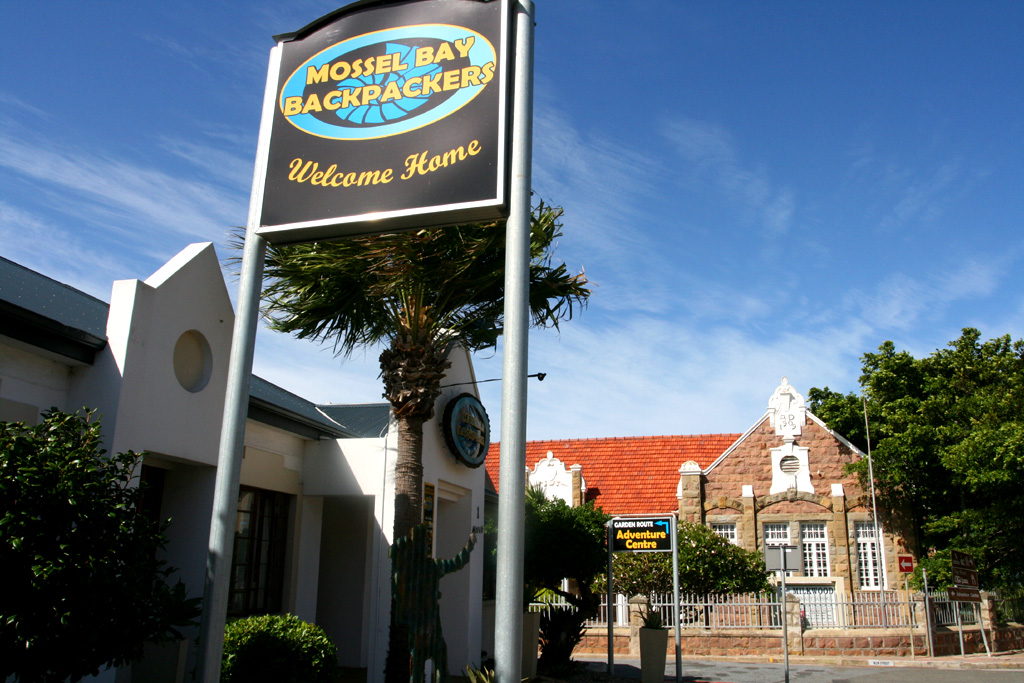
| Arriving at Mosselbay Backpackers
|
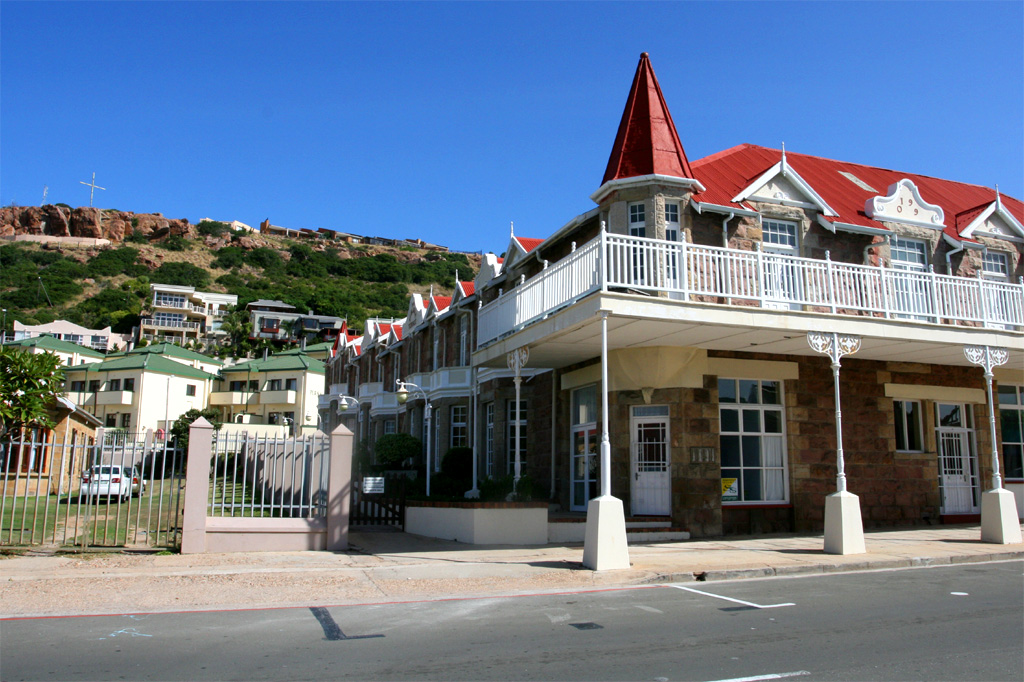
| This is opposite: A nice neighborhood
|
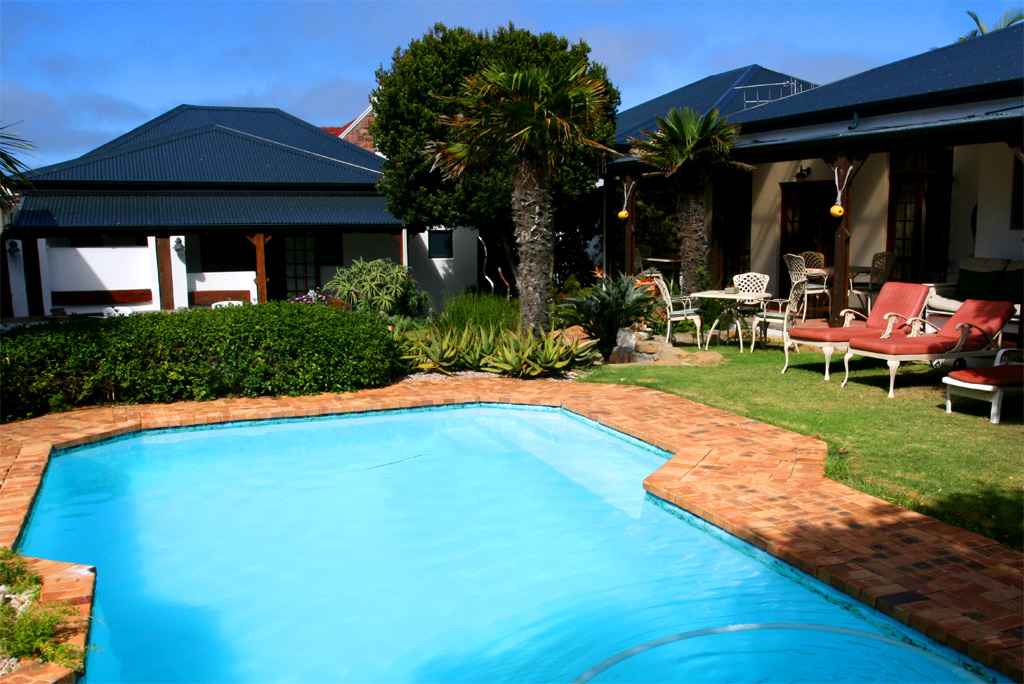
| My room is on the right facing the pool
|
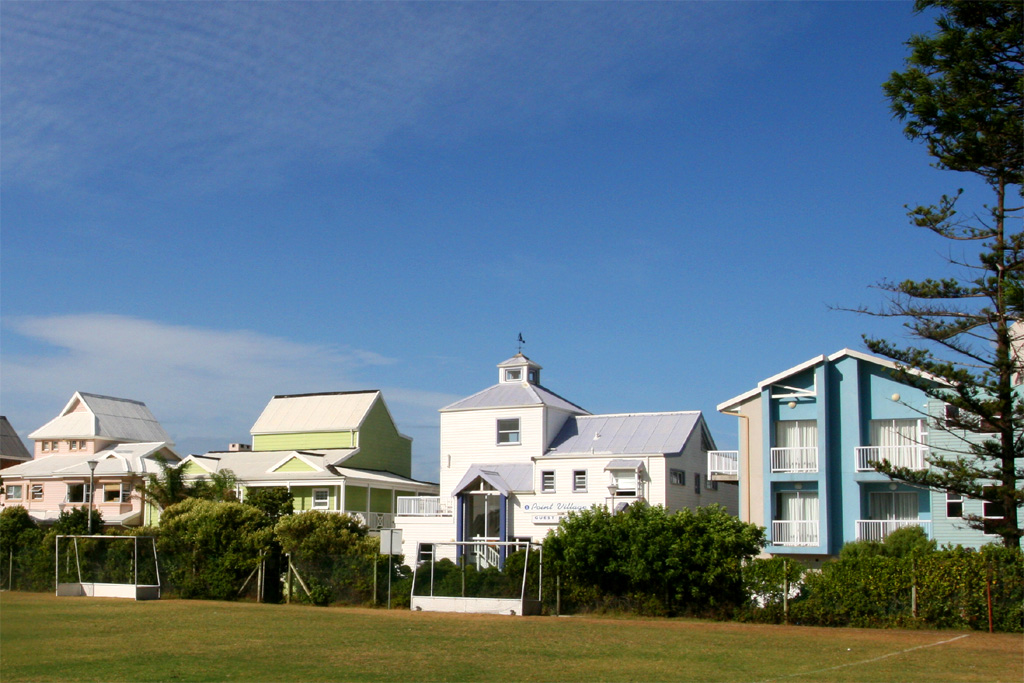
| Passing these houses on the way to the beach
|
If you do not want to relax in the garden or swim in the pool of the hostel, you can walk to the beach in 10 minutes. It's a wonderful place where you can swim, surf, take a sunbath or just walk along the coast and watch the breakwater and surge of the sea.
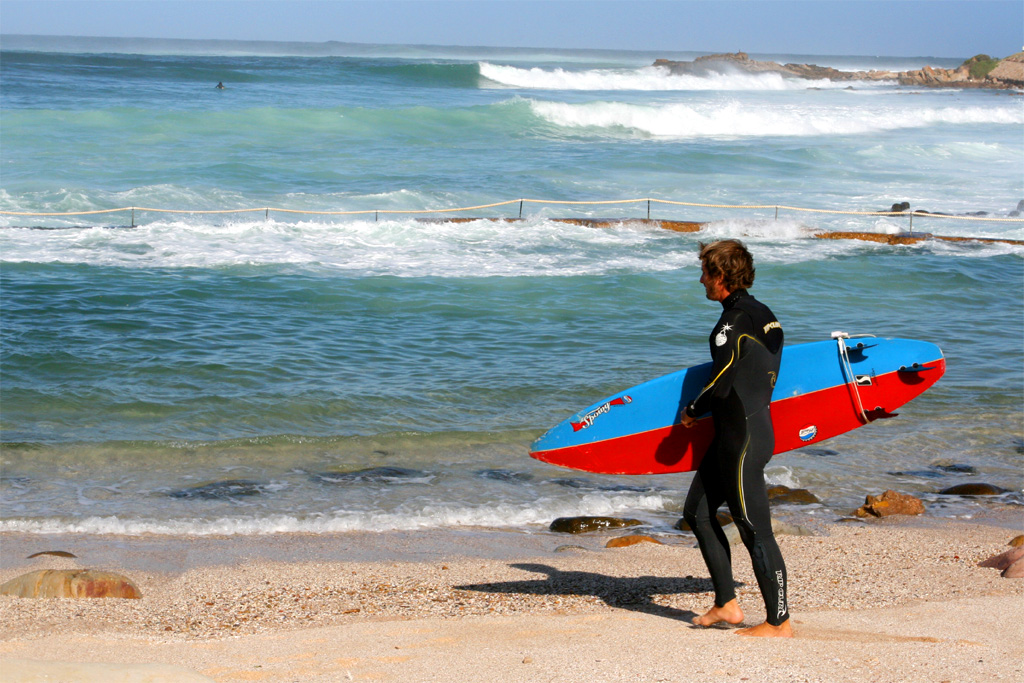
| Here comes a surfer
|
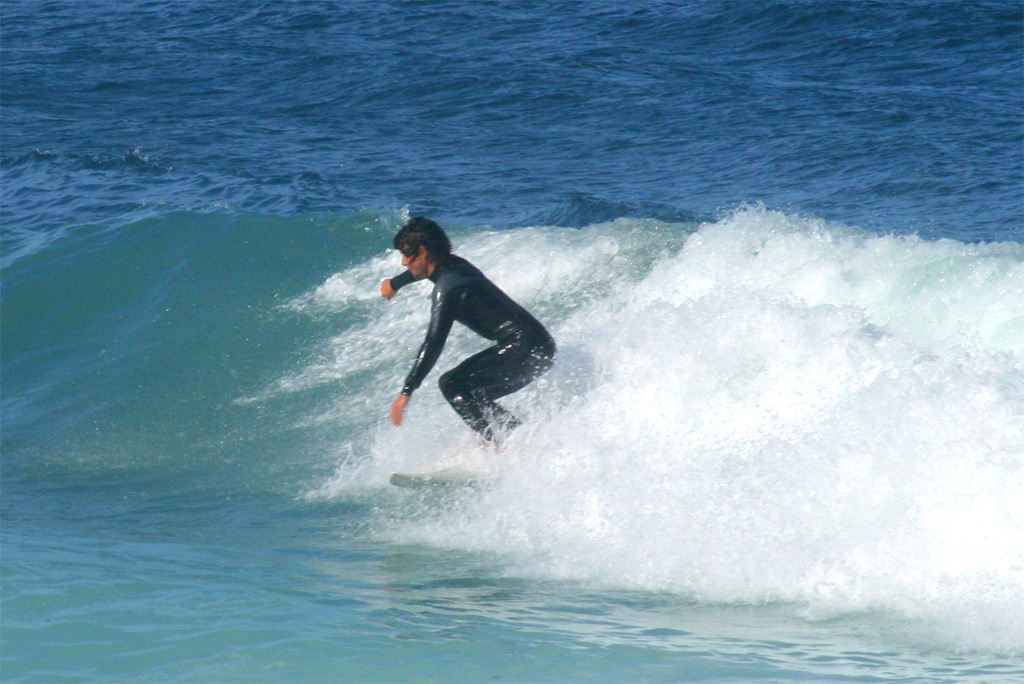
| Another one has already fun
|
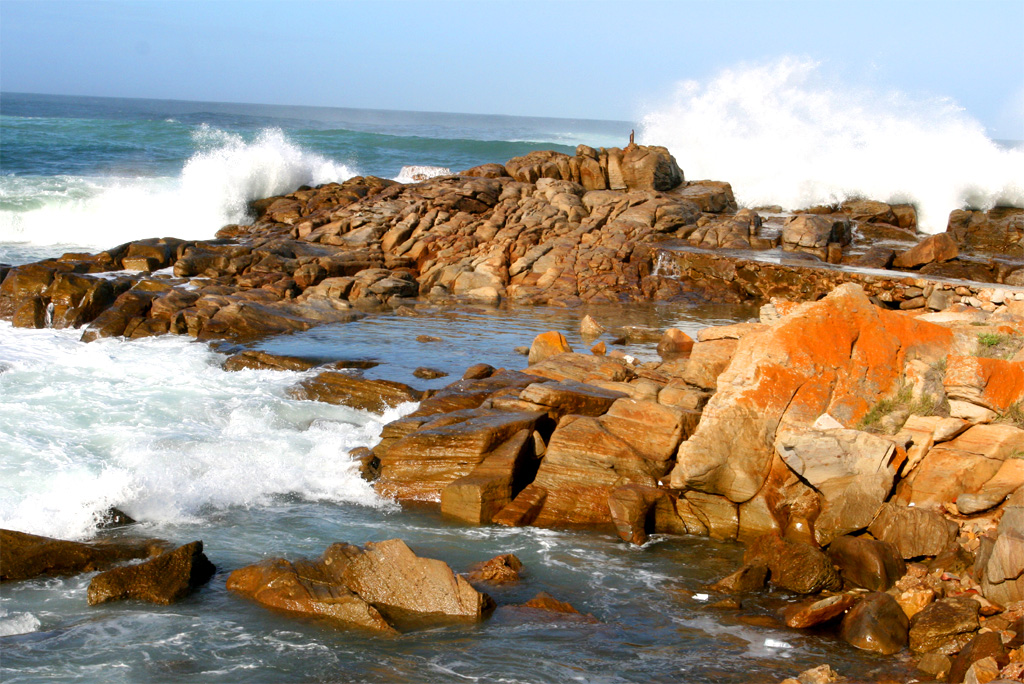
| The sea is rough today
|
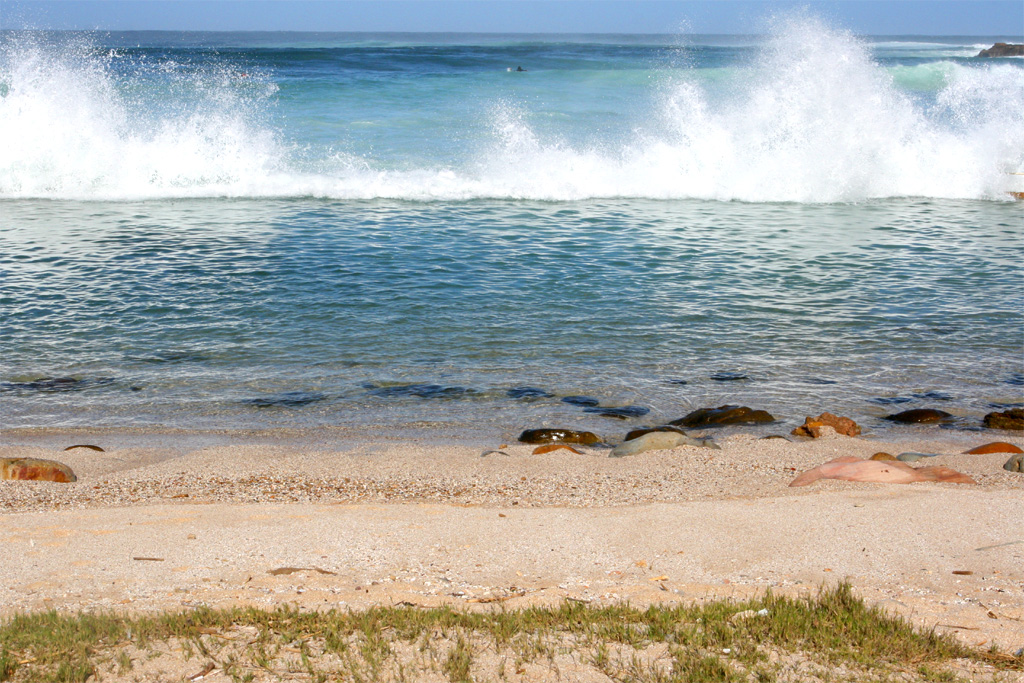
| But here the children could play
|
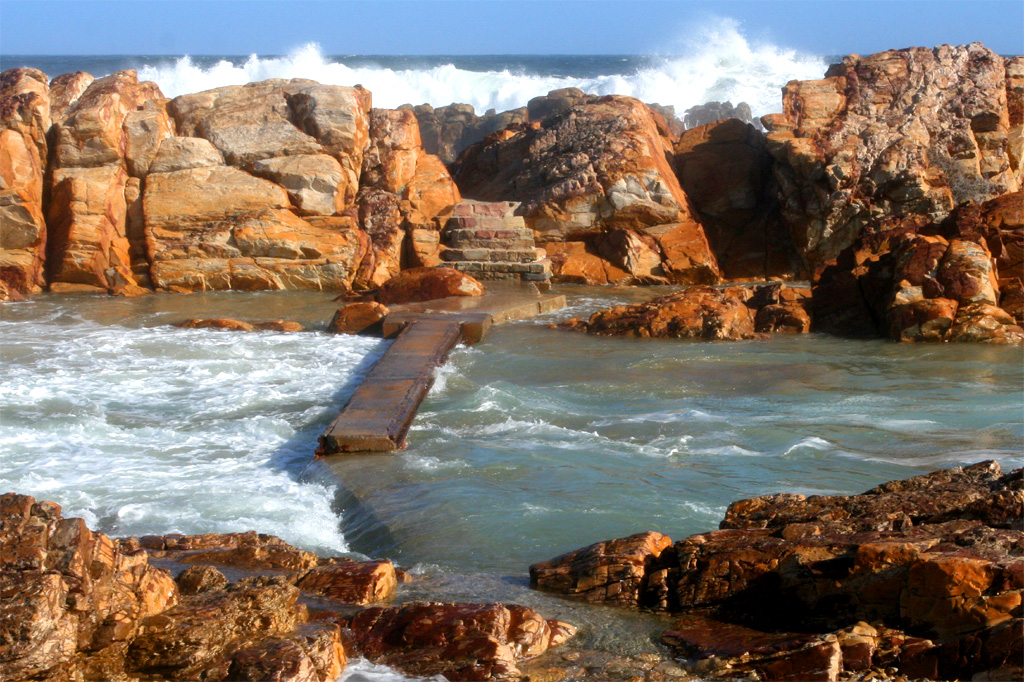
| Here you can walk over the strong current
|
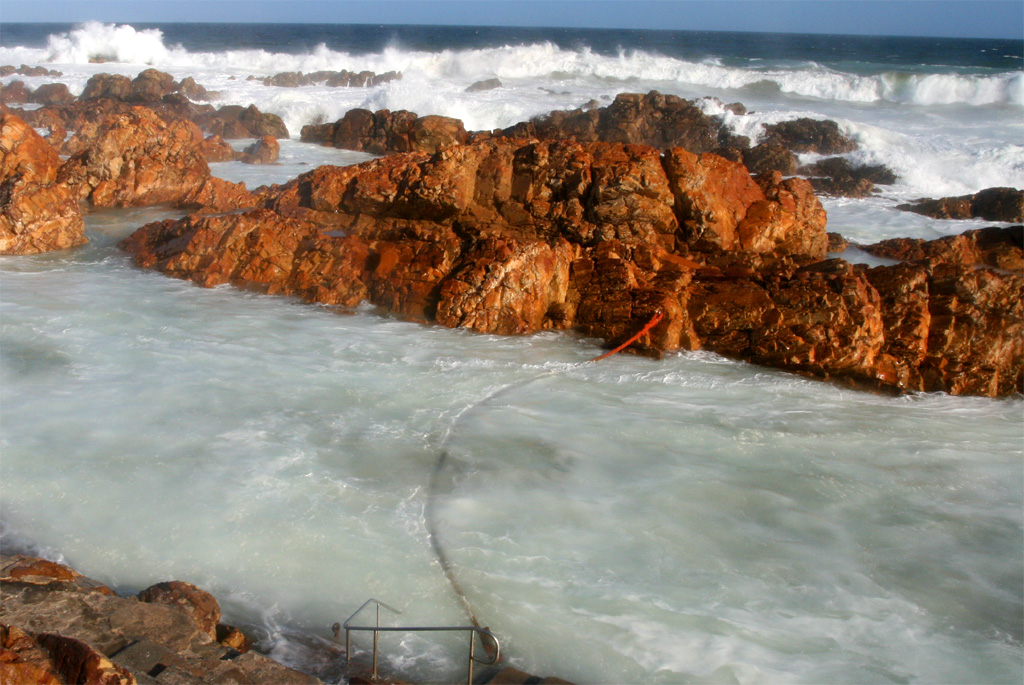
| Here you cannot abseil but "uberseil" the troubled water
|
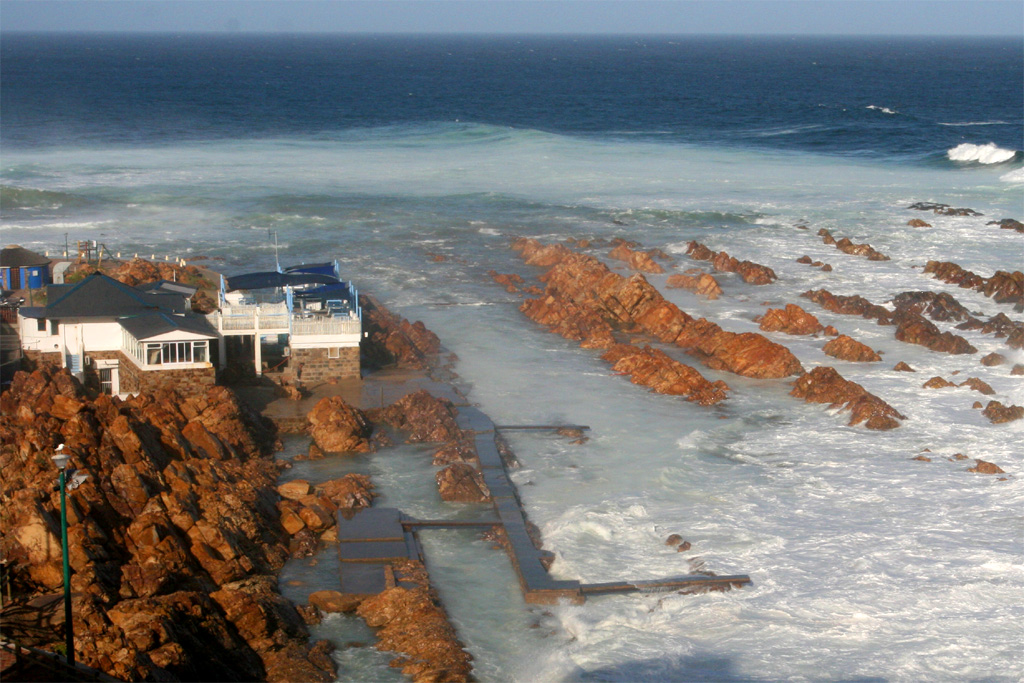
| Here you see the sea from high above
|
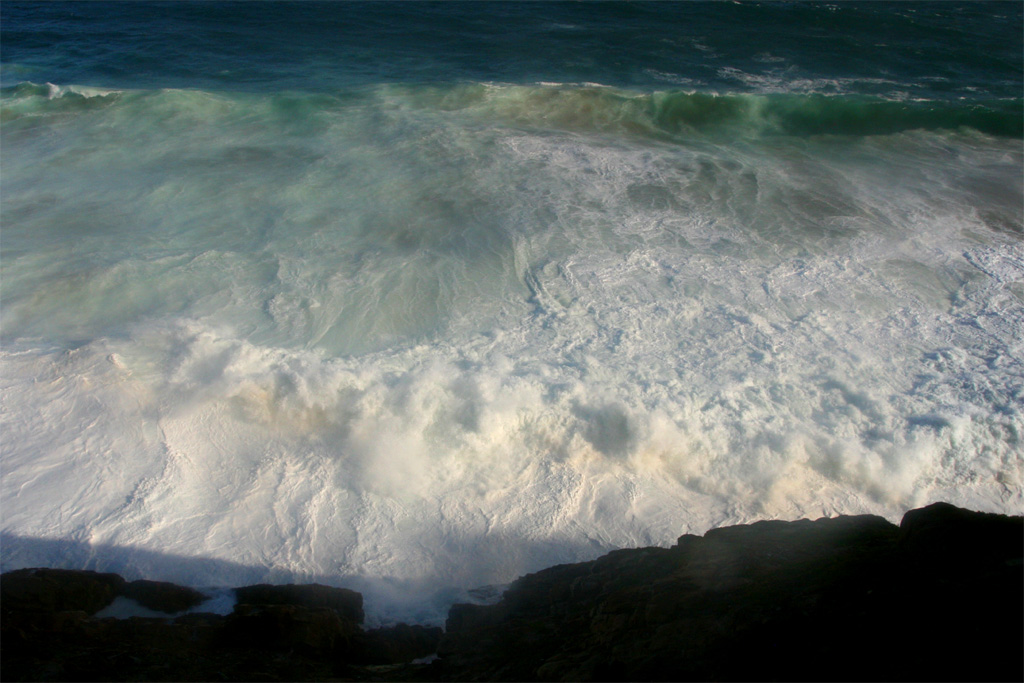
| It's not advisable to jump down here
|
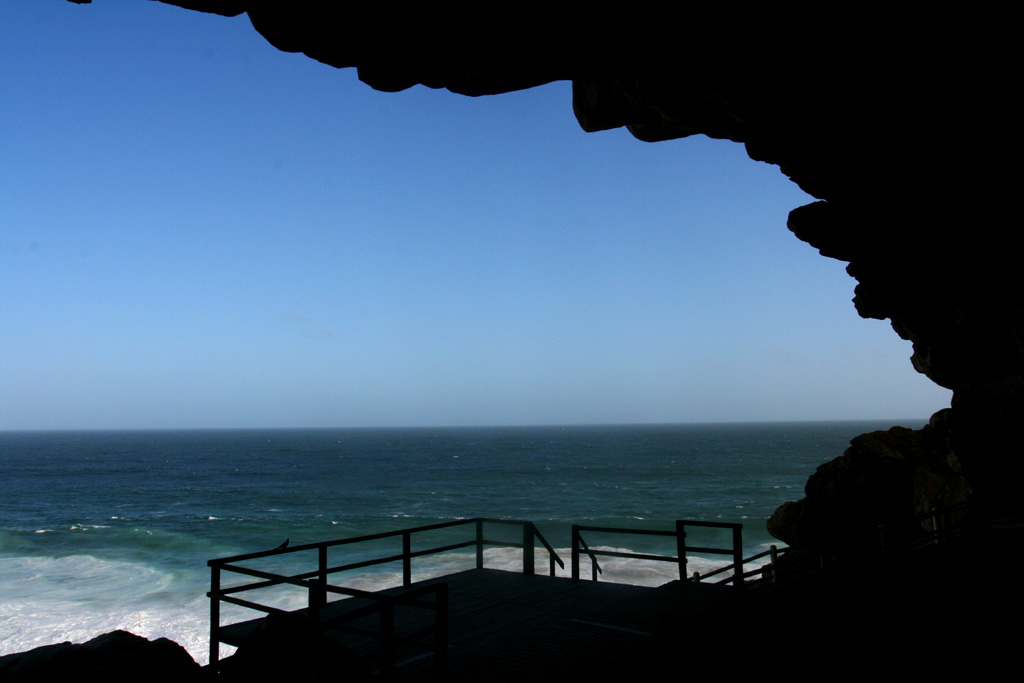
| View out of the St. Blaize Cave
|
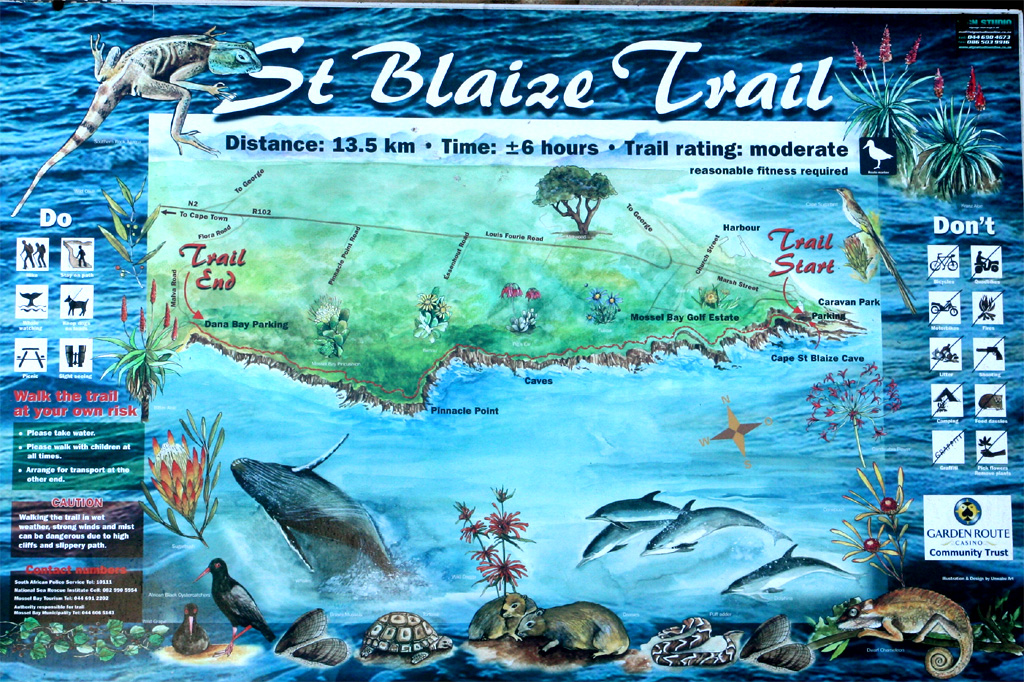
| From here you can walk along the St. Blaize Trail
|
I didn't go on the St. Blaize Trail because I was afraid. When I asked the lady at the tour desk of the Mossel Bay Backpackers whether it is dangerous to walk there or not, fearing slipping tracks with no railing along the cliffs, I did get the answer: Actually not but I can have pepper spray to defend myself in case of an assault. This is another example of the different mindset of the white South Africans, but necessary for survival, I suppose. Europeans still living in Europe are not conditioned to that but someday they will, too.
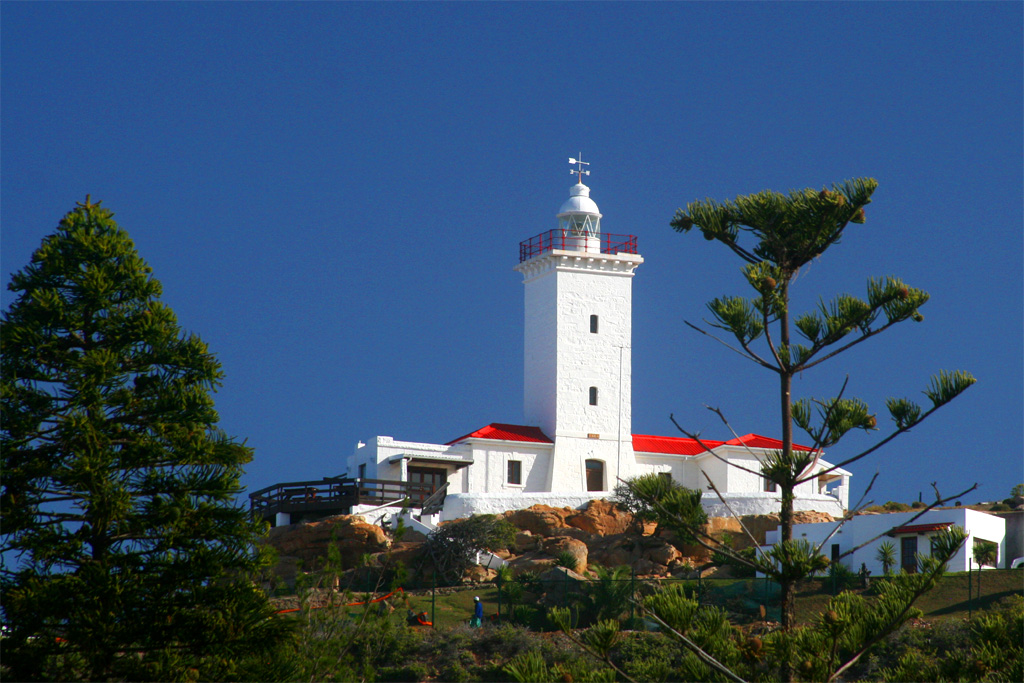
| High above is the light tower
|
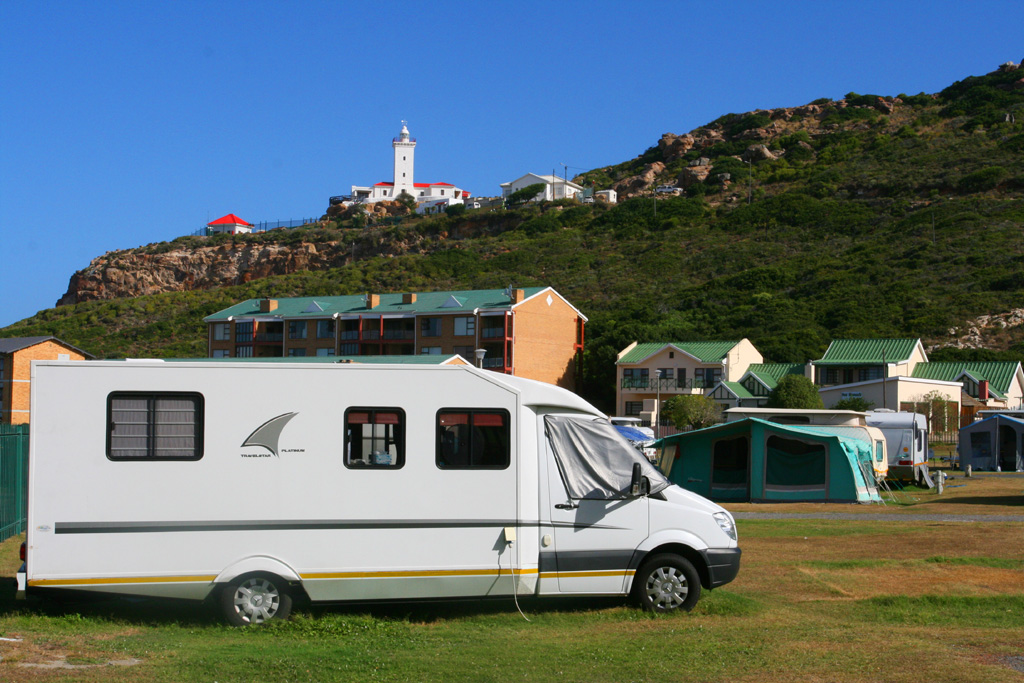
| Down below is a camping ground
|
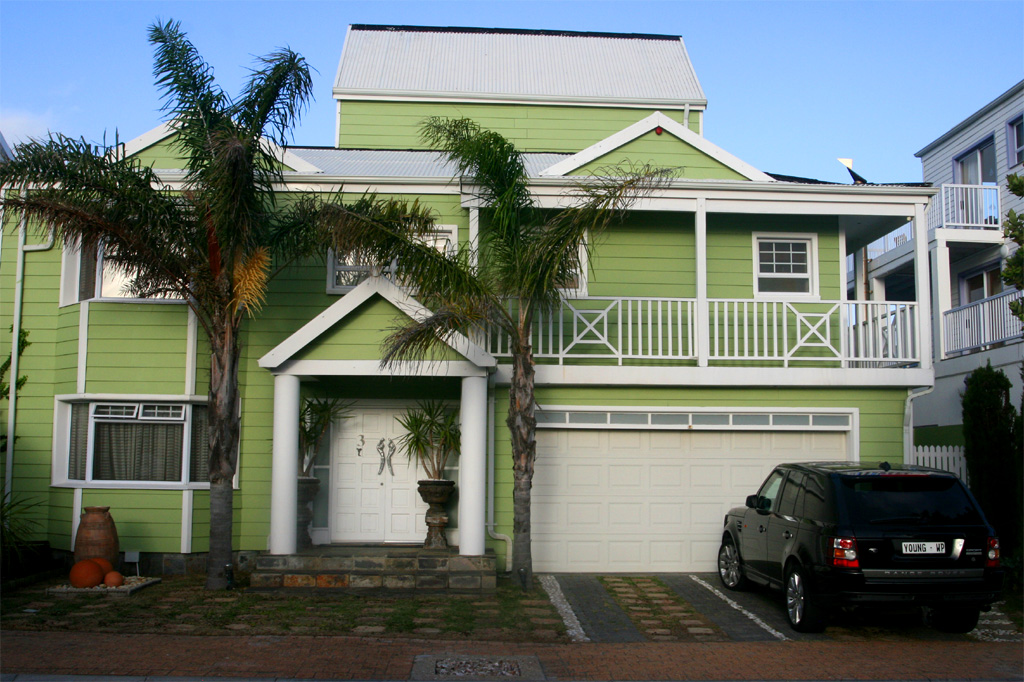
| A beach house is more comfortable
|
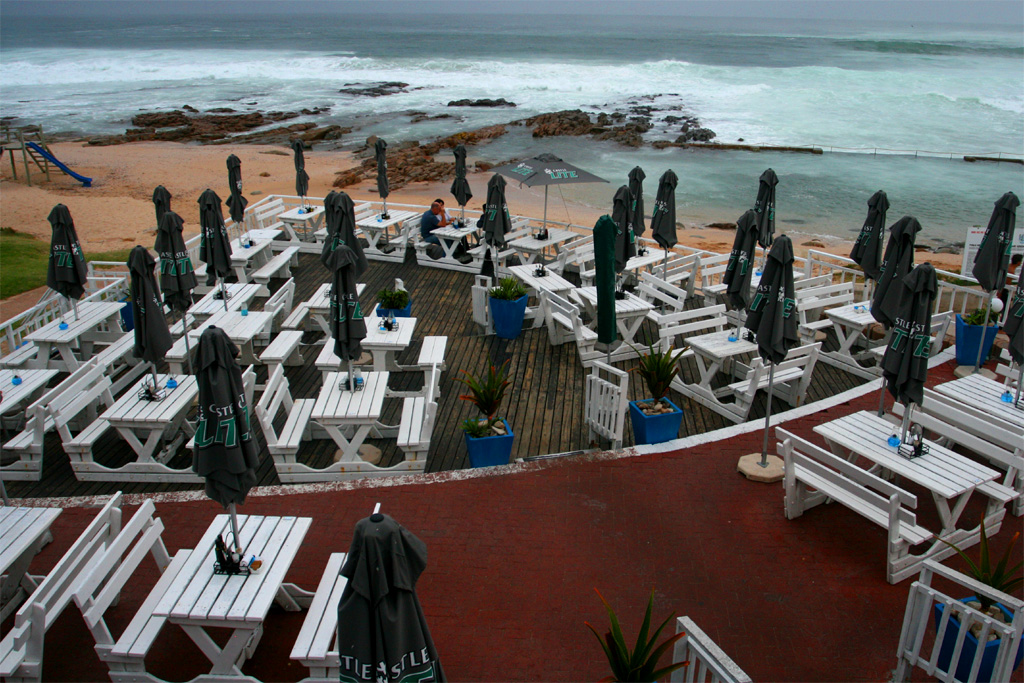
| with a restaurant just around the corner
|
There were actually two restaurants at the sea side front. The Dolphin on the ground floor with the terrace in front, as you can see on the photo, and the Kingfisher on the first floor. Sitting outside in the evening in a strong breeze was not recommended but inside it was cozy with a nice ambience. For me the better one was the Kingfisher with sea food dishes on the menu. The Kingfisher Plate I ordered was big and fantastic. I actually ate it twice, on two different days, of course. The price was 6.00 Euro and the Black Label beer 1.50 Euro and the half a liter wine was 1.70 Euro on the second day. In Europe you would have paid probably four times as much.
Cat Walk Tour
What comes next? There were many tours offered. I was interested in a "Meet the People" tour, which comprises private home visits with traditional meals. But unfortunately that tour was fully booked. So what else? I decided for a catwalk. Not with fashion model ladies but with real wild cats: lions, actually only a male and no females. It was a pity that the ladies were too hot right now. Might have been good for the lion king but too dangerous for us. With us I mean my companion Eric from New York and I.
This once in a life time experience was offered by the
Botlierskop Day Safaris,
just a 25 minutes drive from Mossel Bay. The lady from the tour desk of our Mossel Bay Backpackers did the booking for us, which did cost 37.00 Euro per person. The van to get there was another 15.00 Euro. That's a little more expensive than other tours, but it has to be considered that only up to two tours were conducted a day and for less people than the six rangers, who accompanied us. They were carrying long wooden clubs or sticks to protect us, just in case the lion becomes aggressive. We were also supplied with these sticks to be able to also defend ourselves. Ok, then let's catwalk.
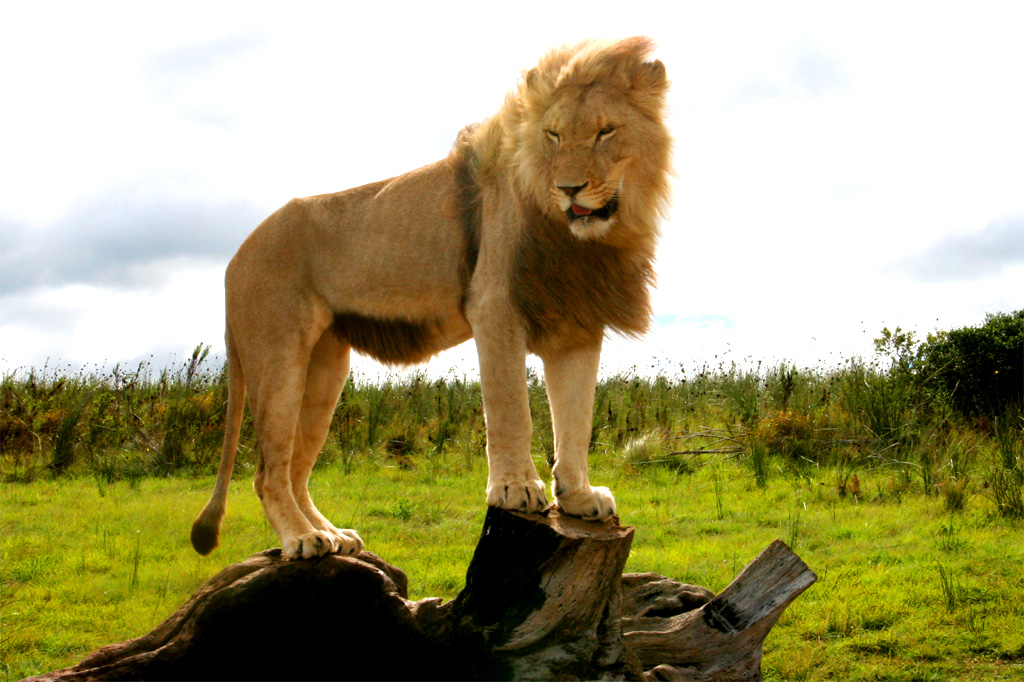
| Our lion is waiting for us
|
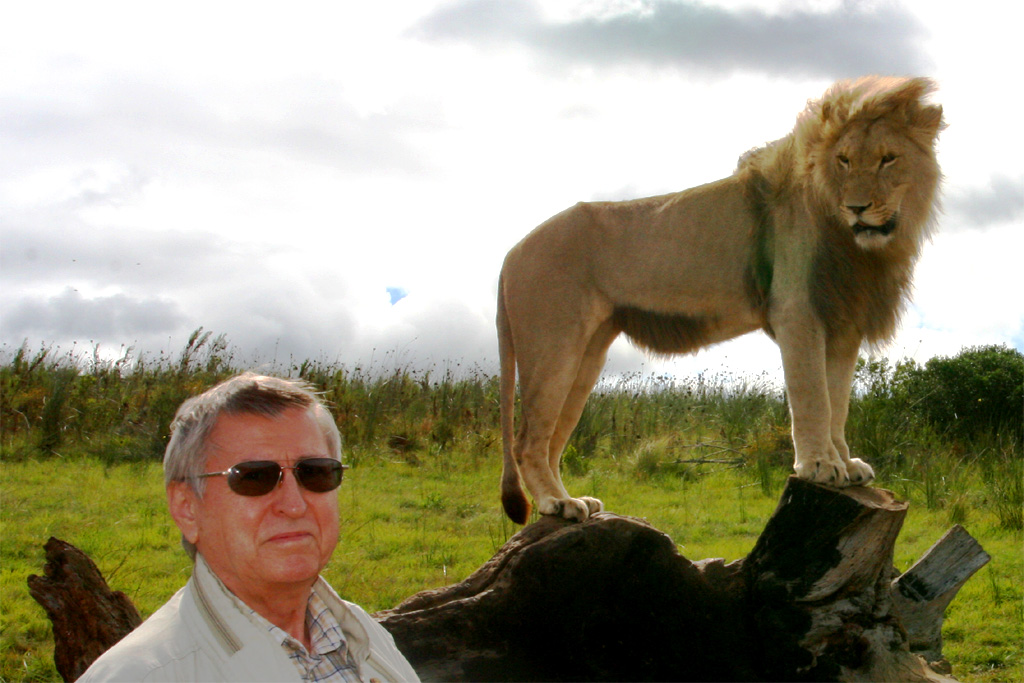
| I hope he is not hungry
|
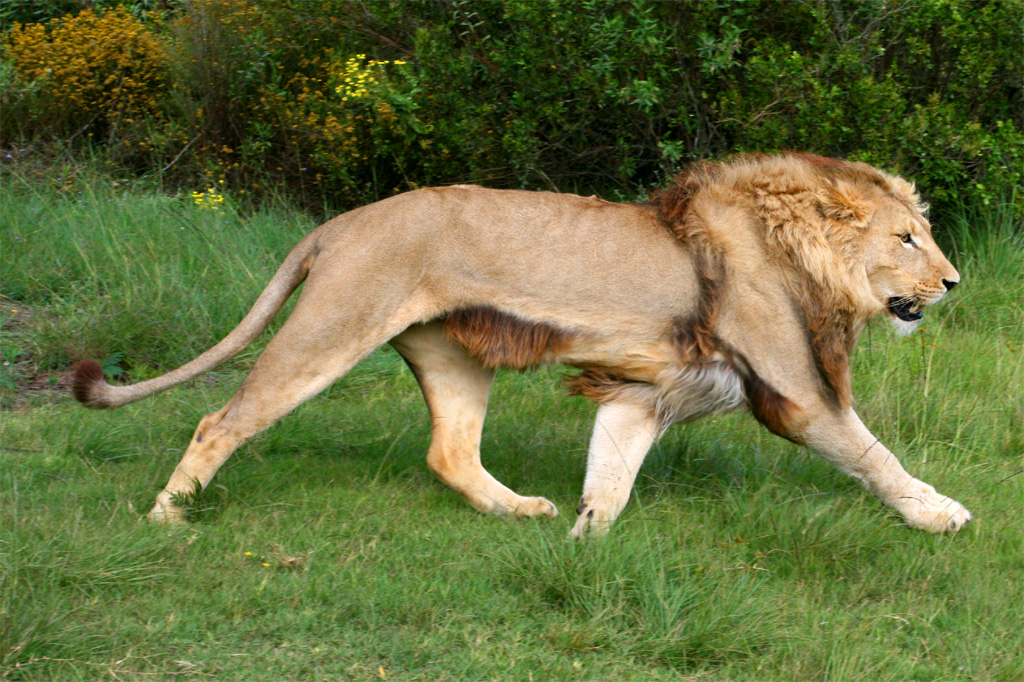
| Our lion is leading the way
|
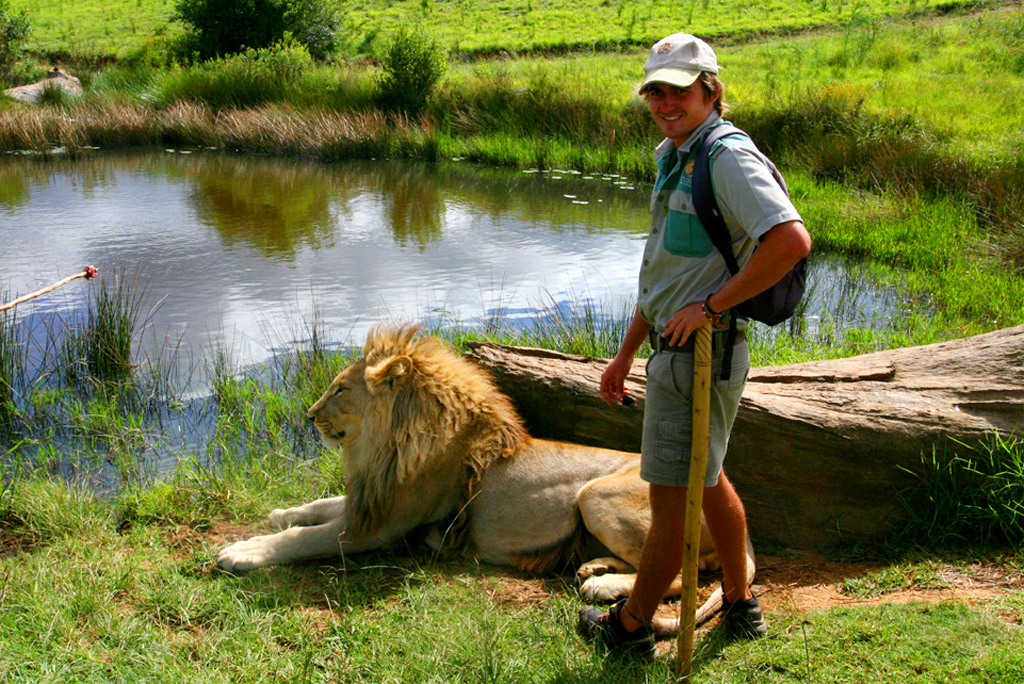
| always being watched by his/our guides
|
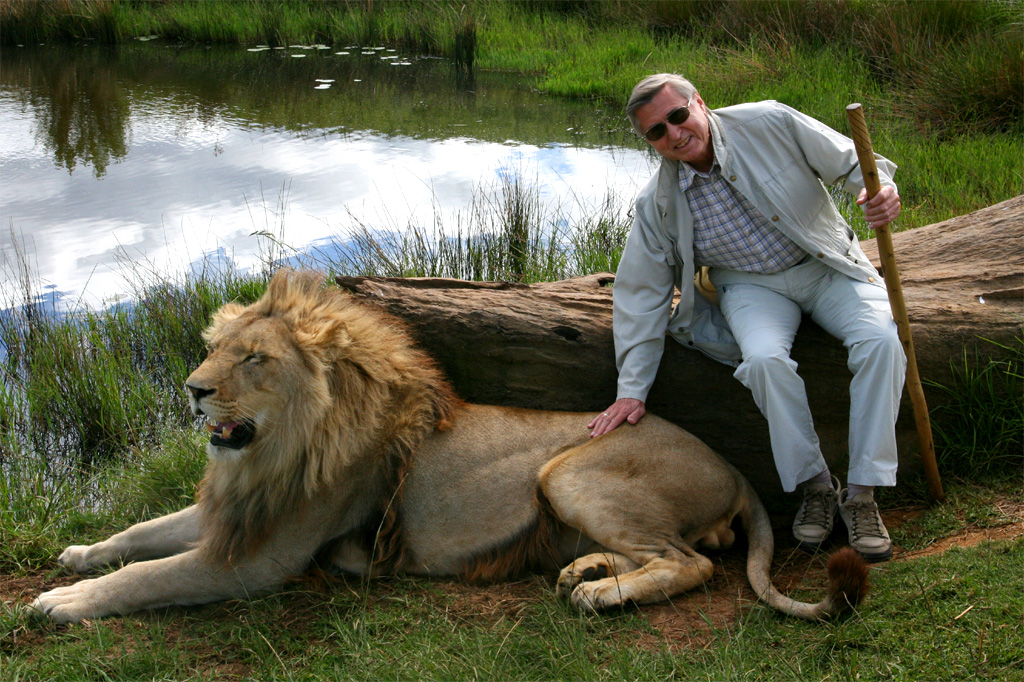
| My lion is a good boy, I am pleased
|
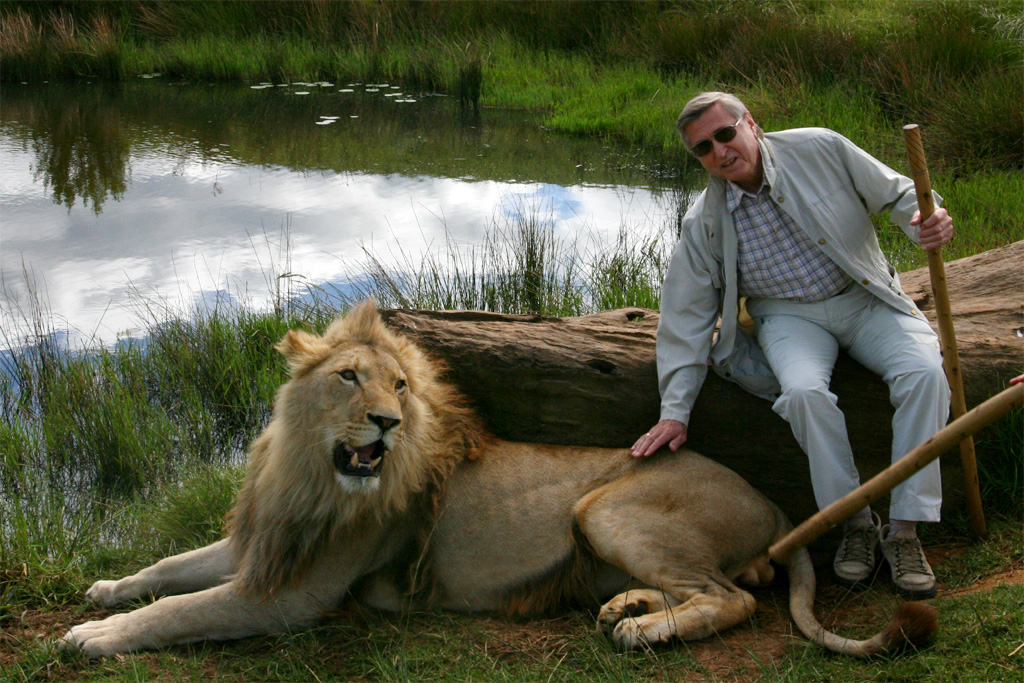
| Though, he doesn't like his balls to be squeezed
|
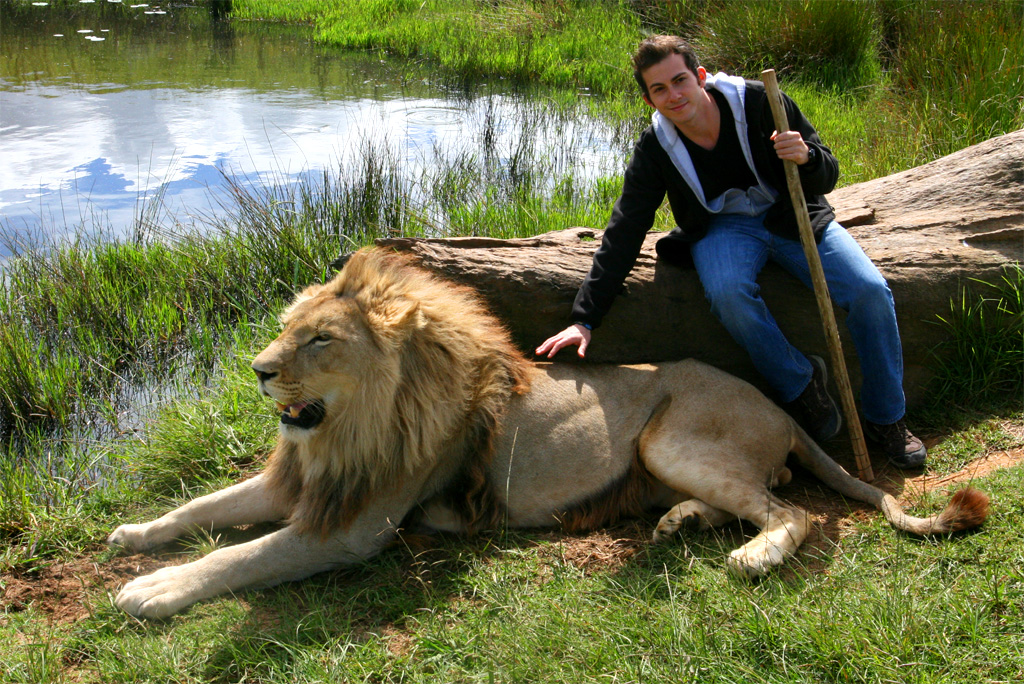
| Eric's turn to stroke the lion
|
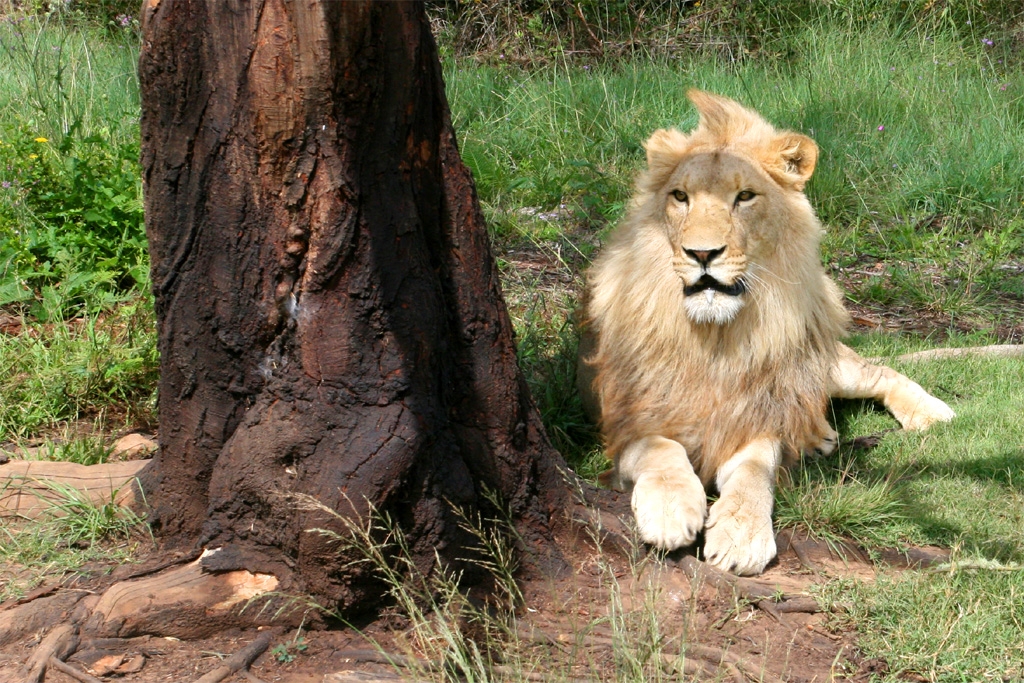
| What is he waiting for now
|
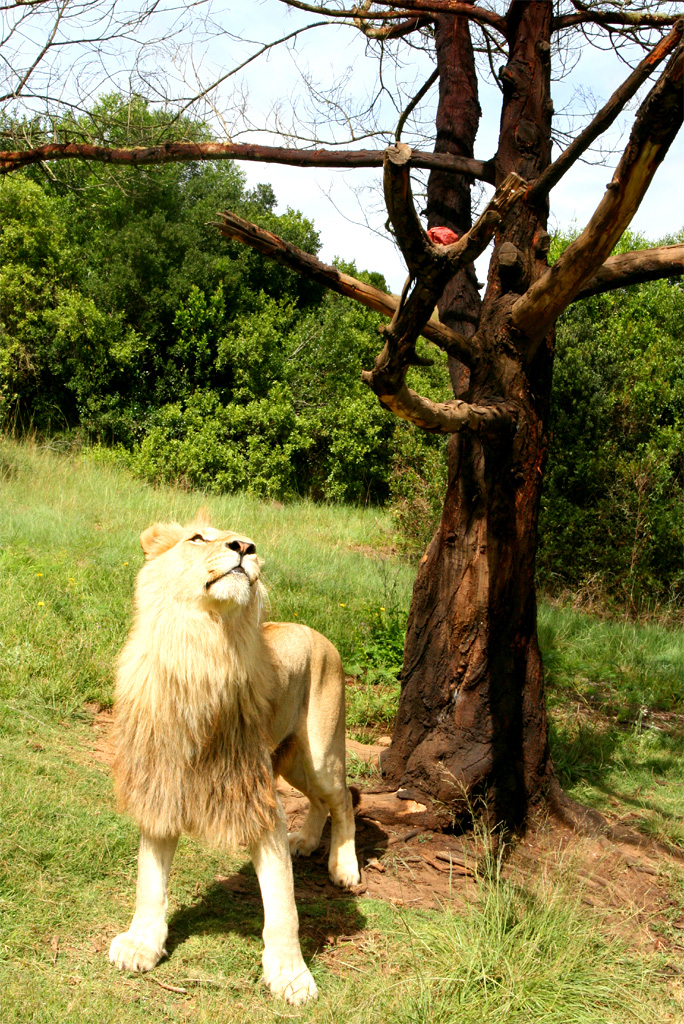
| He is waiting for his treat
|
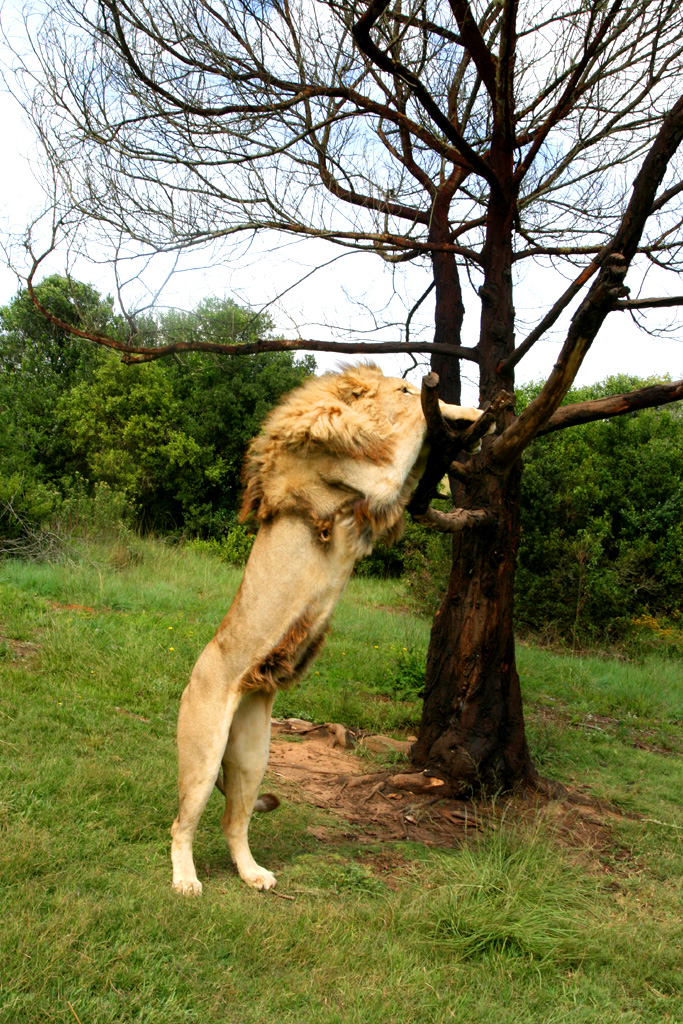
| which is a piece of meat
|
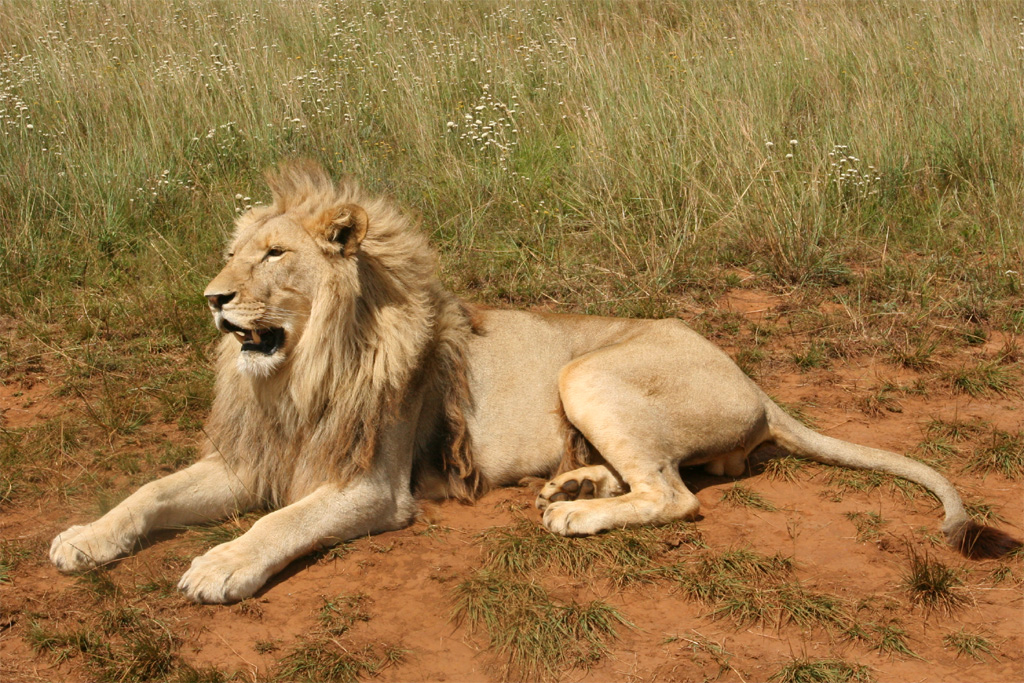
| Then he needs to rest
|
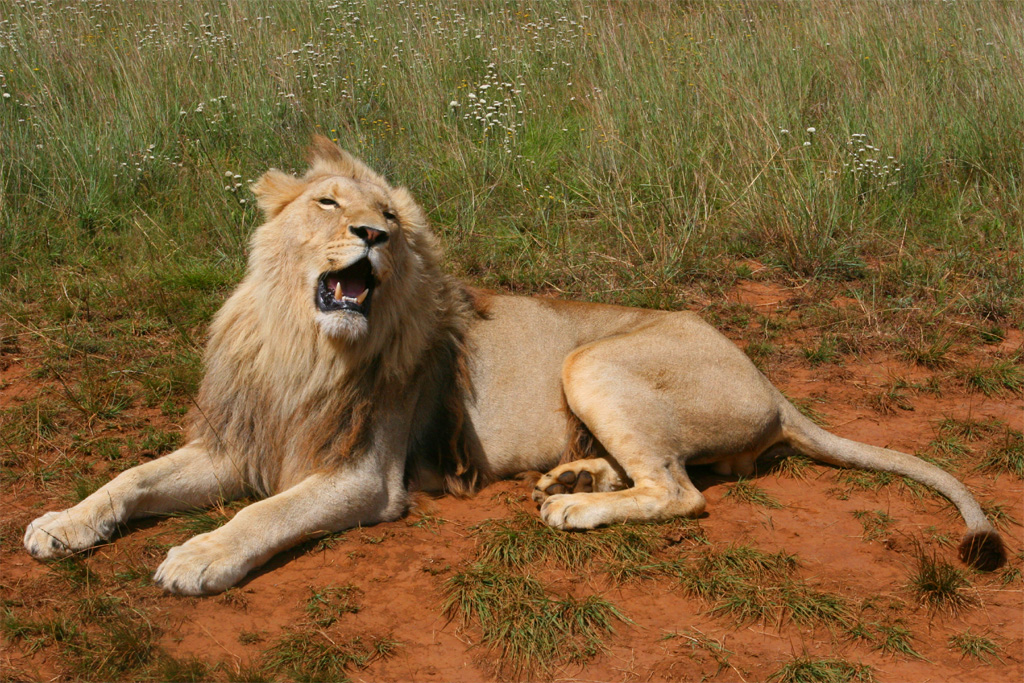
| Is that yawning or roaring?
|
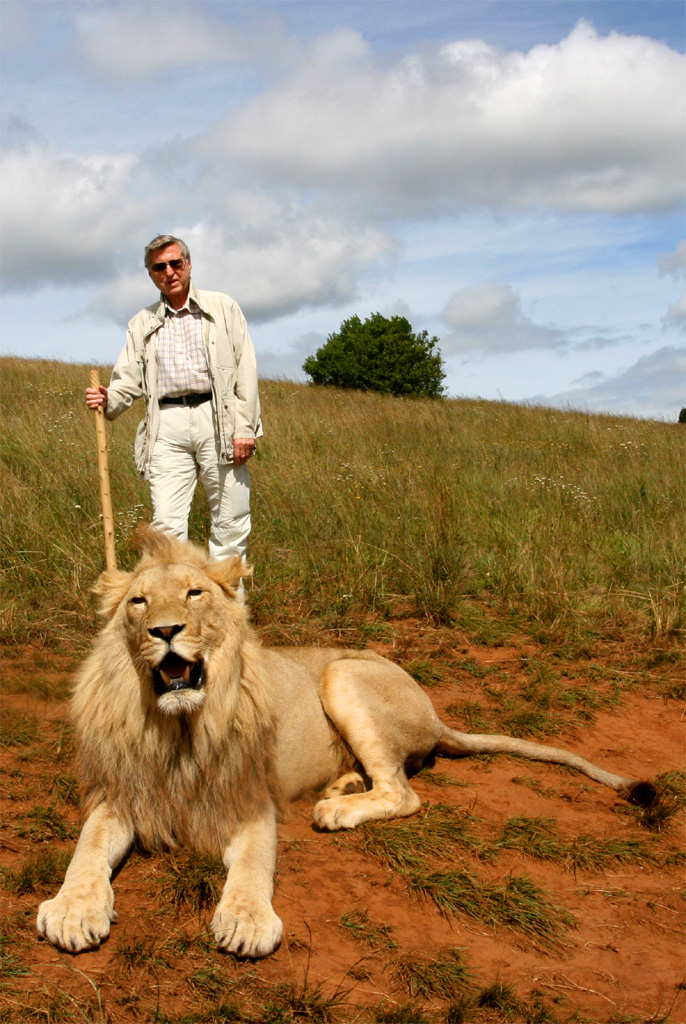
| Come on, get up
|
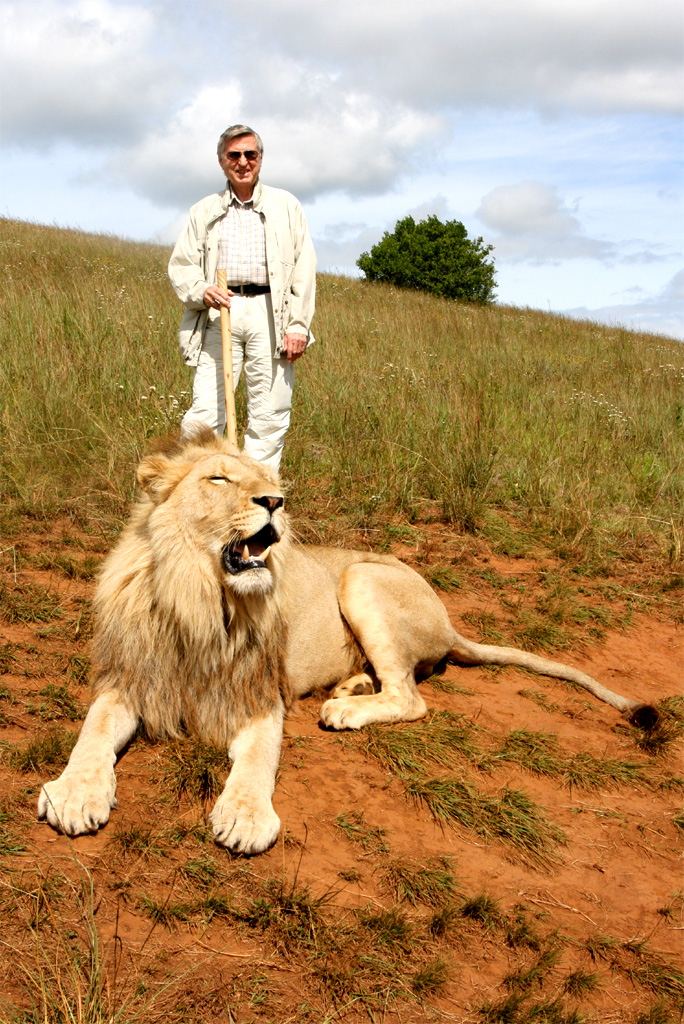
| Let's catwalk again
|
We almost walked one hour. The lion seemed to know his way and knew where he was rewarded with a 'filet mignon'. So he was already very well conditioned but not tamed. He still has an instinct to kill. Children are not allowed to catwalk and we were told not to bend down otherwise the lion feels superior and thinks you are prey.
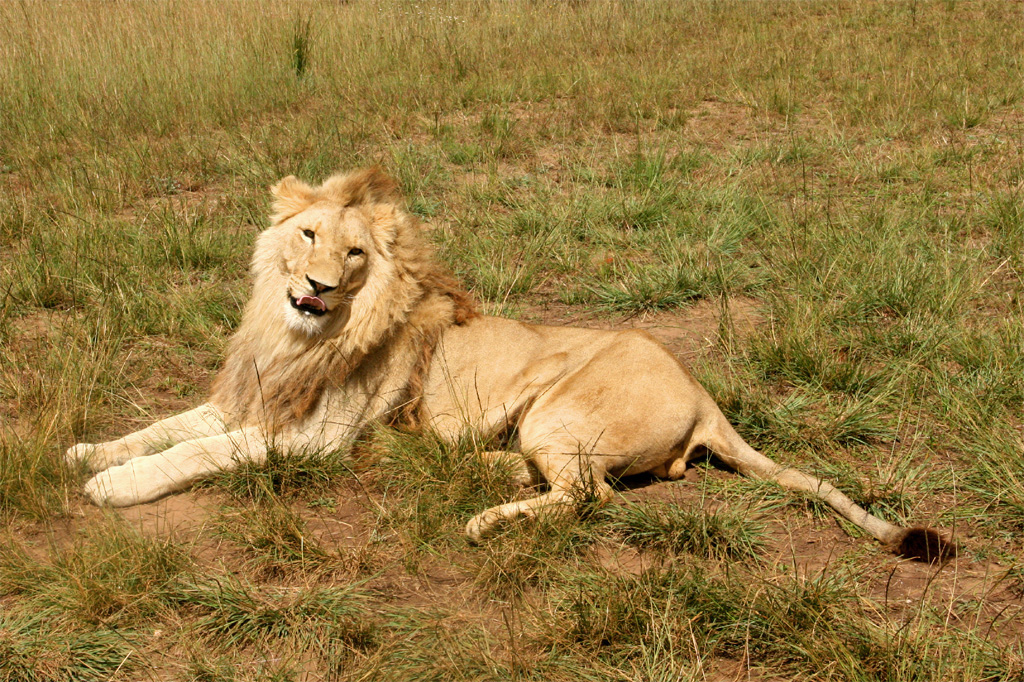
| Doesn't he look cute and funny and a little bit shy
|
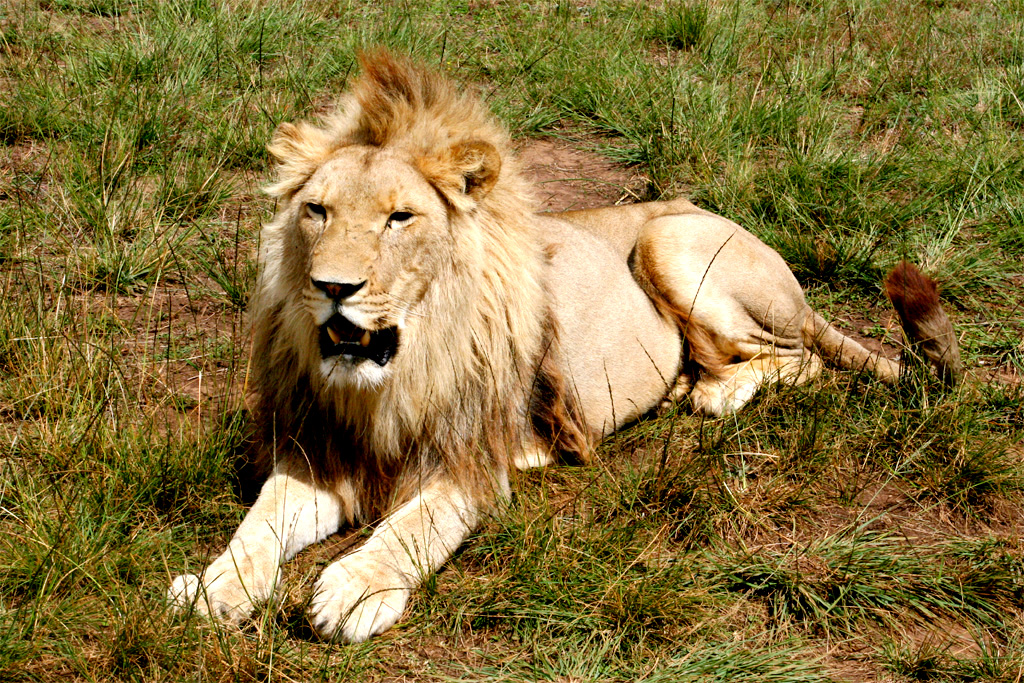
| But now he seems to be sad because we had to say good bye
|
Back to Mossel Bay I was hungry like a lion. I had to eat something quickly. I went to the Café Havana in the middle of Marsh Street and ordered a big Feta-Avocado-Beef- Burrita for 3.40 Euro. Then what next?
One of the reasons why I also wanted to come to Mossel Bay was to see a replica of the caravel, the São Cristóvão, of the Portuguese Bartolomeu Dias. He was the first to sail around the southern tip of Africa in the year 1488. The same trip from Lisbon to Mossel Bay with a replica of that ship was done in 1988 to commemorate the 500th anniversary. Dias wanted to find a way to India. He was on the right track but had to sail back from Mossel Bay (which he called Saint Blaize), because his crew refused to go any further. Look up the internet, if you want to know more.
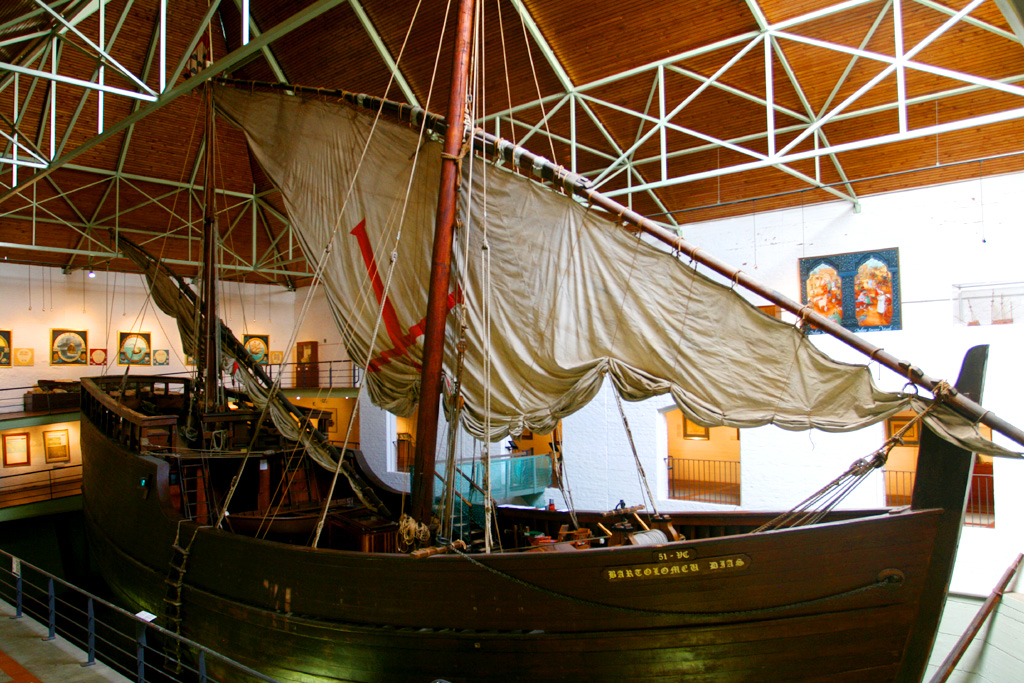
| Dias' ship: The São Cristóvão
|
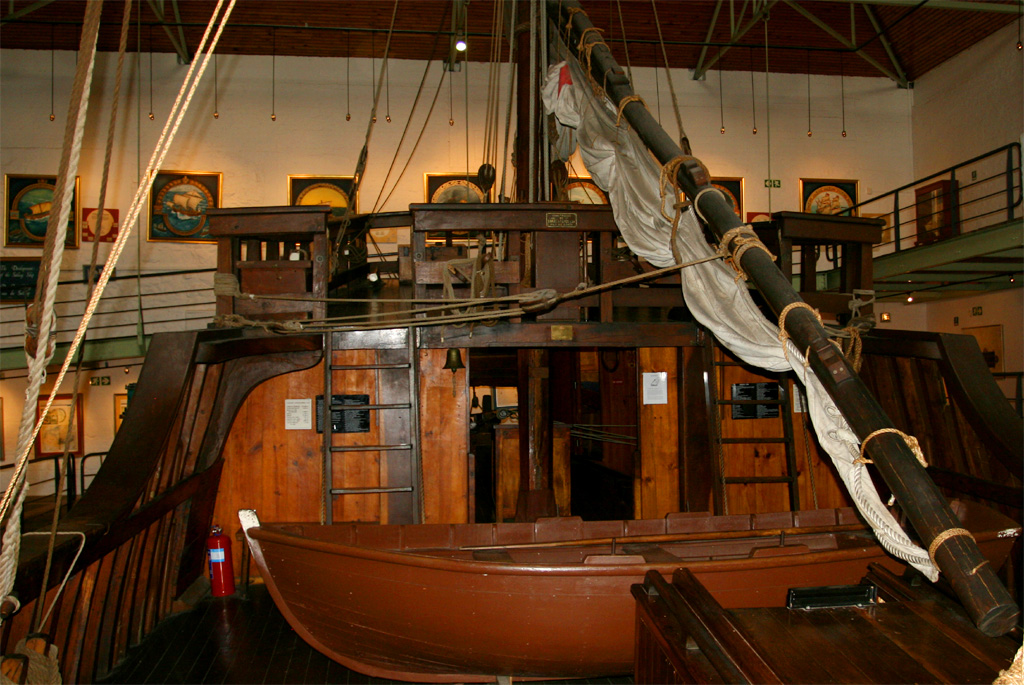
| The afterdeck
|
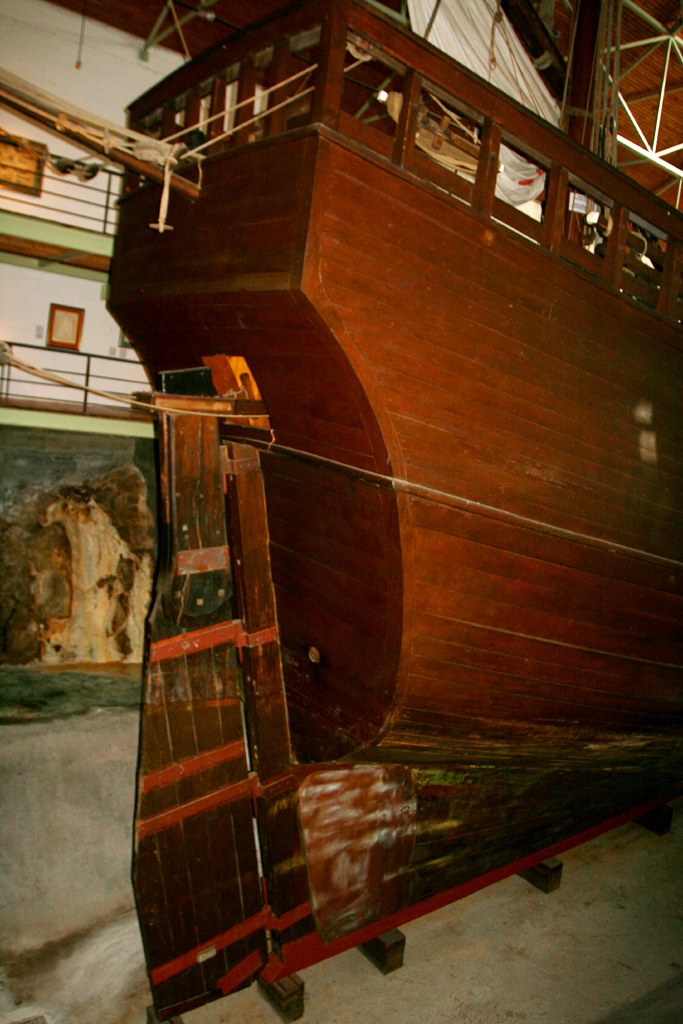
| The rudder
|
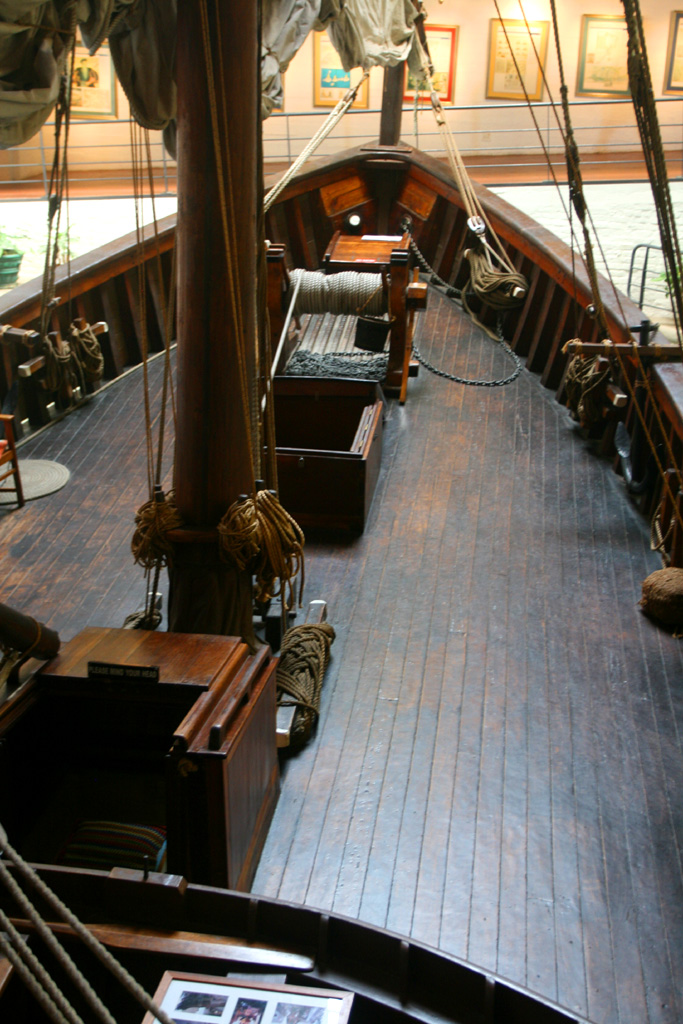
| The foredeck
|
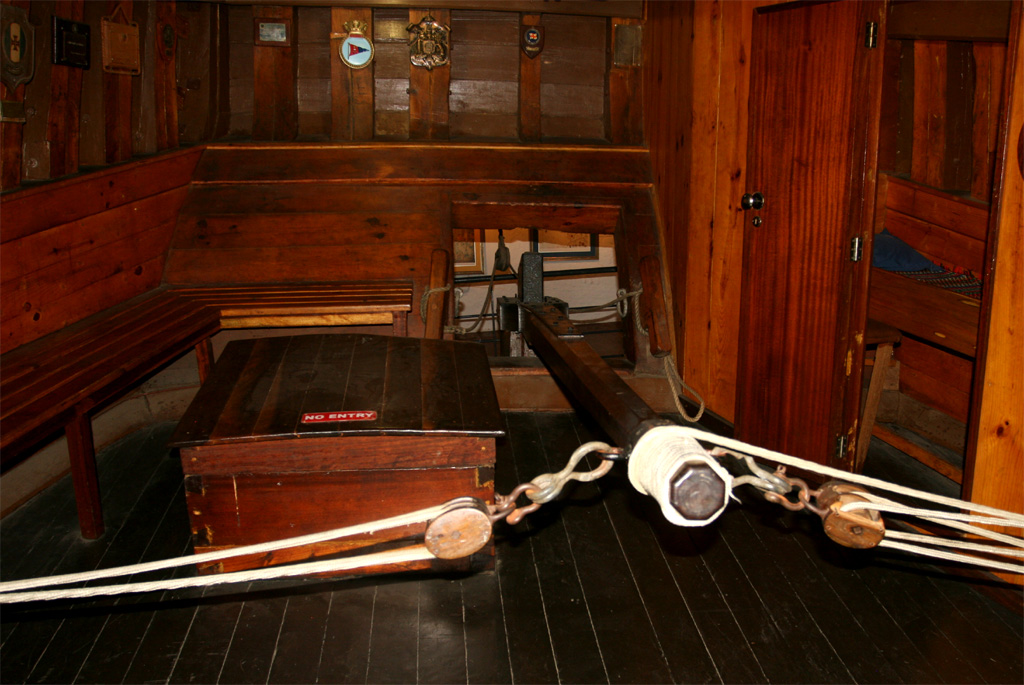
| The tiller
|
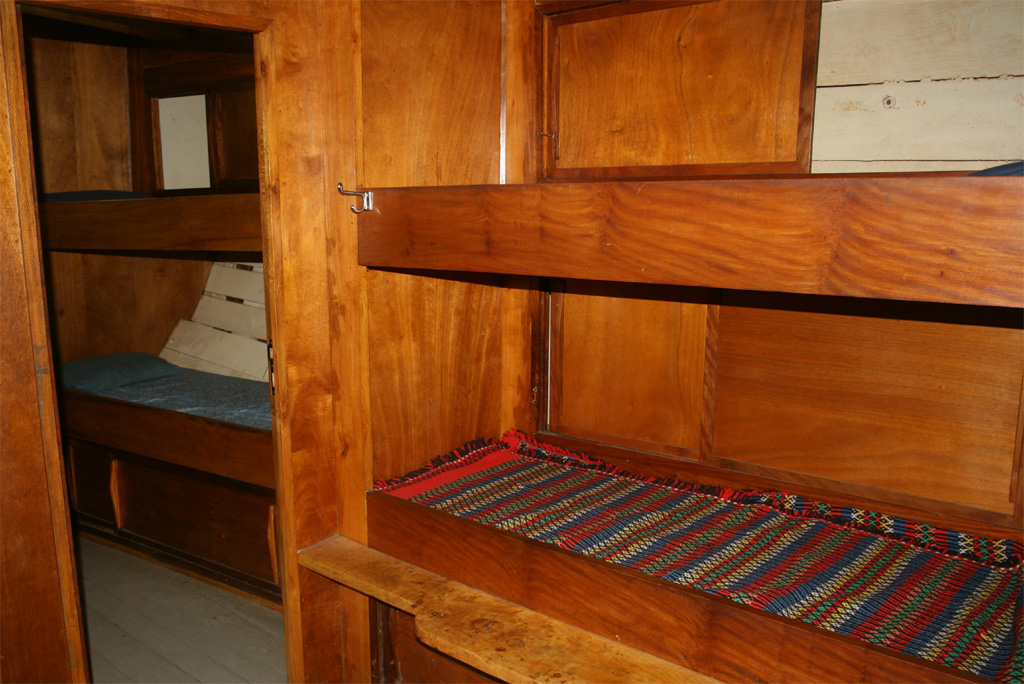
| The berth
|
The only changes to the original ship were the toilet and the kitchen to make the journey a little more comfortable than it was 500 years ago.
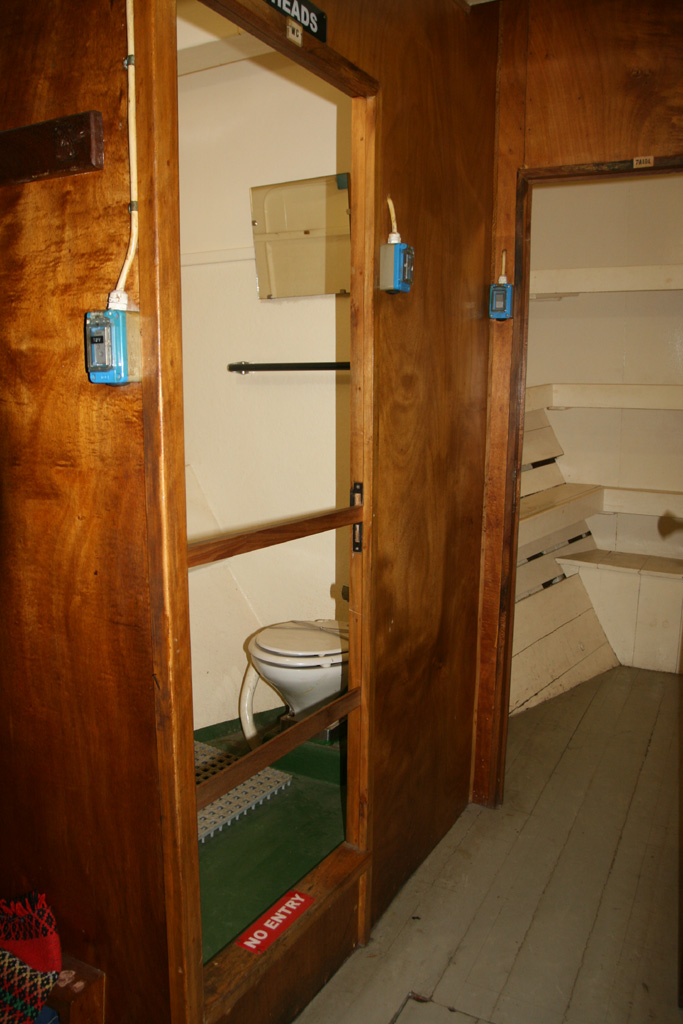
| Modern toilet, not the head
|
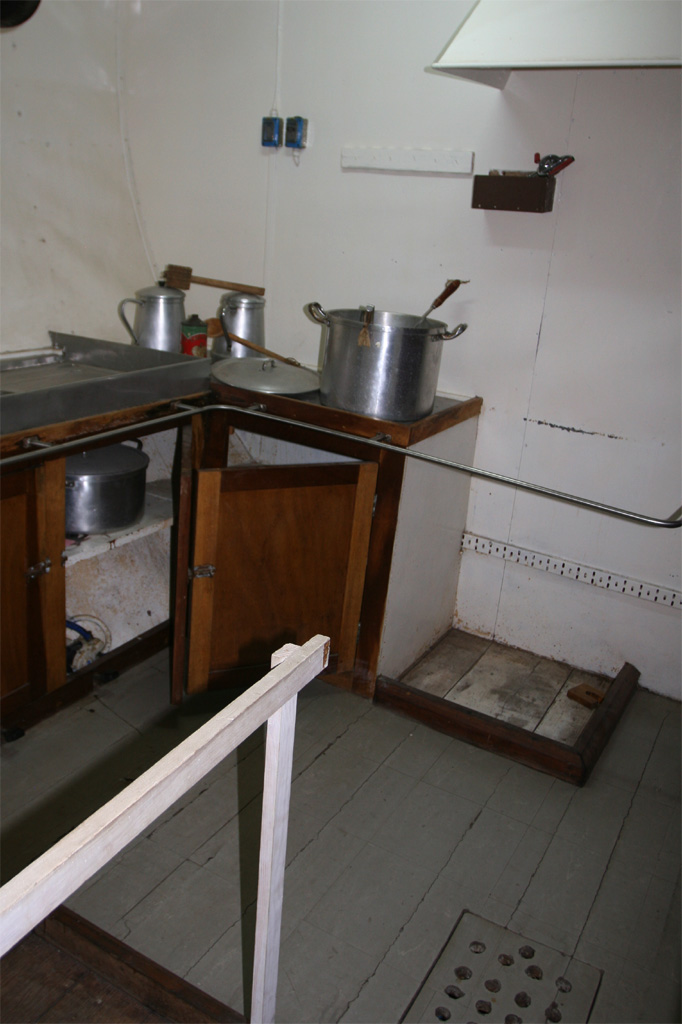
| Modern kitchen, not the galley
|
The museum built around the ship was very interesting with a lot of artefacts from the old days. There was much more to see and to read. So don't miss it when you should come to Mossel Bay. The entrance fee including boarding the caravel was only 2.70 Euro.
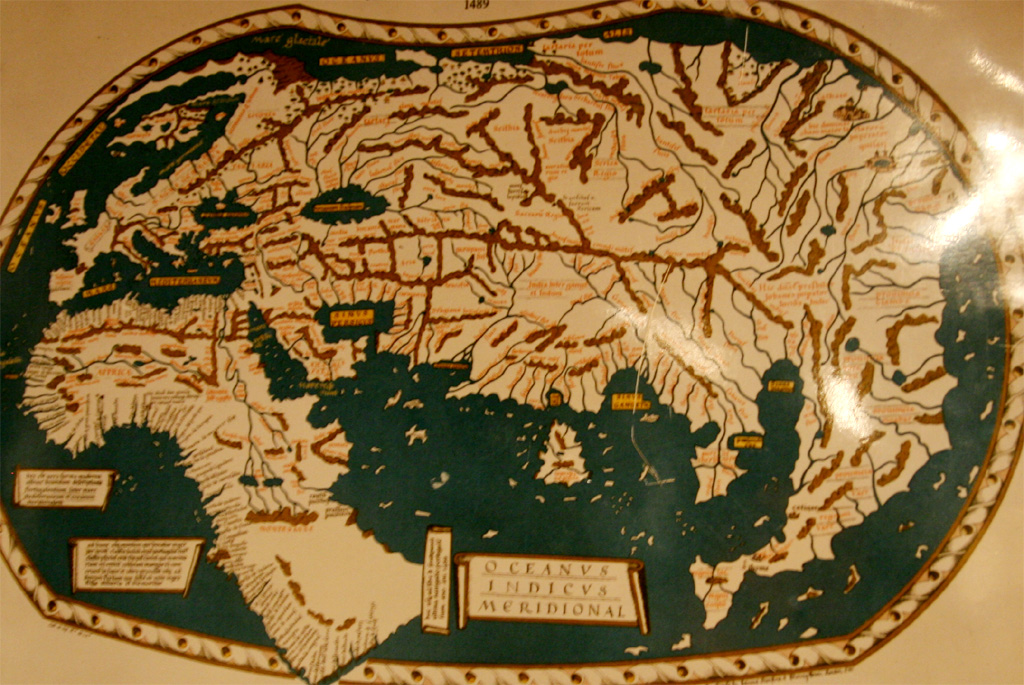
| Very old map of the world
|
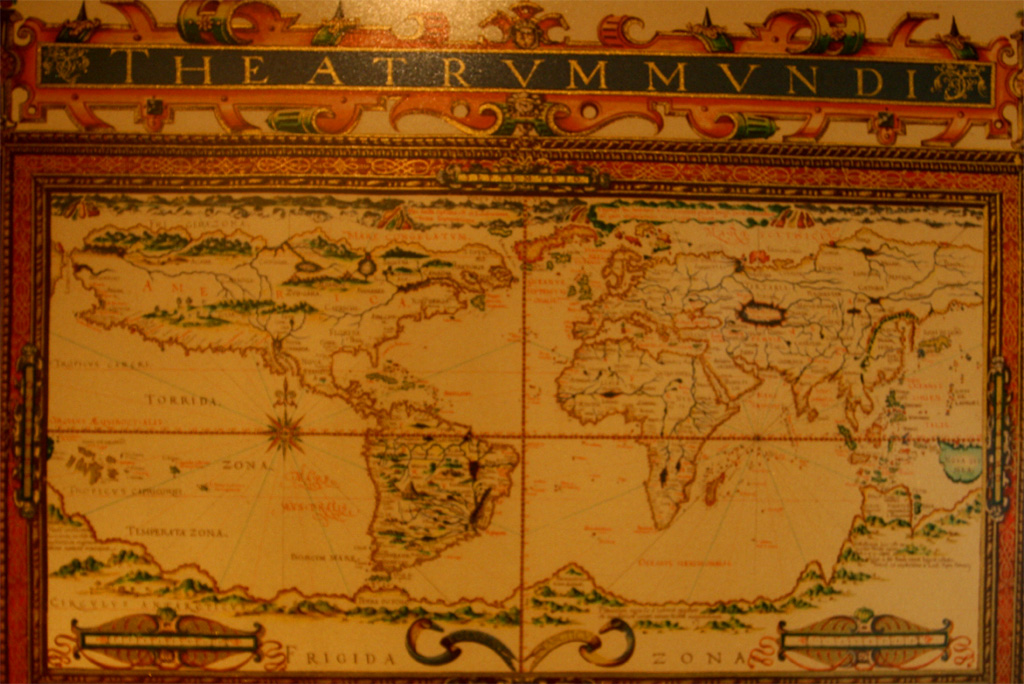
| A newer map of the world
|
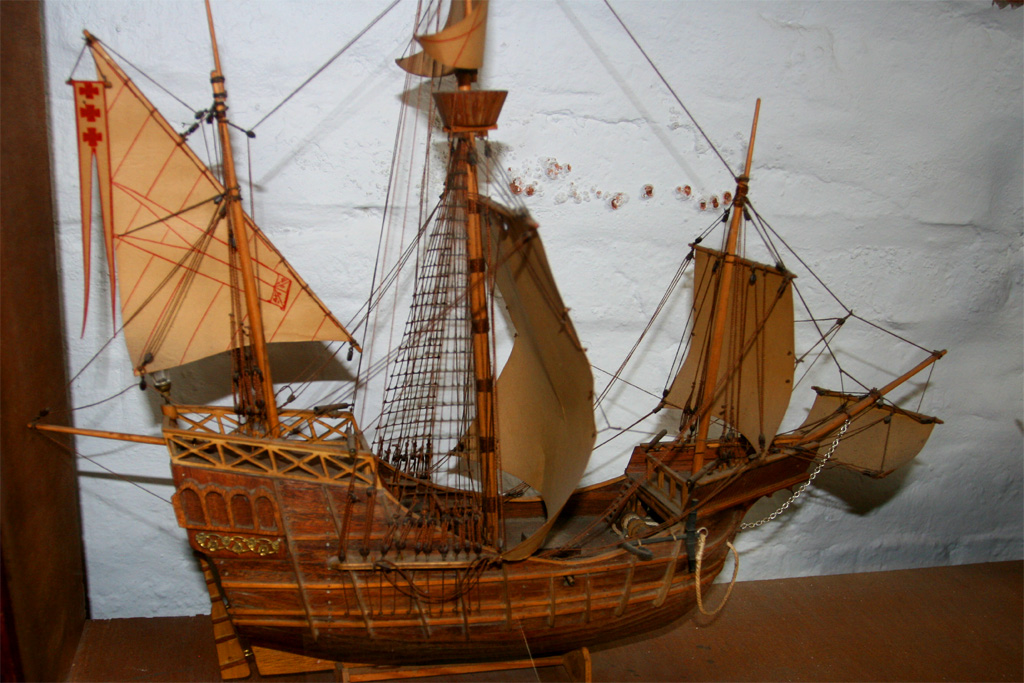
| A later than Dias' caravel
|
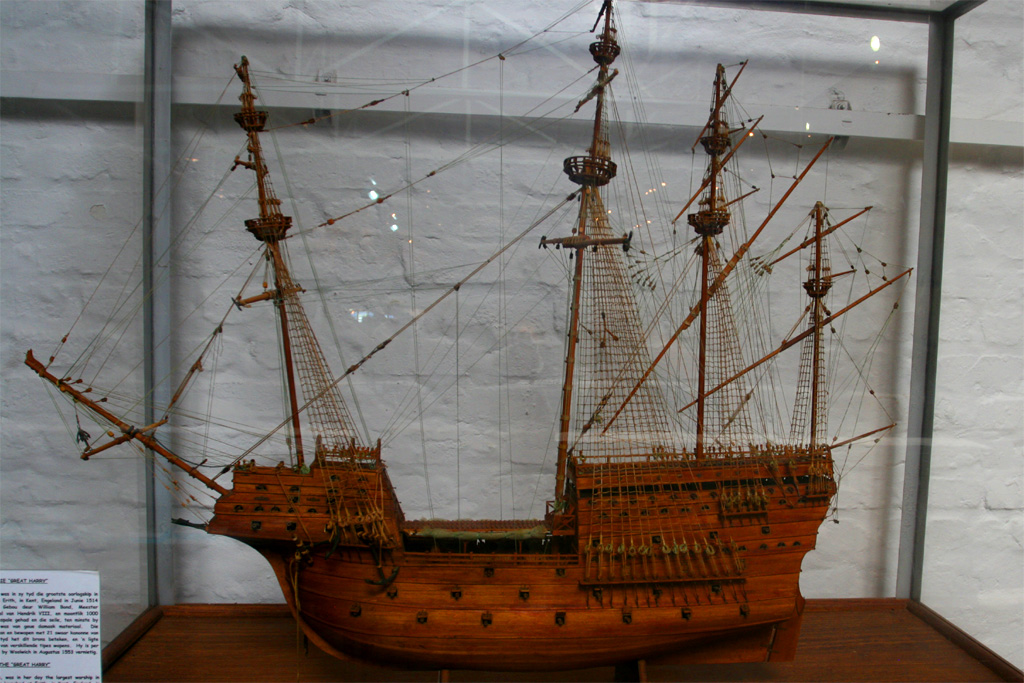
| The next generation
|
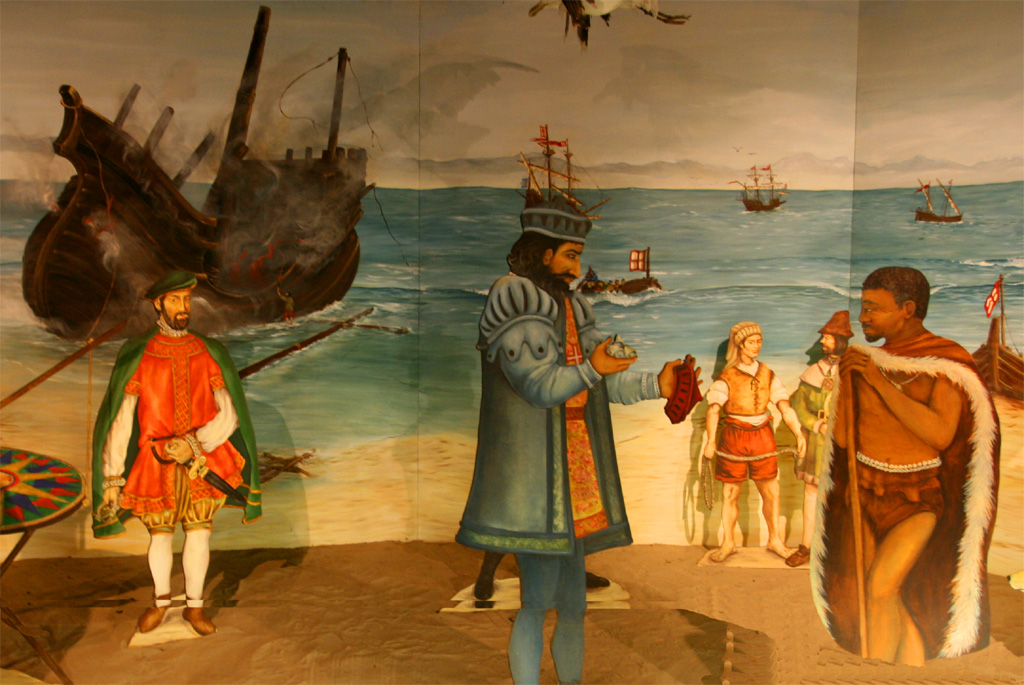
| Captain Dias meeting
|
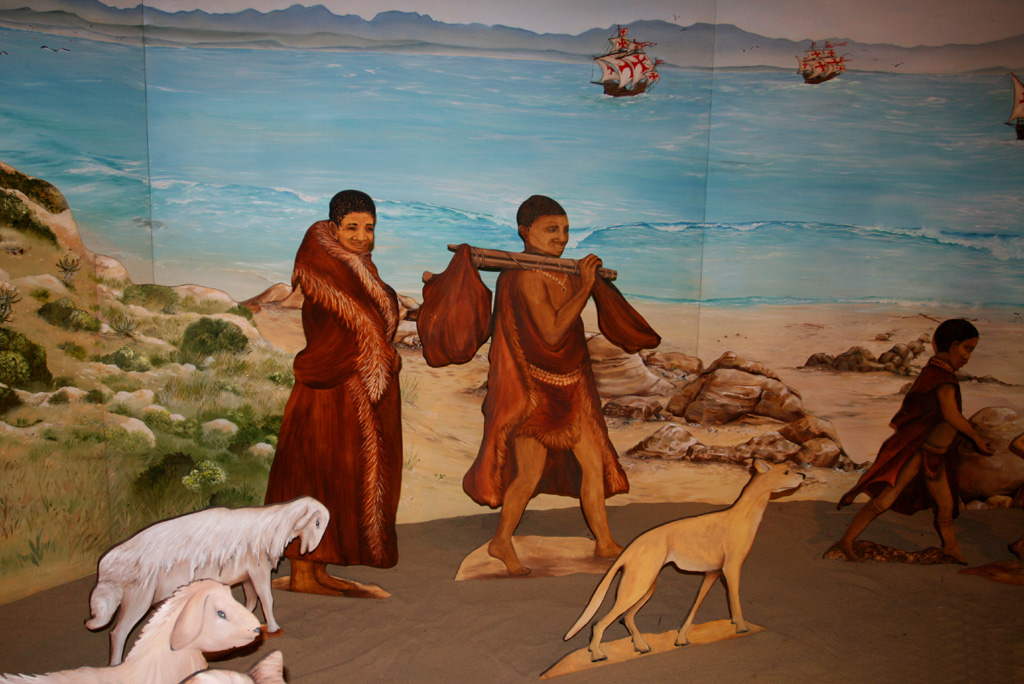
| African natives
|
This museum is also located on a historic site, too. Even after Bartolomeu Dias came here it was used as a stopover for ships going to and coming from Asia stocking up their fresh water supply and making deals with the natives, the Khoekhoen people. Here also was a postal collection point for dropping and picking up the mail contained in an old shoe and hanging in the tree, which is still standing.
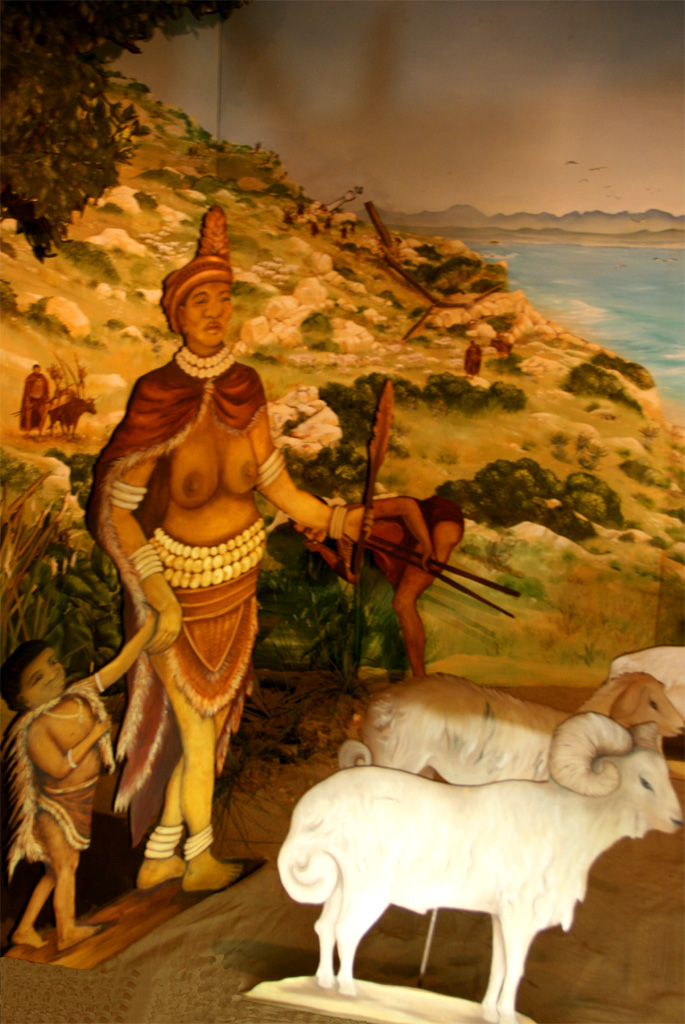
| African woman with child
|
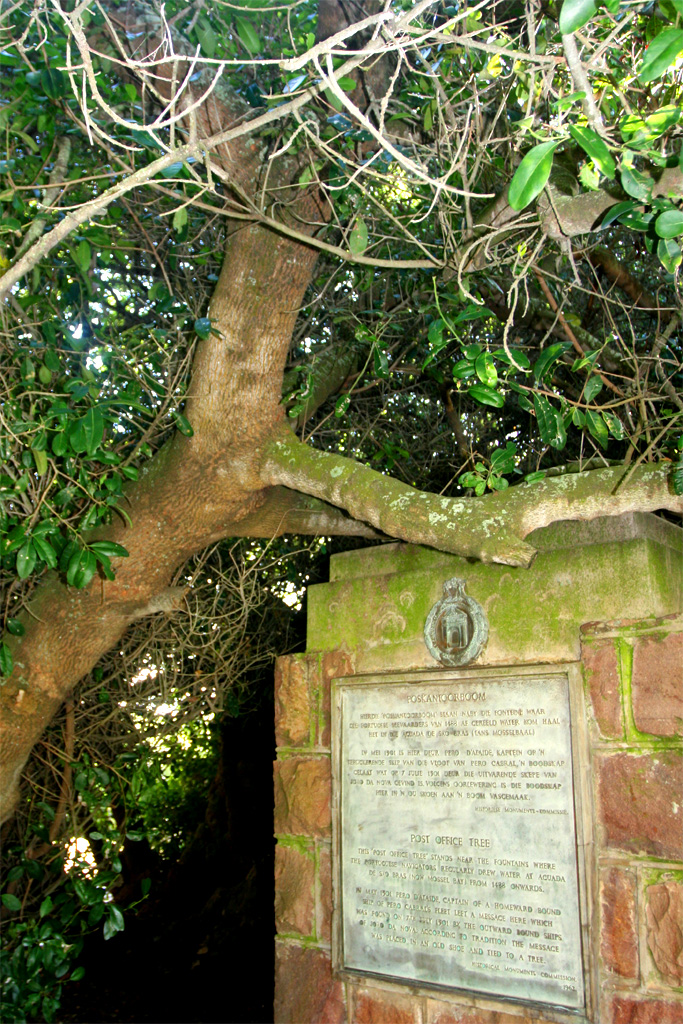
| The original mail box tree
|
On my last day in Mossel Bay I walked around town and climbed on the light tower until I was picked up at 2 p.m. by the BazBus (that was also the same time when I arrived).
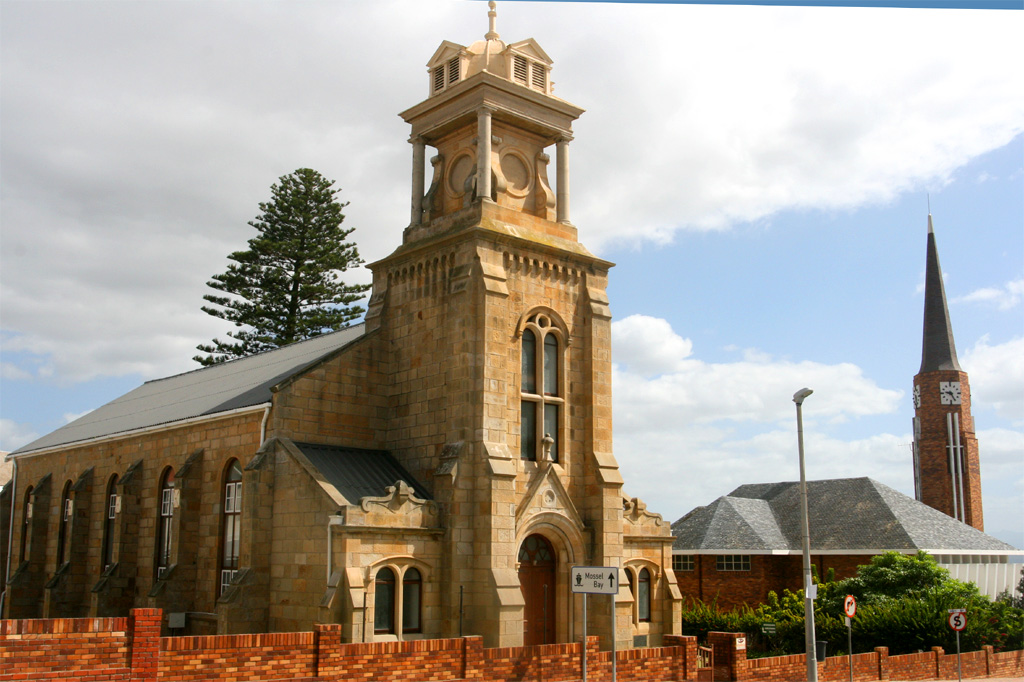
| Looks like an English church
|
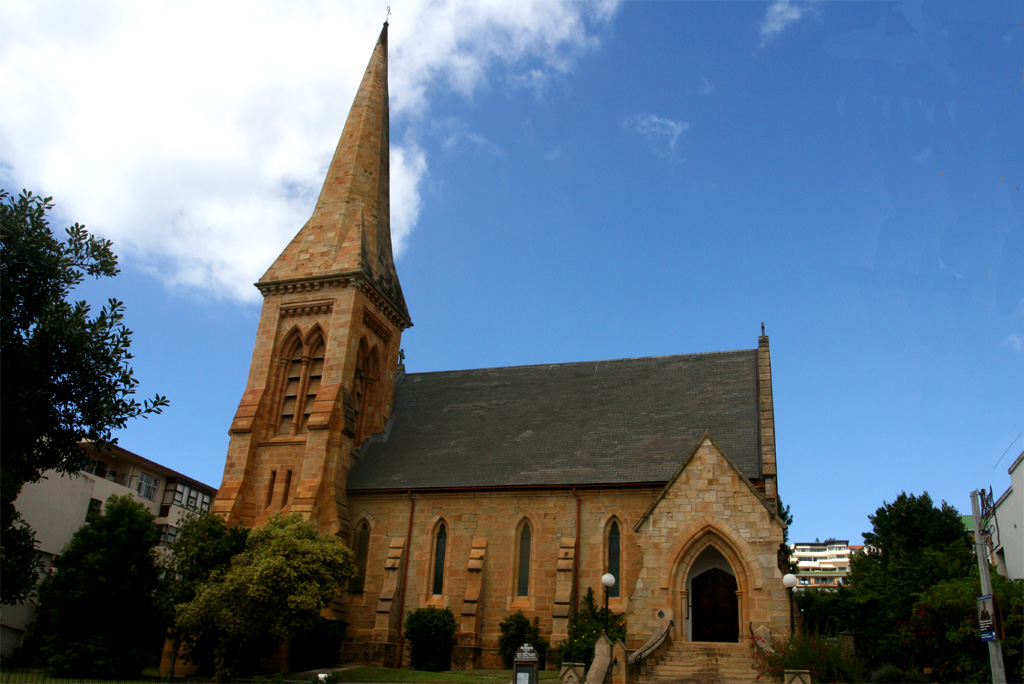
| Looks like a German or Dutch church
|
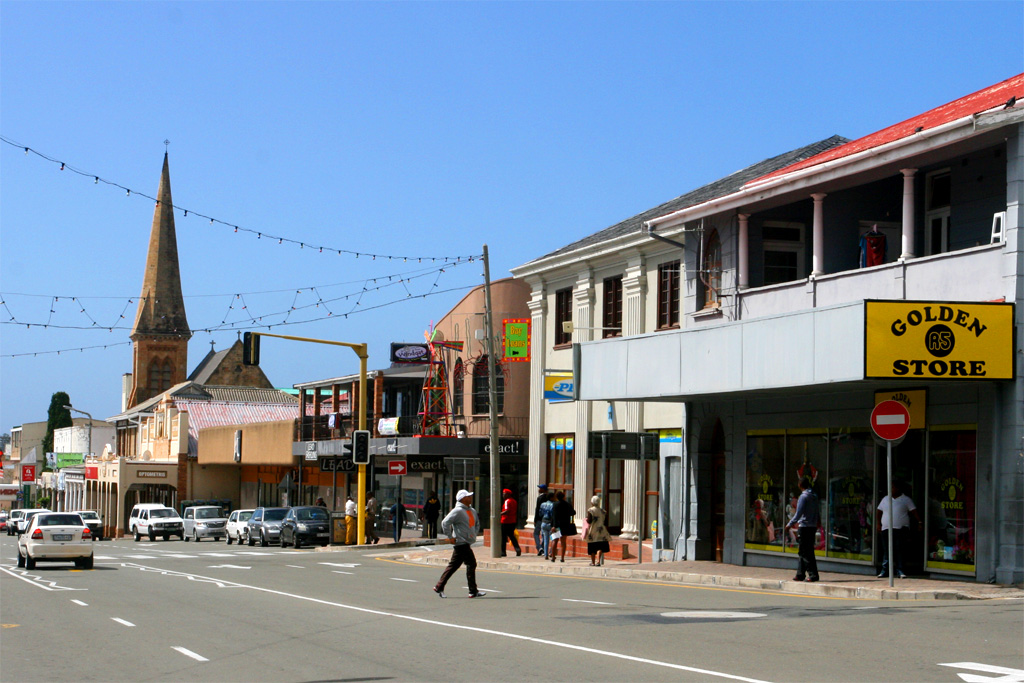
| Walking along Marsh Street with shops, banks and restaurants
|
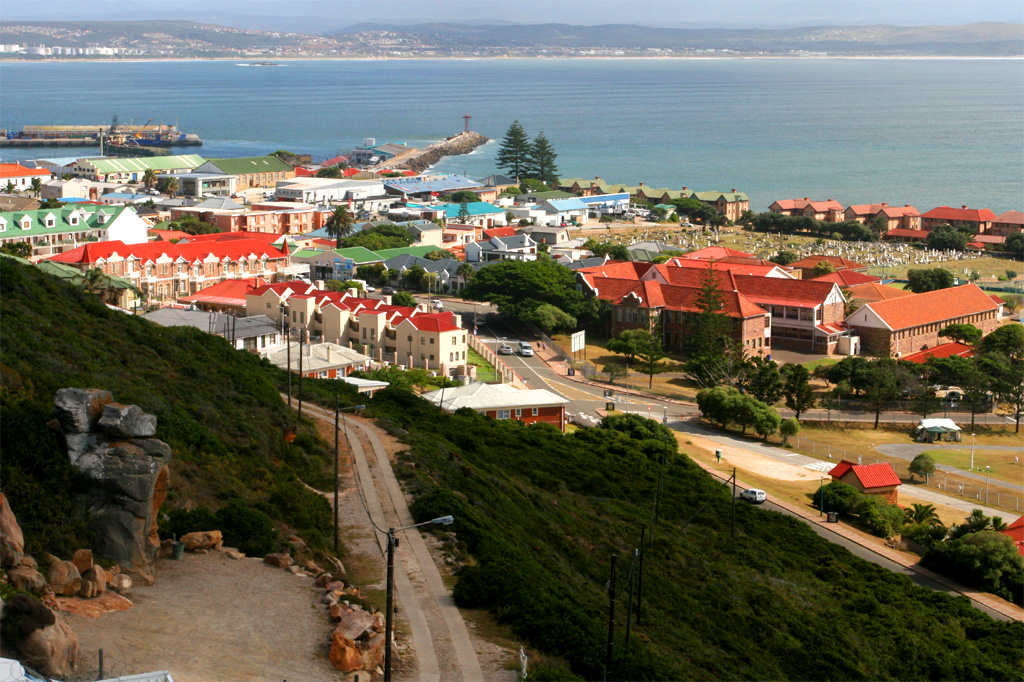
| Nice view to town on the way to the light tower
|
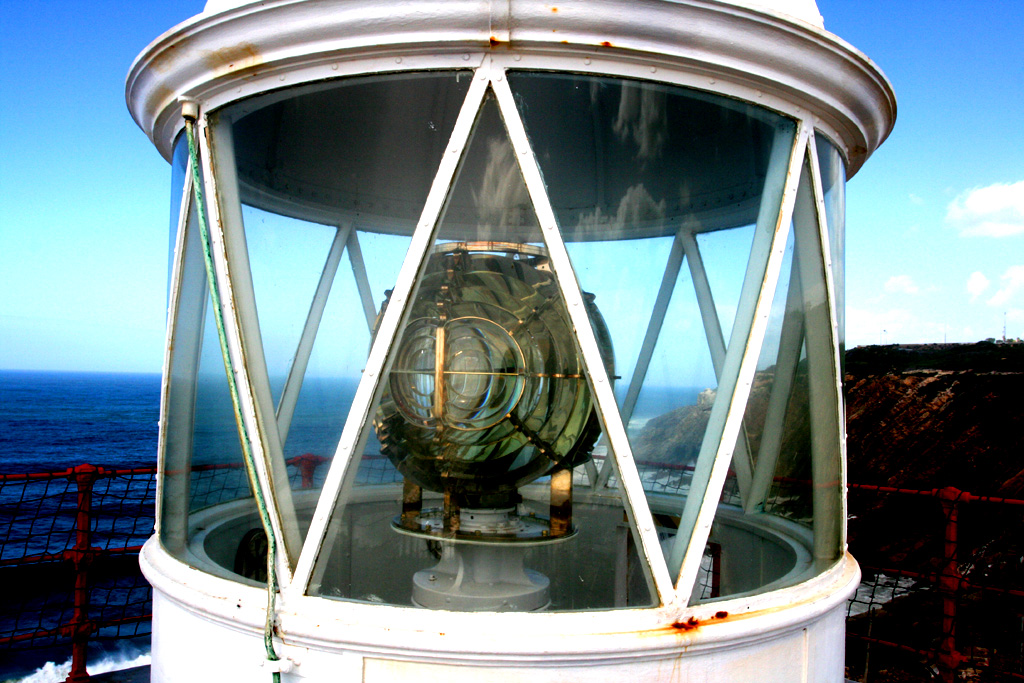
| On top of the light tower
|
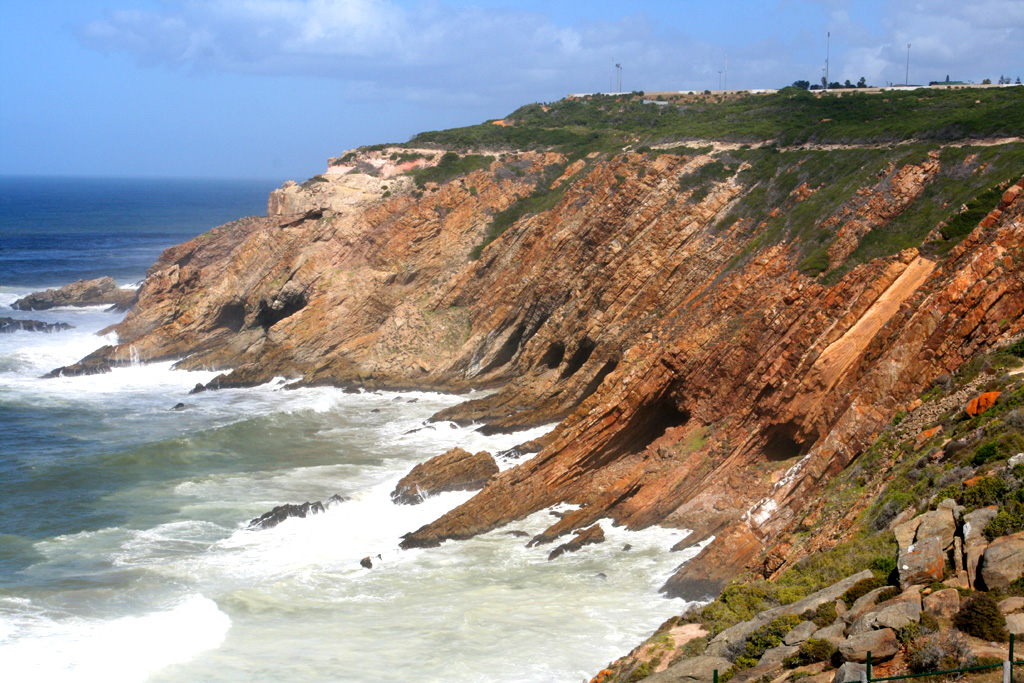
| Looking down to the cliff and to the St. Blaize Trail
|
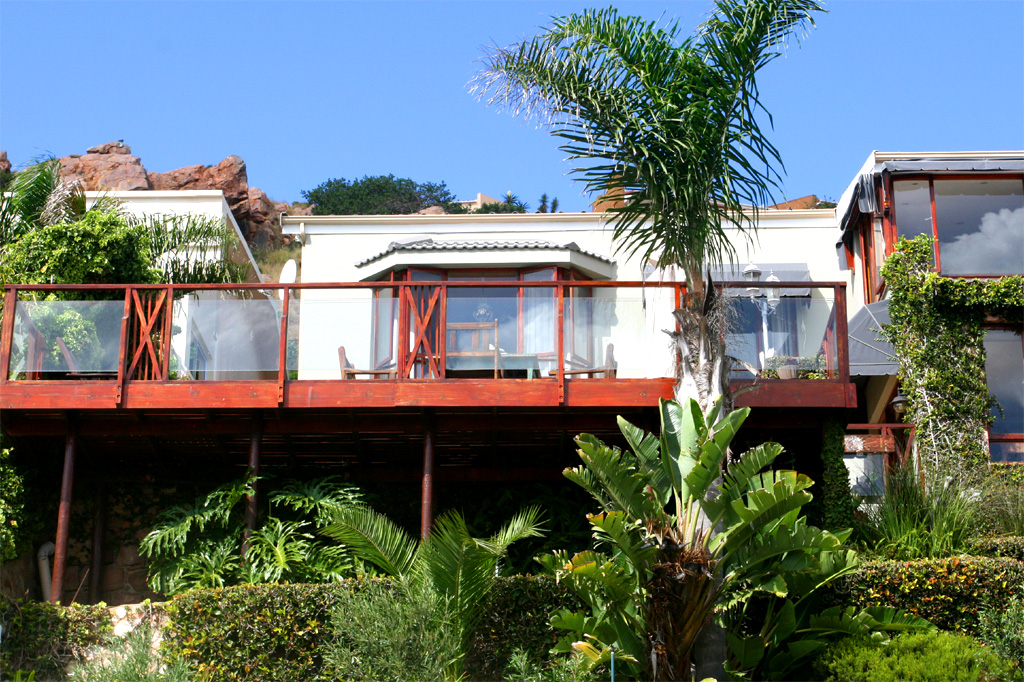
| Nice houses along the way from the light tower
|
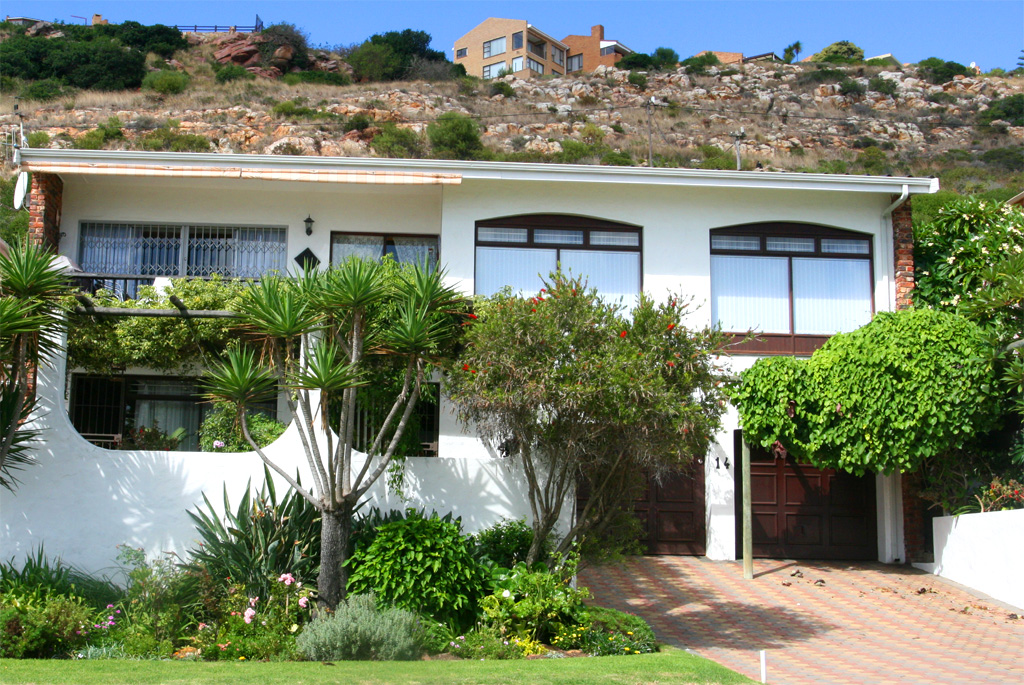
| It would be nice to live here
|
Knysna
My next stopover was Knysna. It's the most important town on the Garden Route. It's located at a beautiful lagoon and surrounded by a beautiful countryside. It has a lot of things to offer, because it is also a vacation spot and may be overcrowded during the high season, which was not the case now. So it was no problem to get any accommodation.
At around 6 p.m. I arrived at my
which was a nice Victorian style house. I had already made reservation one day before. The first night I had a simple double room for 24.00 Euro and the second night another double room ensuite for 30.00 Euro.
Same evening of my arrival I already walked down to the Waterfront with its many restaurants. But I didn't dare to eat there because then I had to walk back to my hostel one kilometer or so in dark streets with black people hanging around as I have already seen when I walked down. I found an Italian restaurant close to my hostel where I had a pizza and a beer.
Next morning I did get up early to book a township tour. Unfortunately there was no scheduled one but finally the lady of a tour agency I called up found a guide for me. His name was Mawande and he picked me up at the hostel. He looked like Denzel Washington and he also was as nice as him. He had an interesting personal history from a poor boy growing up in a township to an entrepreneur founding his own company. Look up his site
Wandu
and you will be surprised. By the way: I paid him 24.00 Euro at the end of the tour.
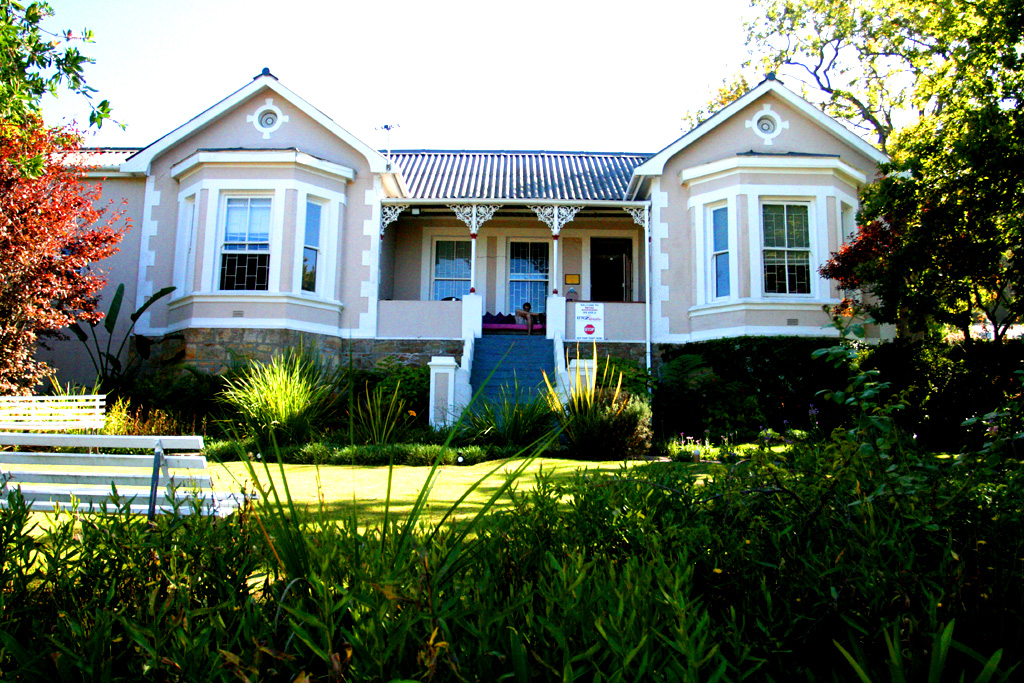
| My Knysna Backpackers Hostel
|
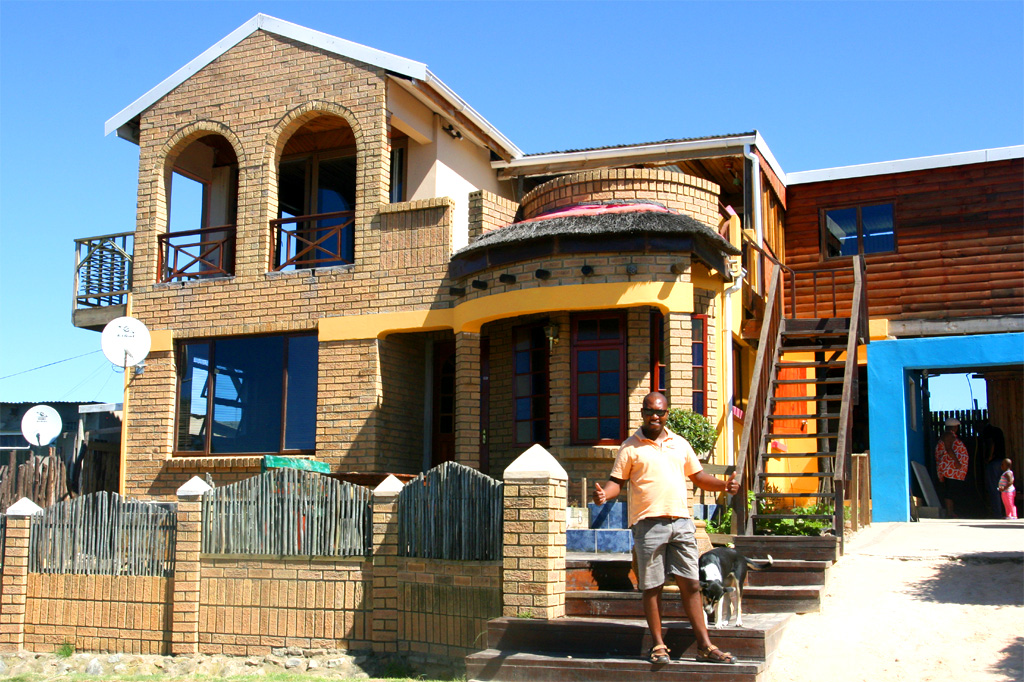
| Mawande's guesthouse in a Knysna township
|
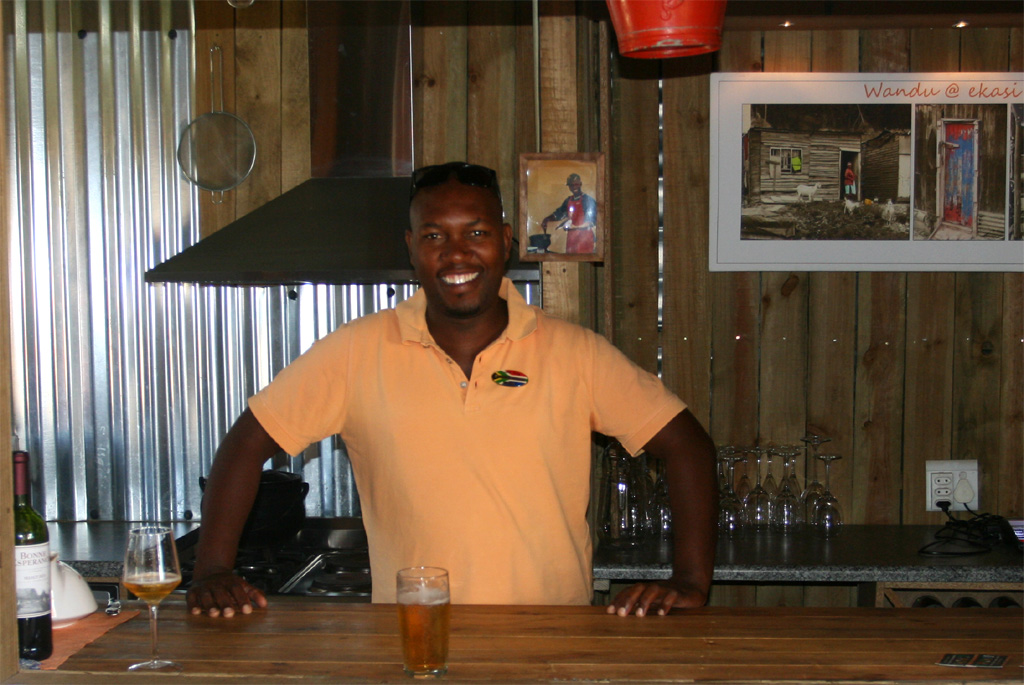
| He invited me for a drink in his bar he designed
|
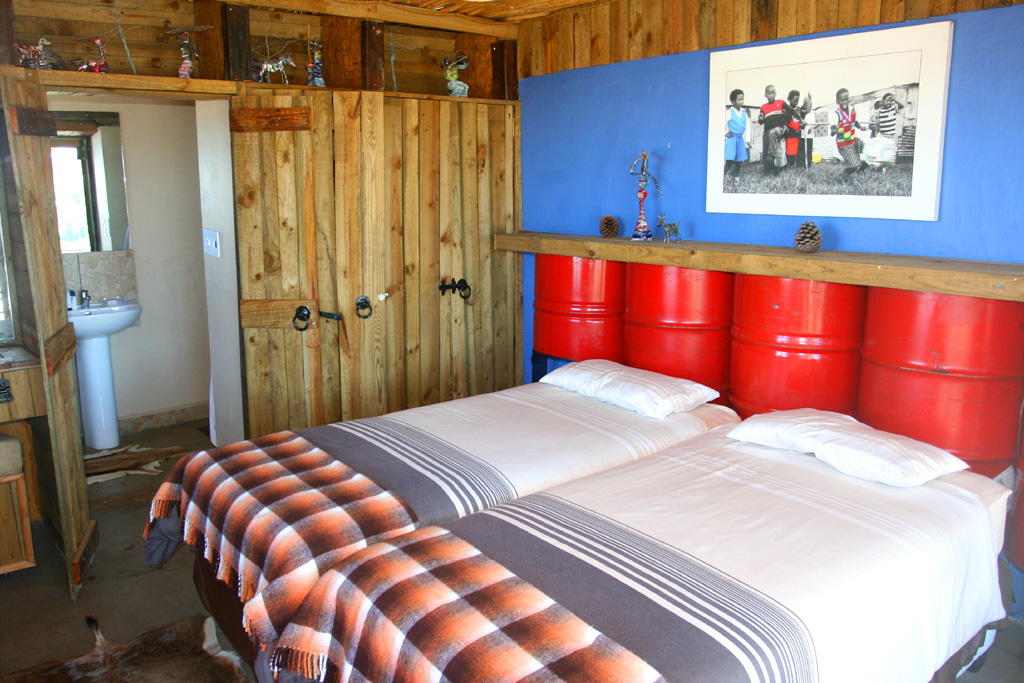
| Also the guestroom was his own idea
|
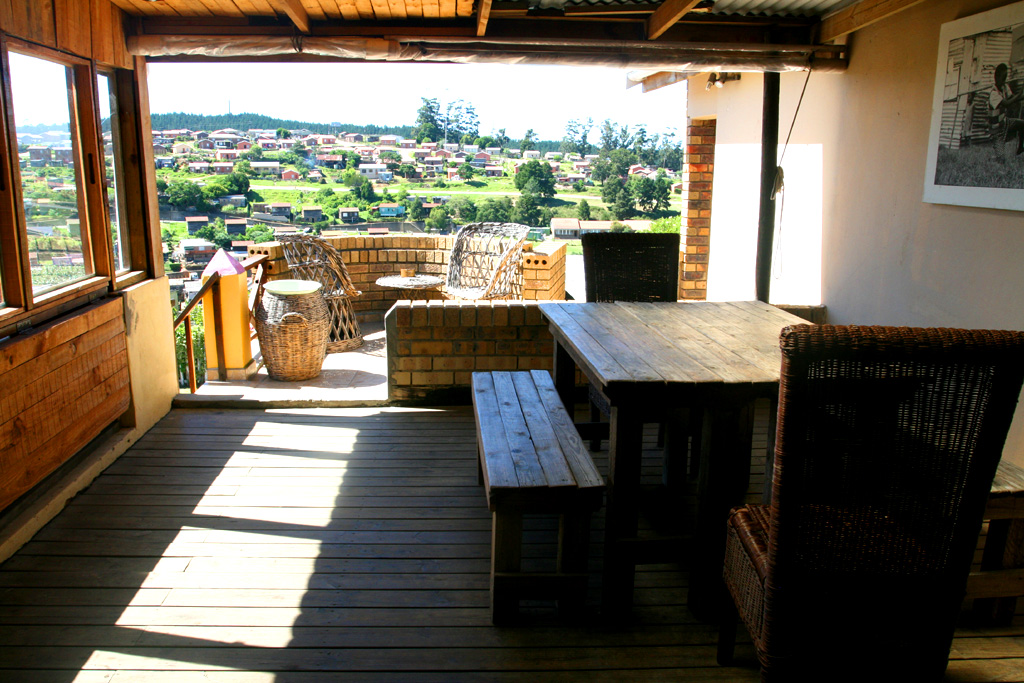
| This is really a nice place
|
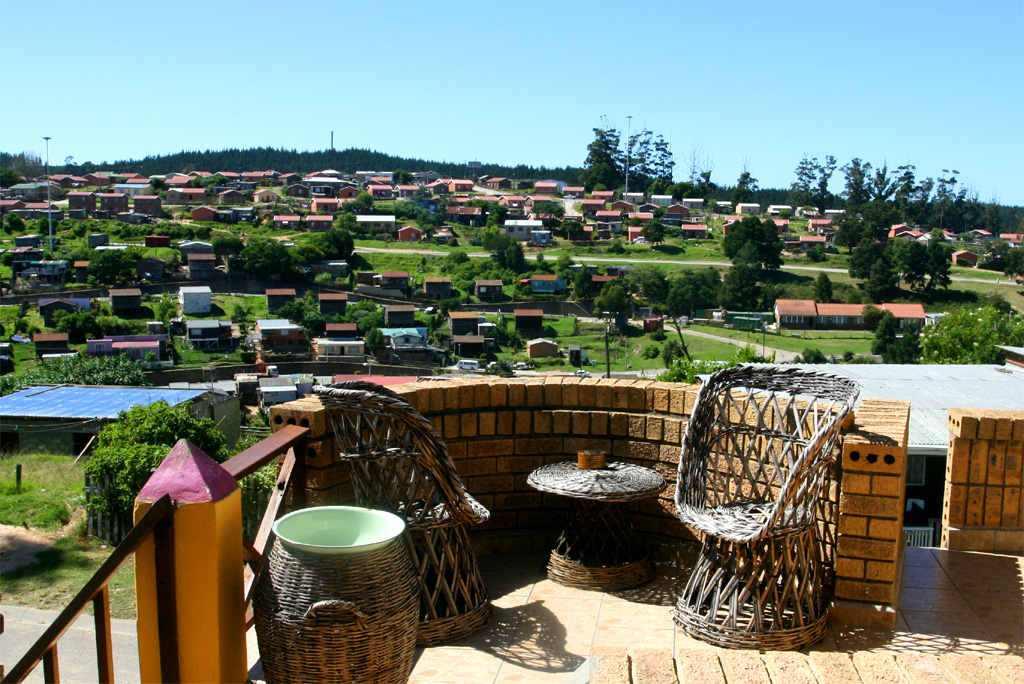
| with a beautiful view
|
The house of Mawande was one of the best in his township. He designed it himself, because he also paid for it. Many other houses which are built by the government all look the same. And there have already been built many of what I could see while Mawande showed me around.
Living in these new houses with electricity and water is much better than living in the old shacks mostly without. Poor and jobless families with no income can live in a house like this for free. Only if they have work then they have to pay a share related to their income, according to Mawande. This township is already very fortunate, even if not all families did get a house like this yet.
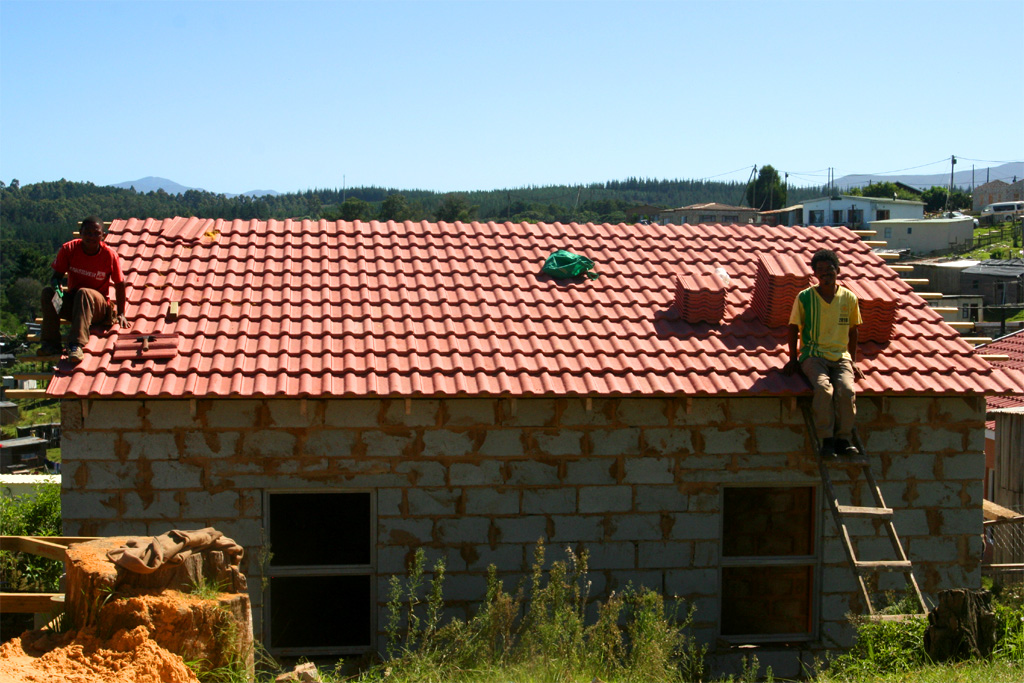
| New houses are being built
|
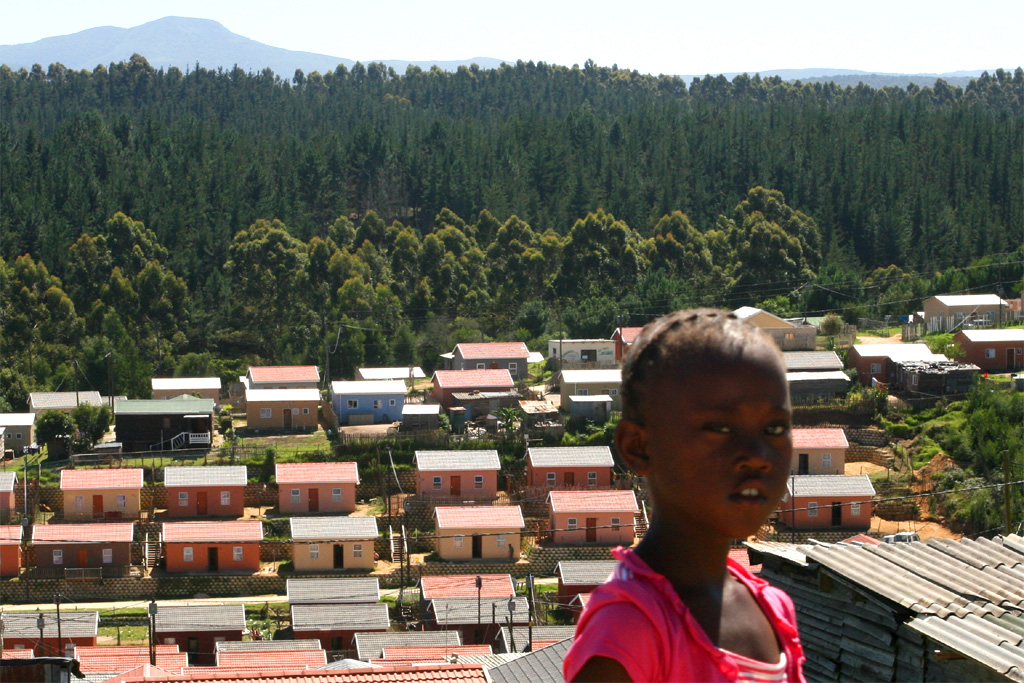
| New townships are being built
|
Not only many new houses have been built in this neighborhood but also many buildings like a community center, a fire engine station, a school, a sports facility and a play ground. Take a look at the following photos.
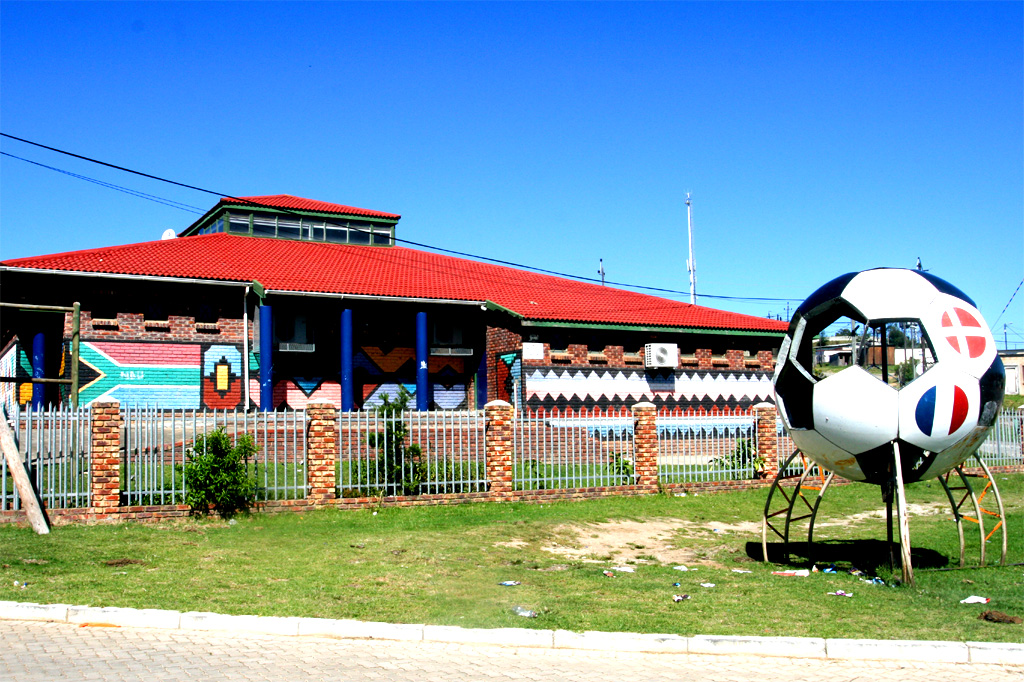
| A brand-new community center
|
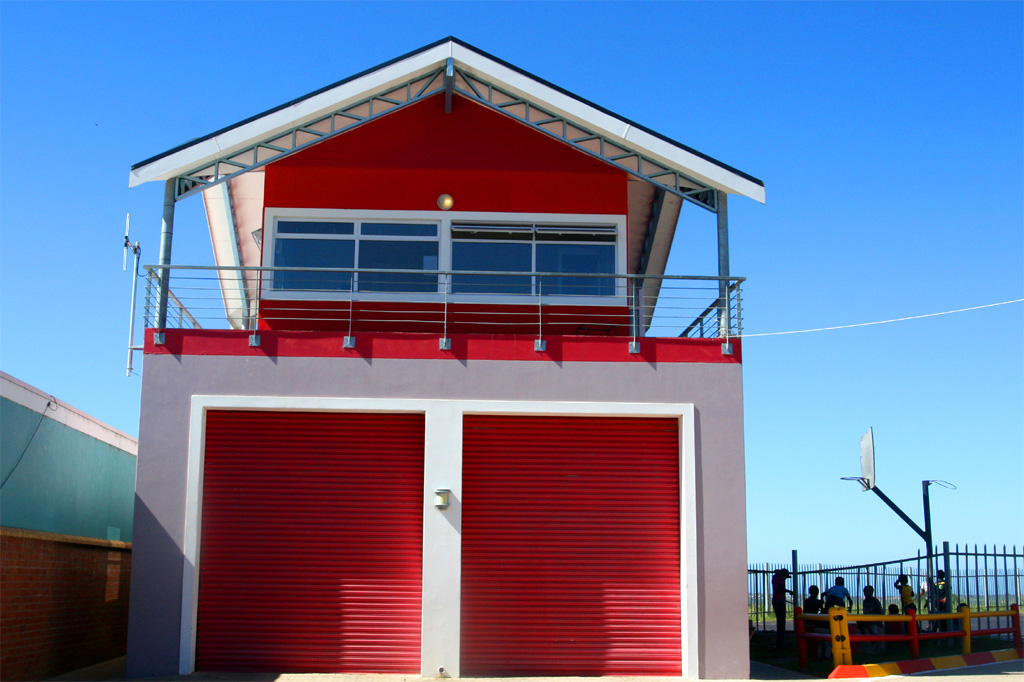
| A brand-new fire engine station
|
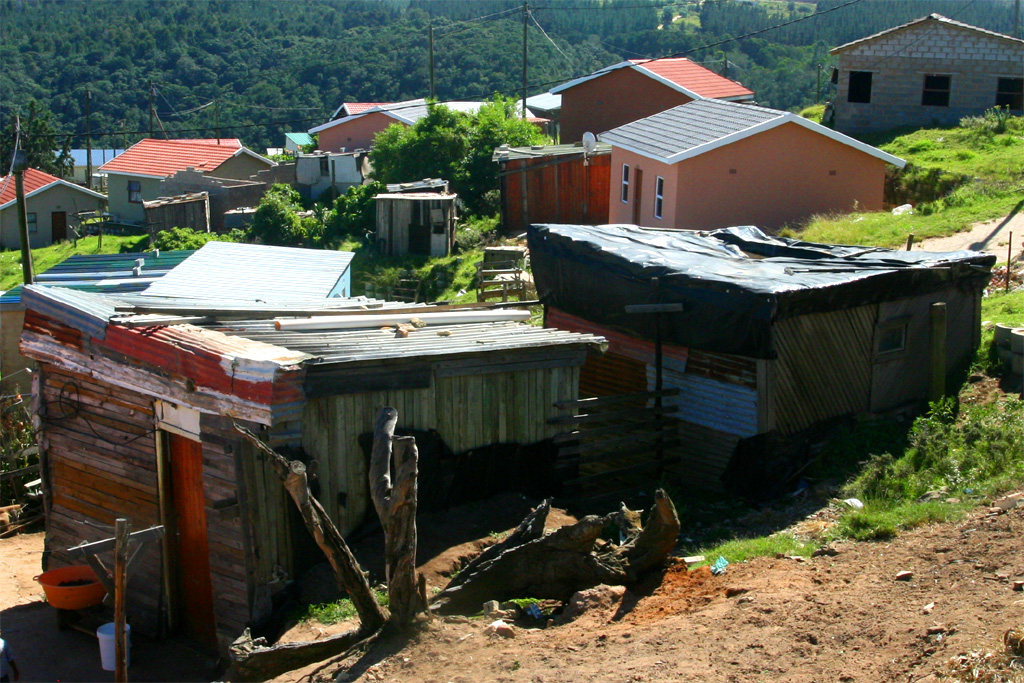
| Still many shacks
|
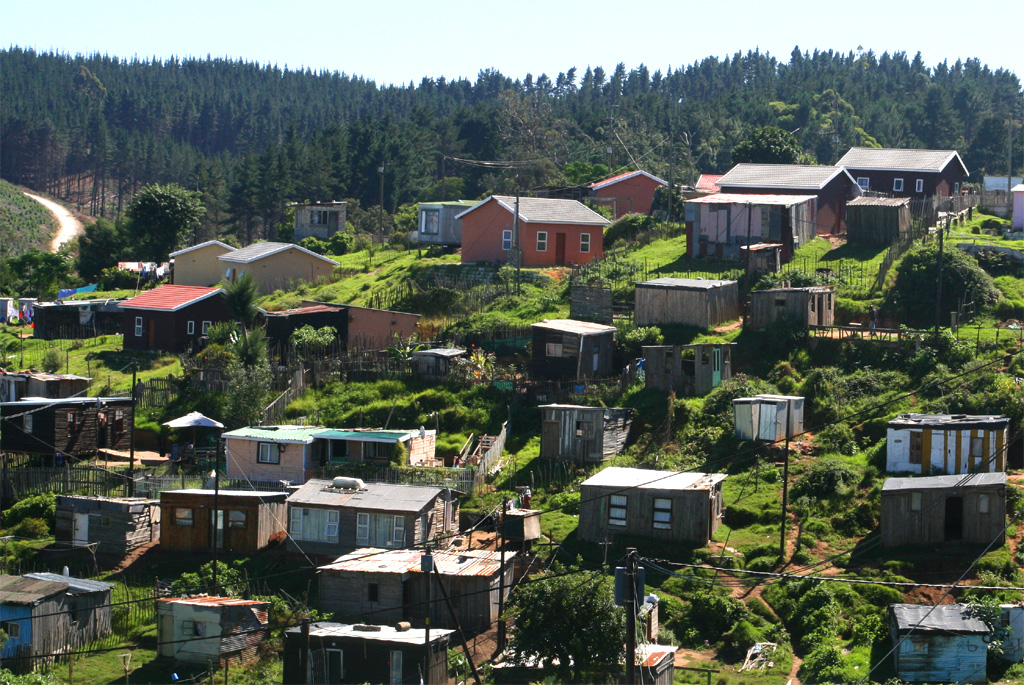
| have to be replaced
|
What the government does not pay for are shops and businesses of any kind. They are either do-it-yourself enterprises or privately financed.

| The hair cut salon will probably not be replaced
|
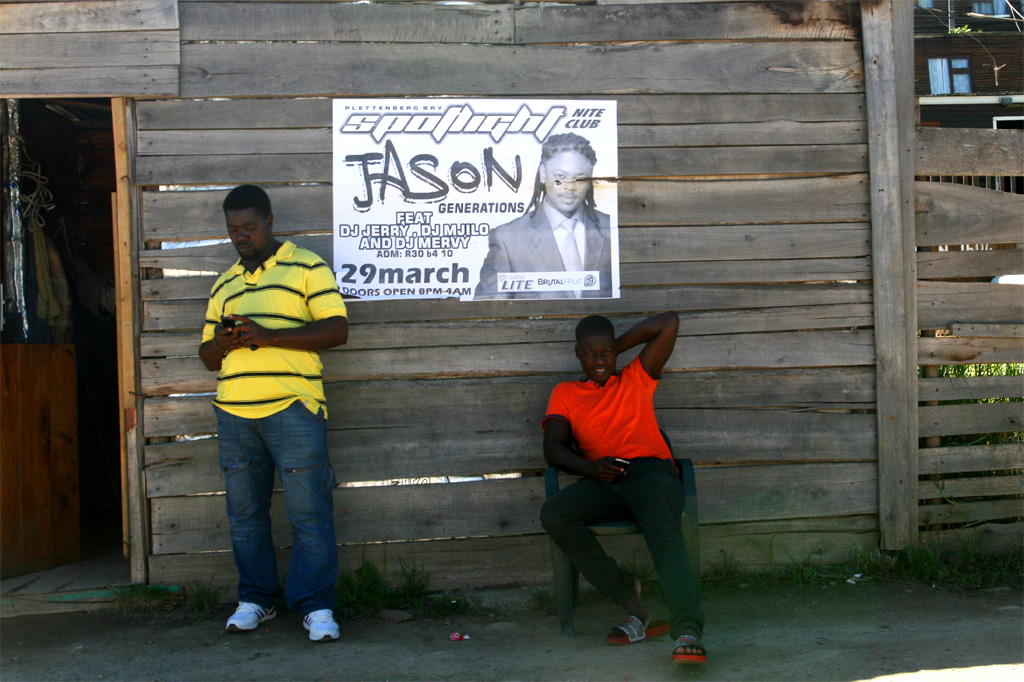
| But maybe the night club needs a new look
|
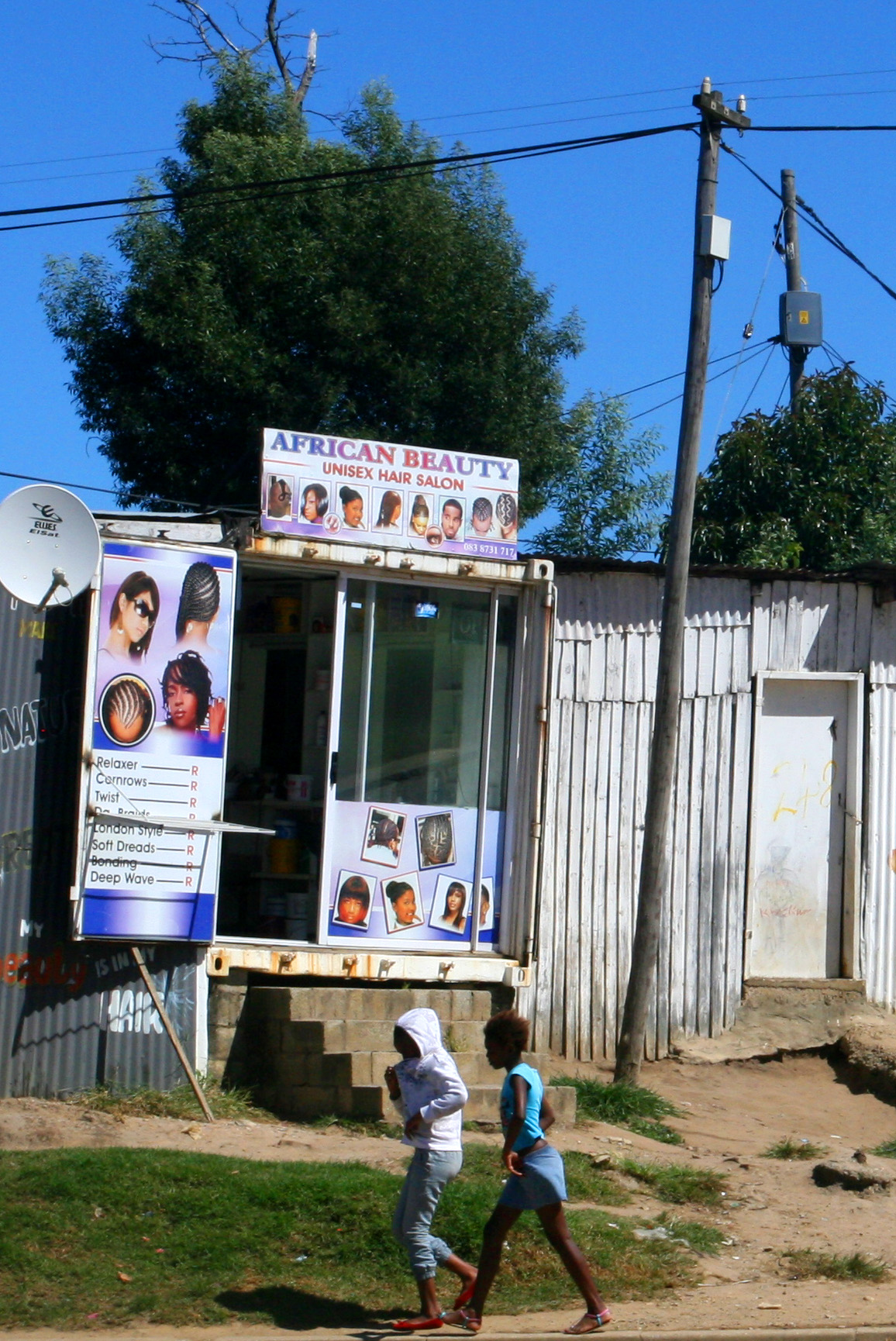
| The competition is close by
|
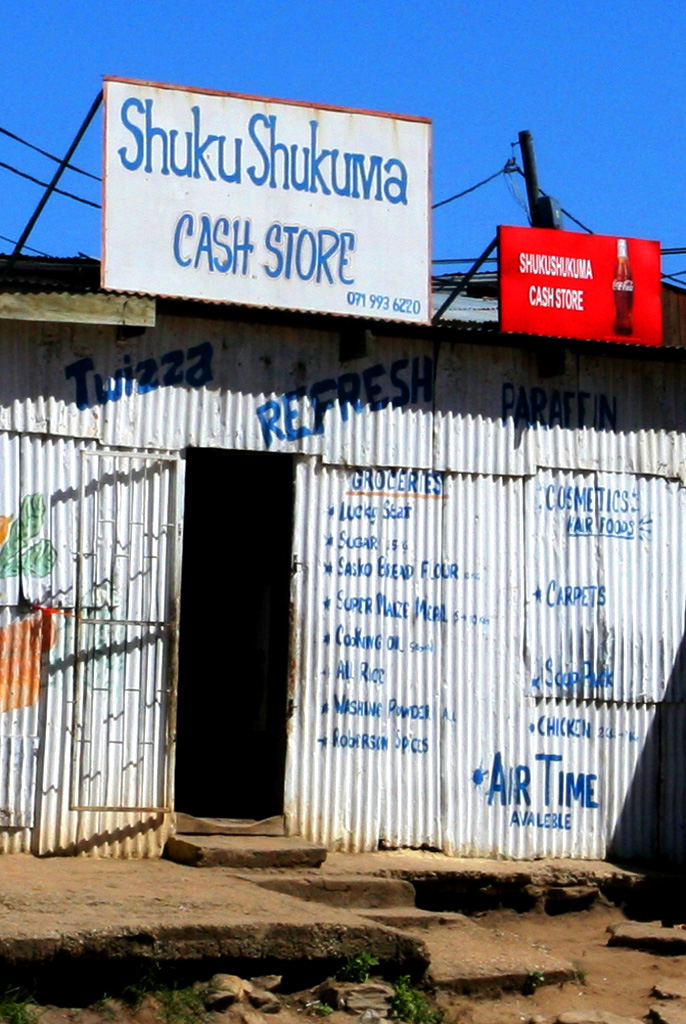
| Here you can only buy with cash
|
Some residents are trying to raise their subsistence level by raising some animals like goats. Mawande joked about the Big Five in a township: Goat, pig, dog, cat and chicken. Some residents may even try to raise their subsistence level with steeling by any means. But there is the Neighborhood Watch trying to prevent it.
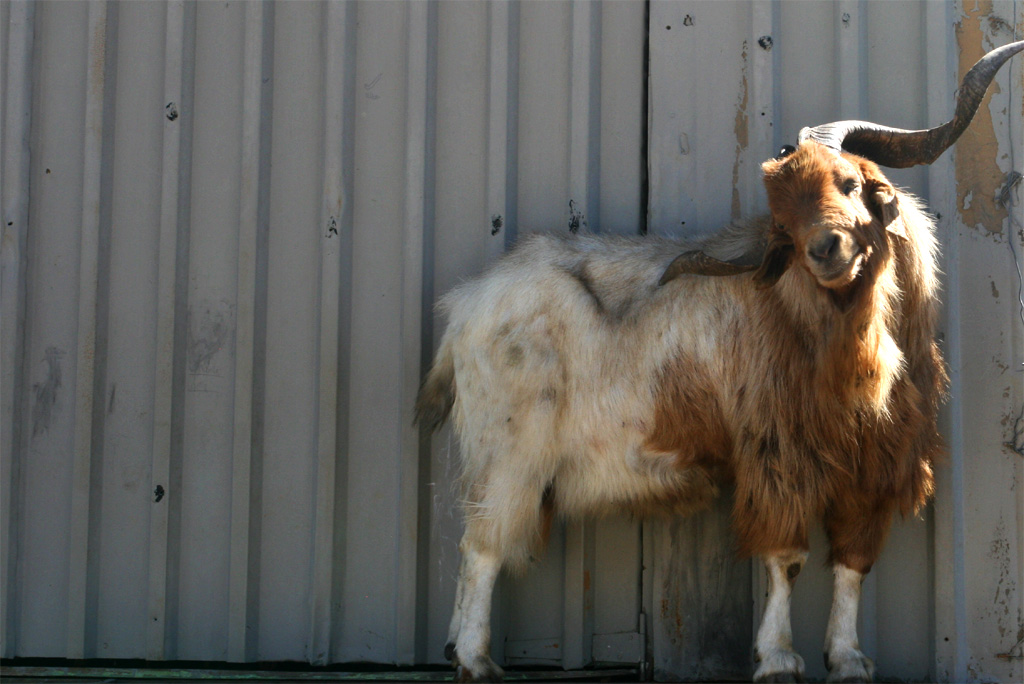
| One of the big five in a township: A goat
|
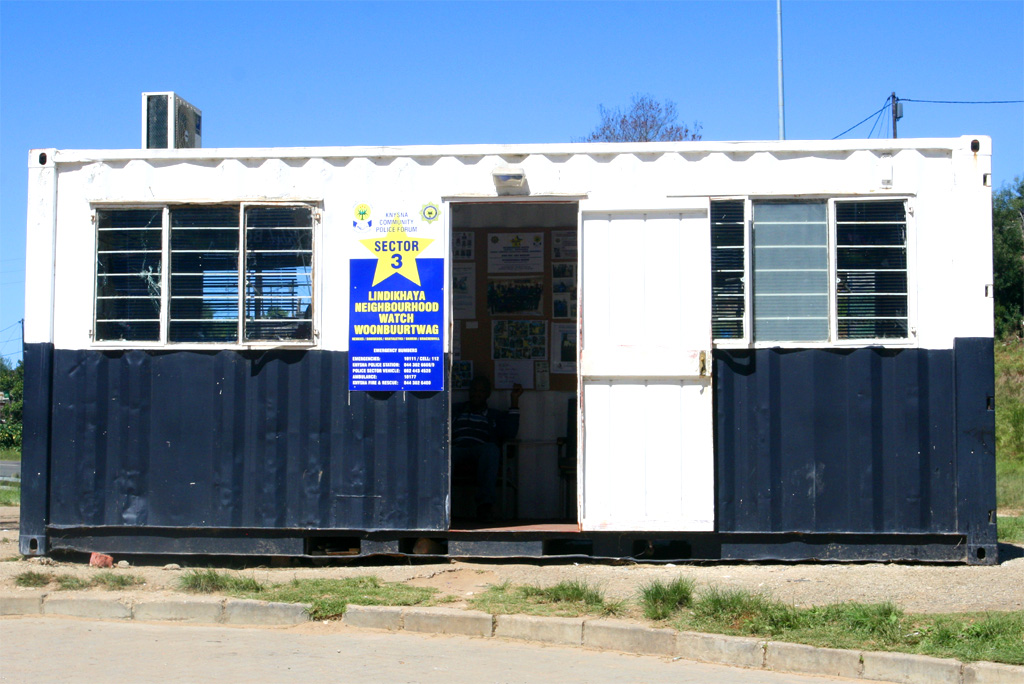
| The Lindikhaya Neighborhood Watch
|
Then we met a guy of the Rastafarian community also acting as a guide for a young lady. Look up the internet
http://www.judahsquare.co.za/
to learn more about it.
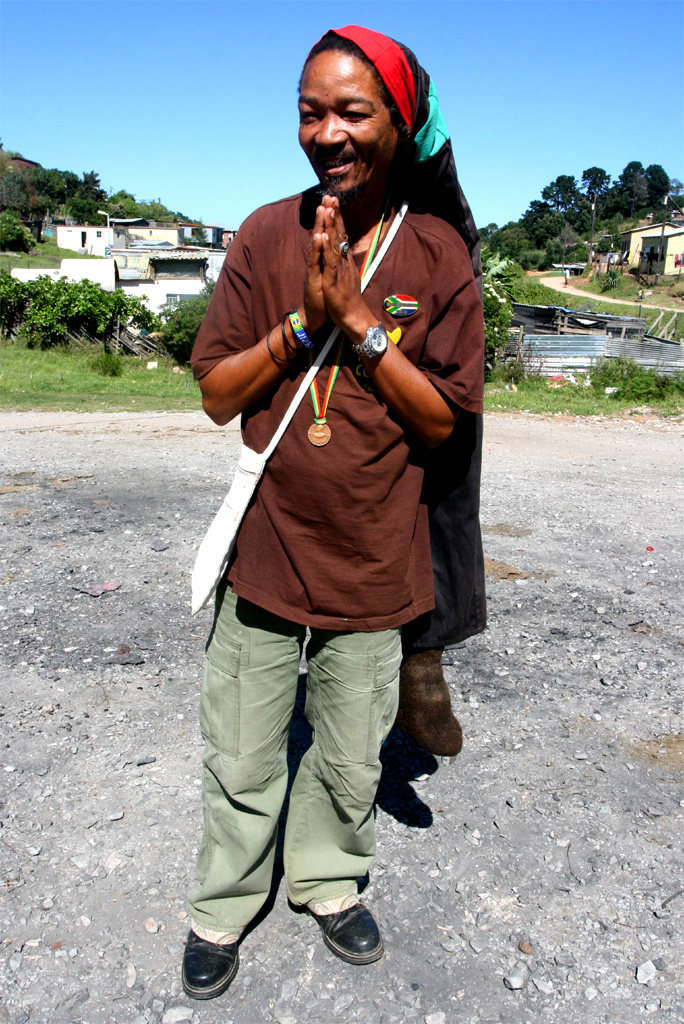
| This guy is a Rastafarian
|
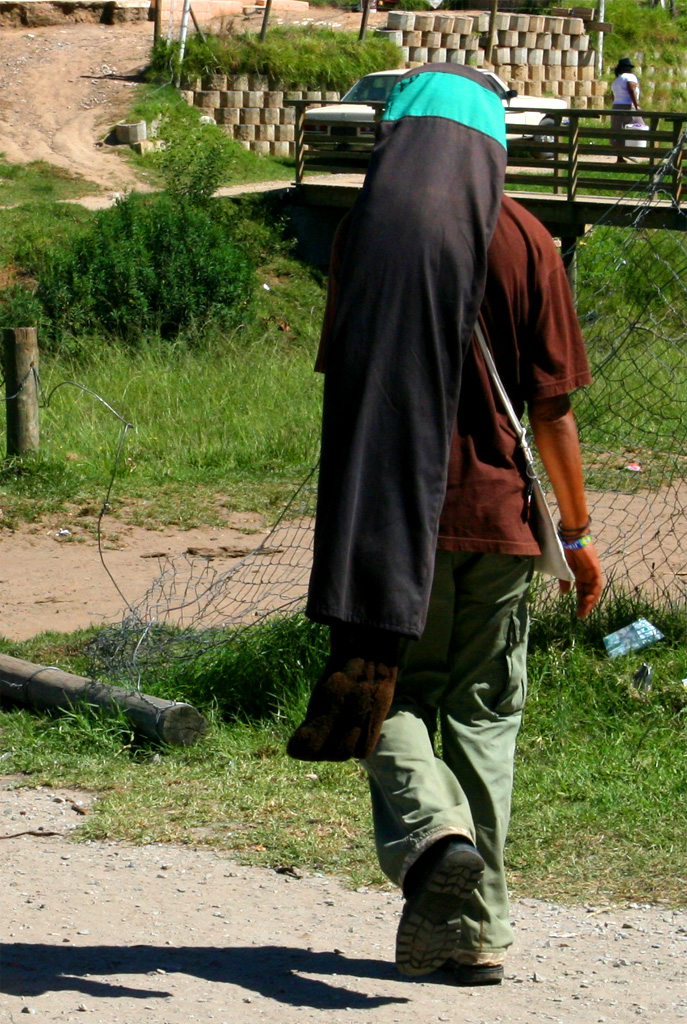
| with hiding long hair down to the knees
|
On any township tour you must see and also are allowed to see some of the miseries people endure by living under these conditions in shacks with no electricity, no running water and no toilet. Though the lady we met was still smiling. She waited for her kid coming out of school and for her husband who is looking for a job in Knysna town.
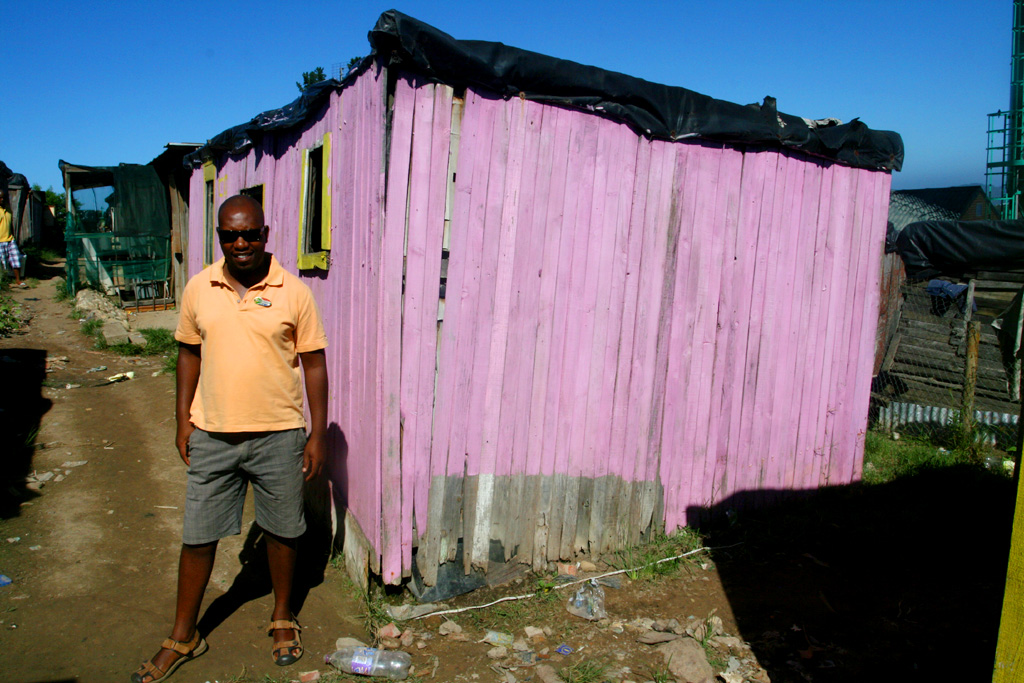
| And now one of the last shacks?
|
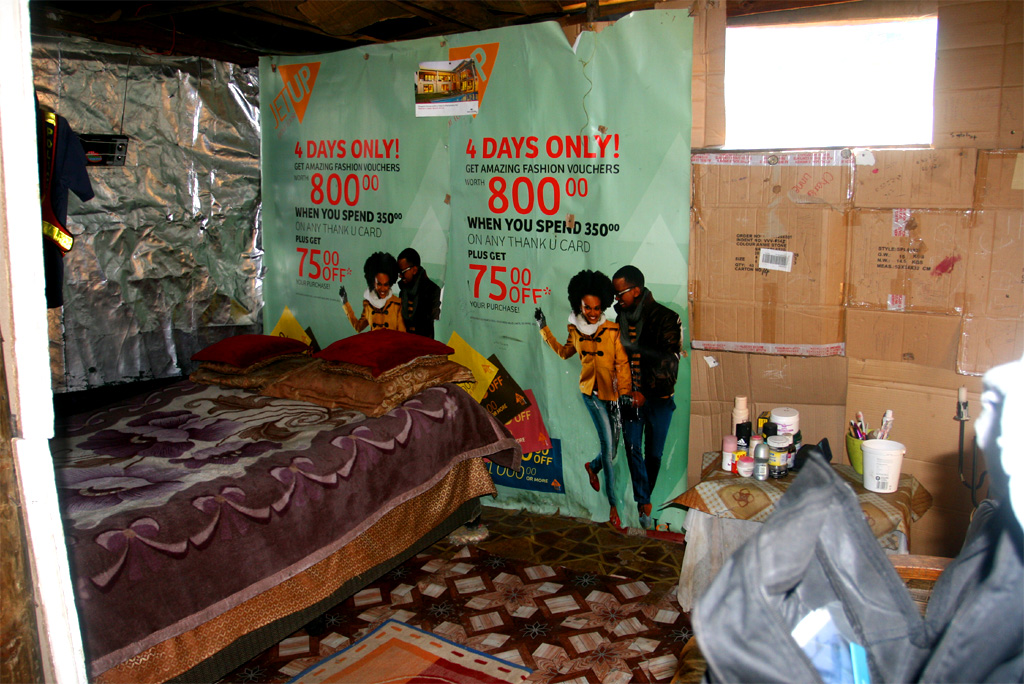
| Inside a table and double bed
|
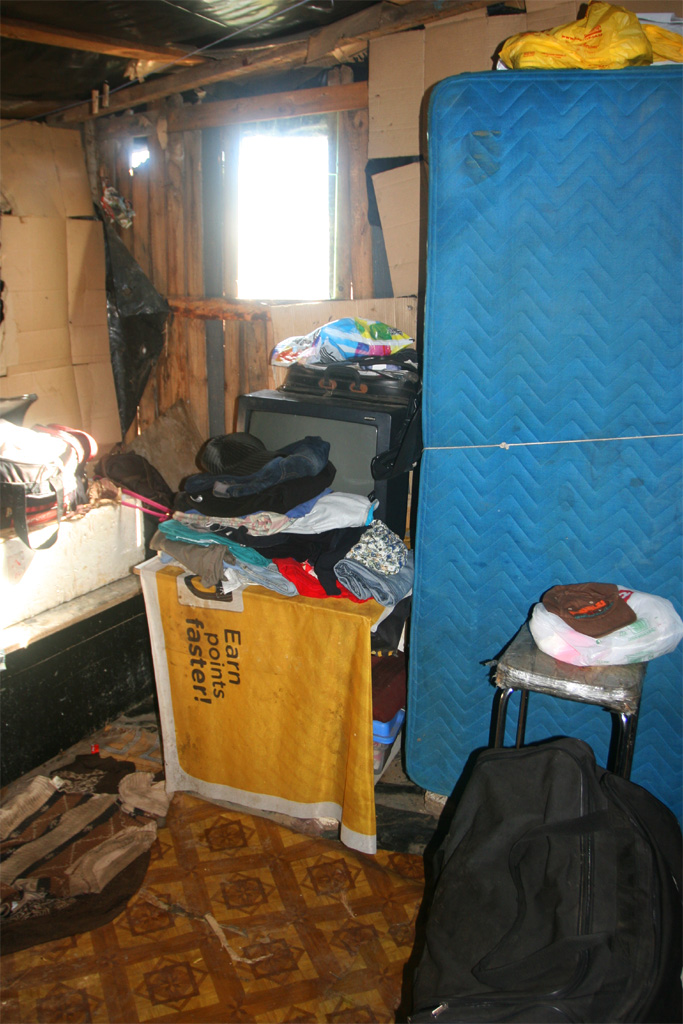
| This is the children's room
|
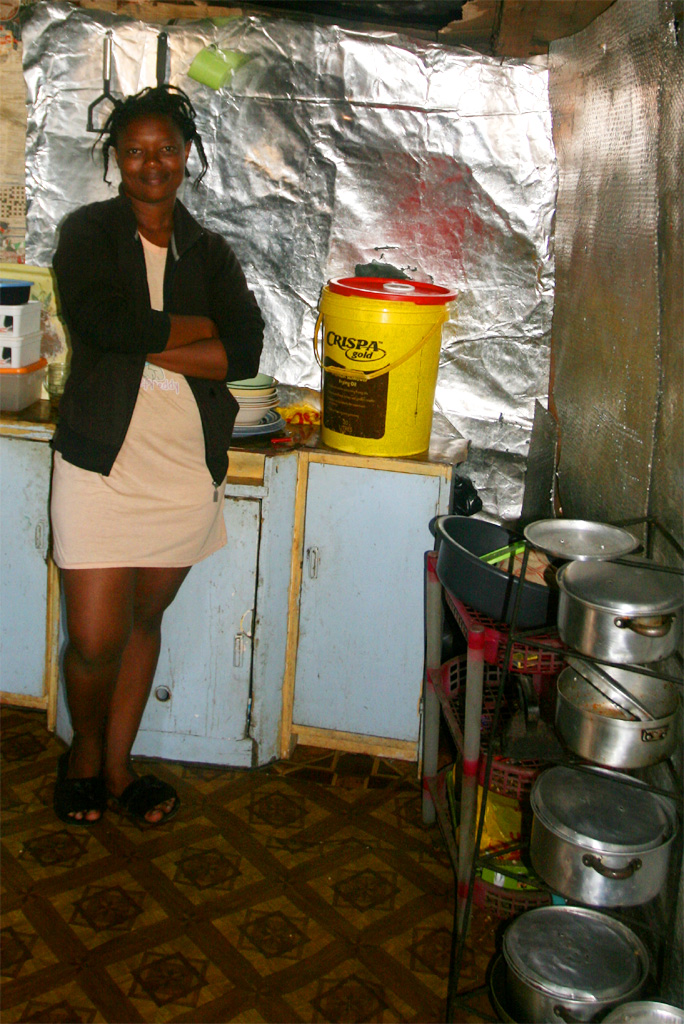
| And this is the kitchen
|
The beautiful view from the township down to Knysna Town is probably not appreciated that much by the people living here, when they see the beautiful houses and yachts of the rich around and in the harbor.
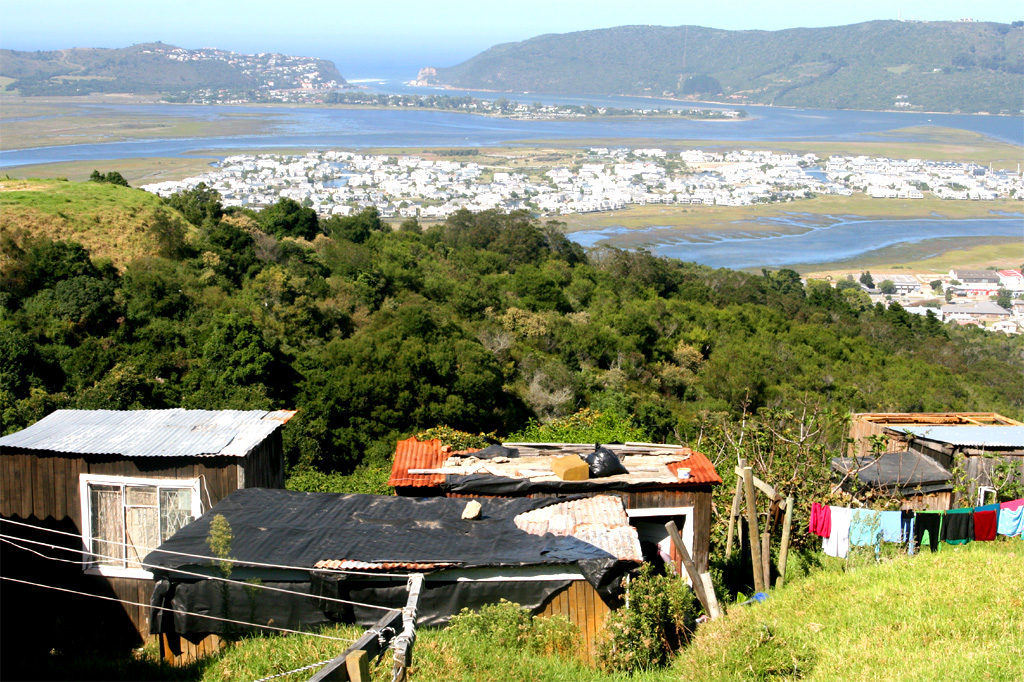
| What a nice township location
|
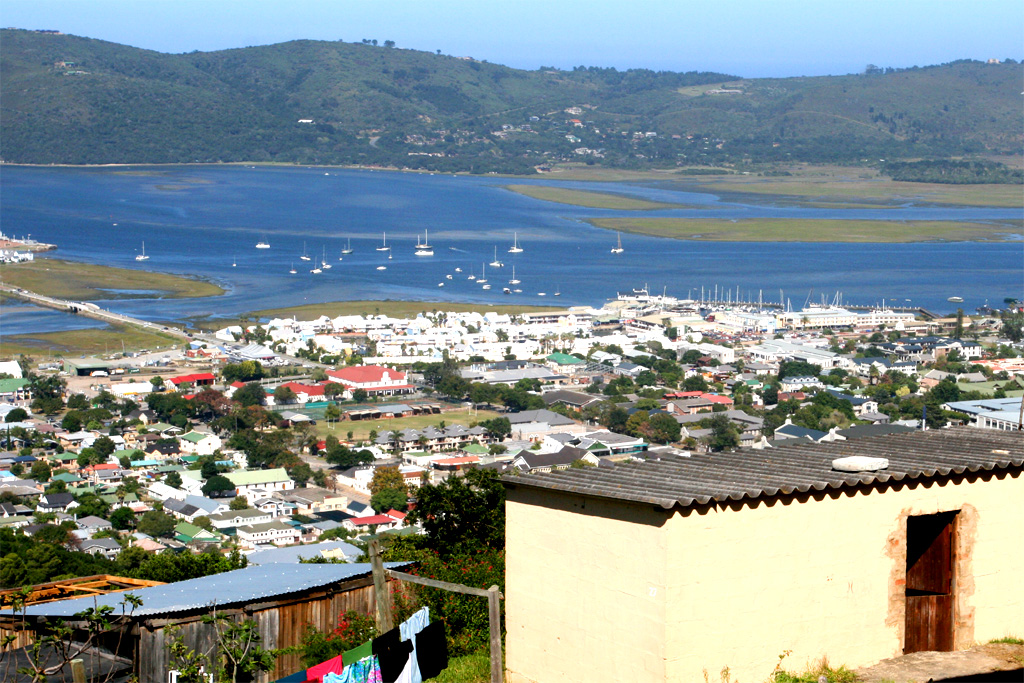
| with a view to Knysna Town
|
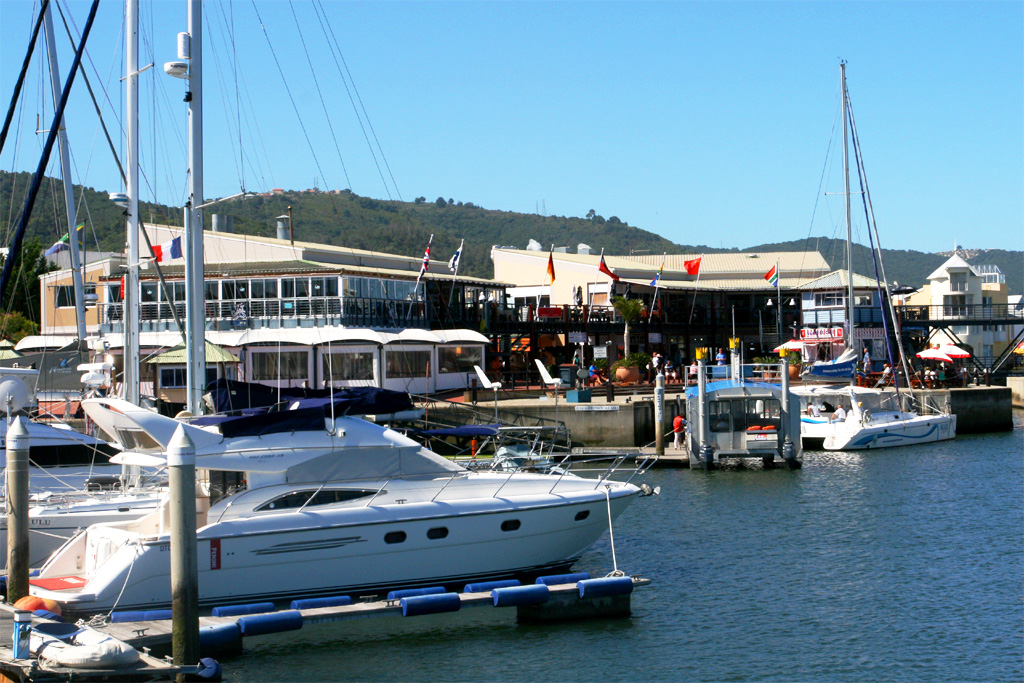
| The harbor at the Waterfront
|
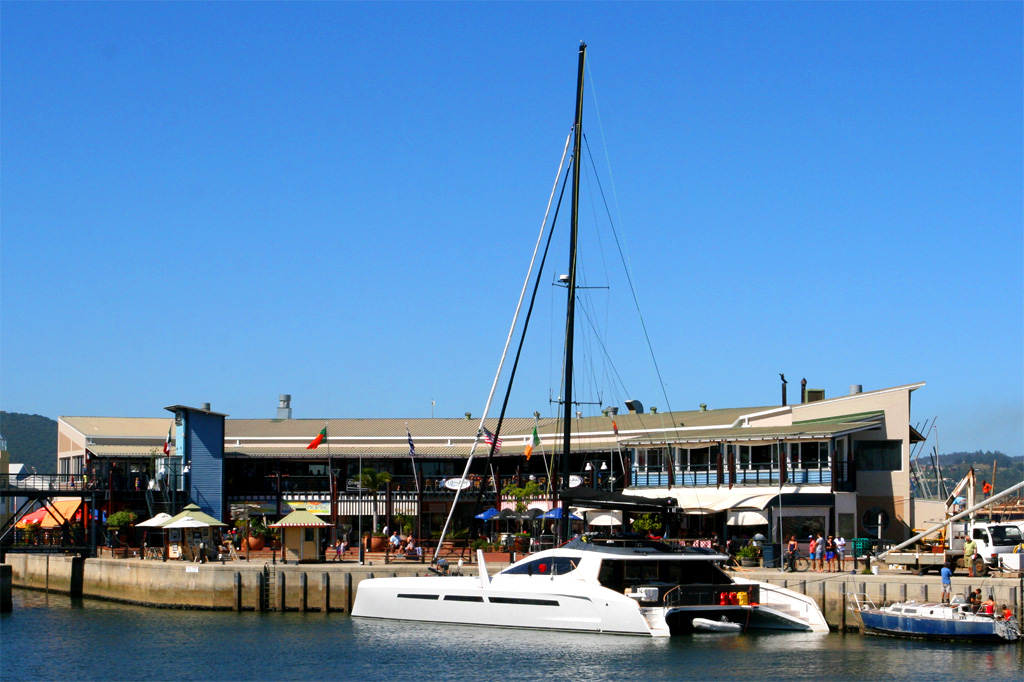
| with many yachts and restaurants
|
At the end of the township tour Mawande dropped me off at the Waterfront just in time for the lagoon cruise with the MV John Benn. The ticket for a two hour cruise was 10.00 Euro.

| See that ship on the right: The John Benn
|
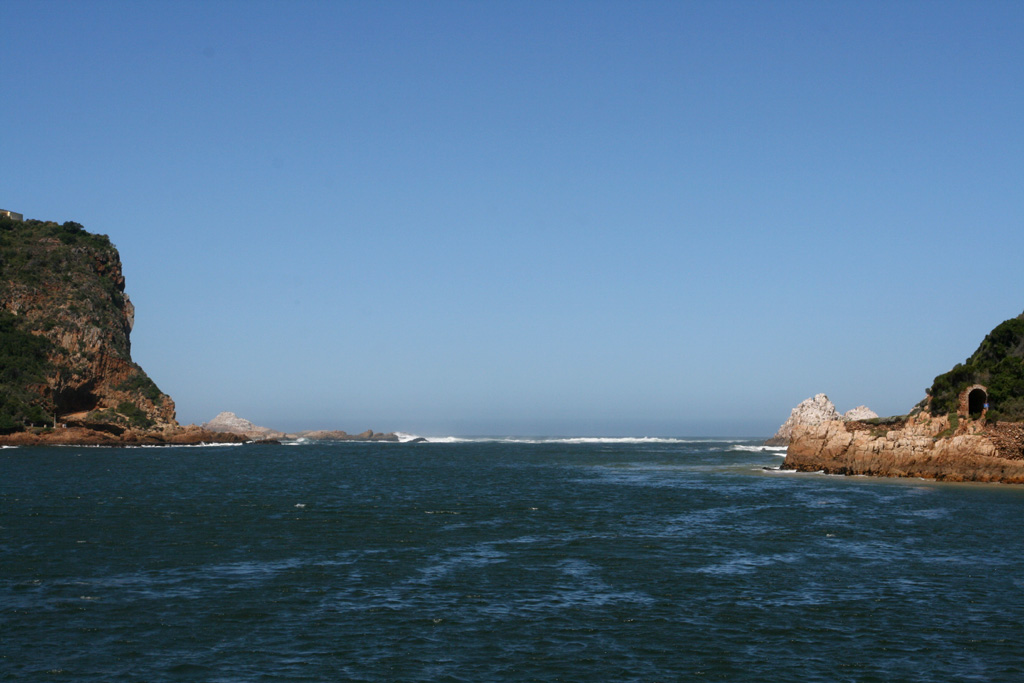
| I went with it on a cruise to the Head
|
The Head is the only entrance from the sea to the lagoon and is the most dangerous harbor entrance in the world, according to the British Royal Navy. Many ships have already sunk there. Our MV John Benn didn't dare so we returned back to the Waterfront Harbor. The view to both sides of the lagoon was fantastic, but it would be more fantastic from the top of either side.
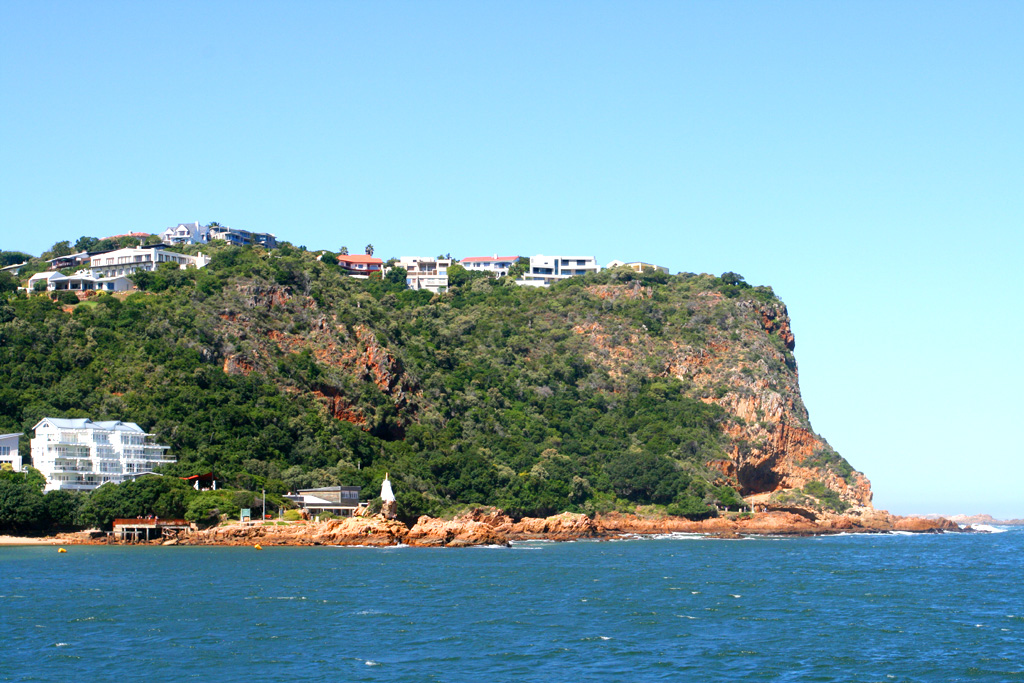
| A cliff bordered the left of the Head
|
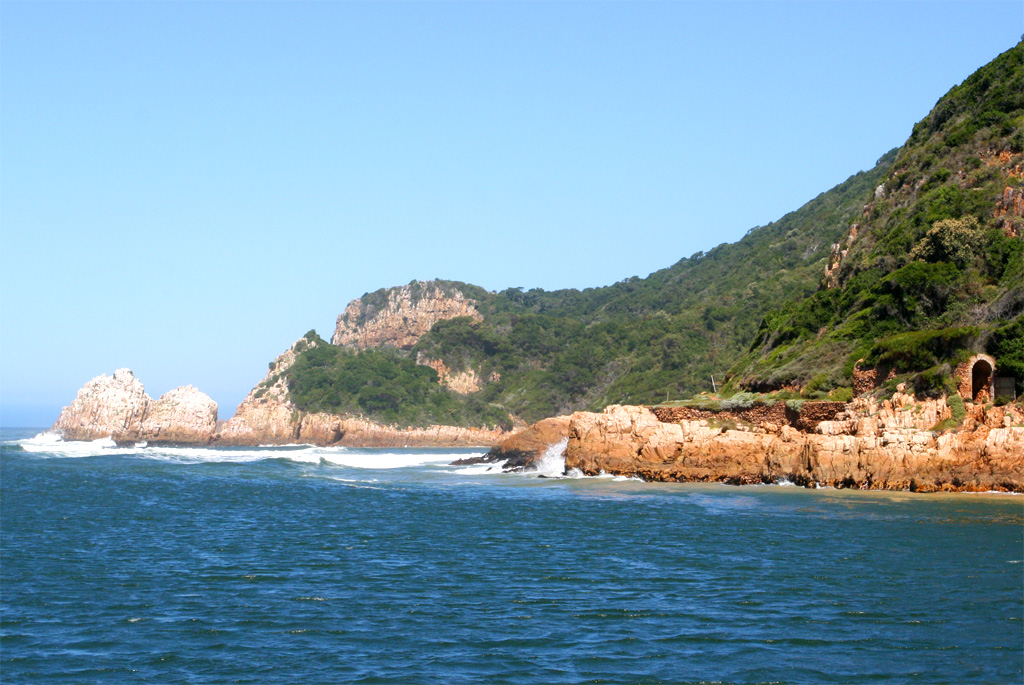
| A rock bordered the right of the Head
|
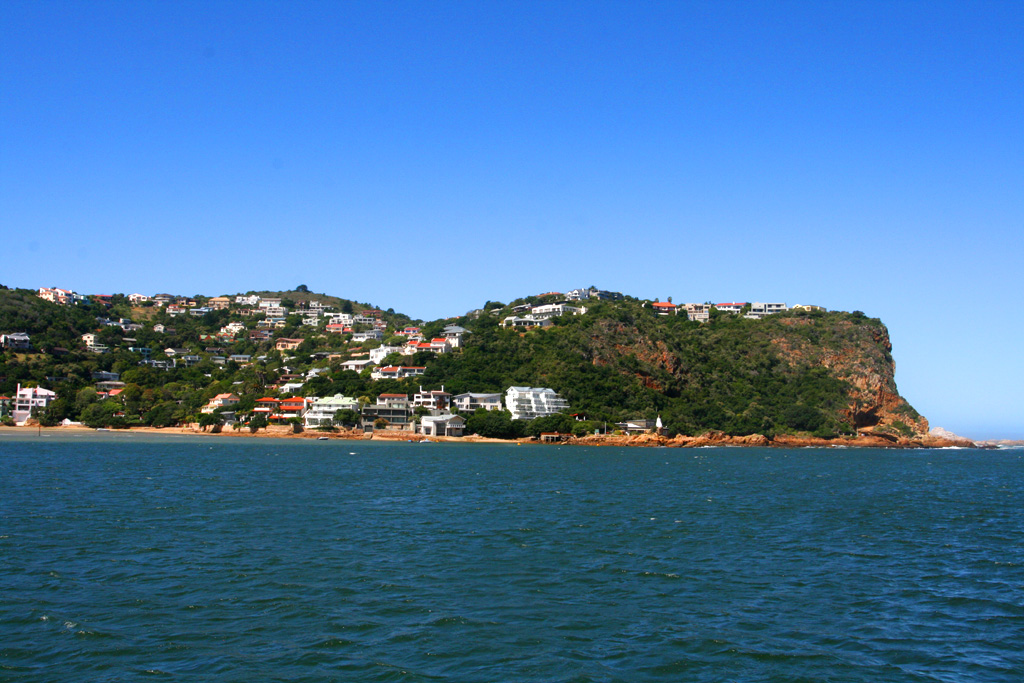
| This is an expensive location
|
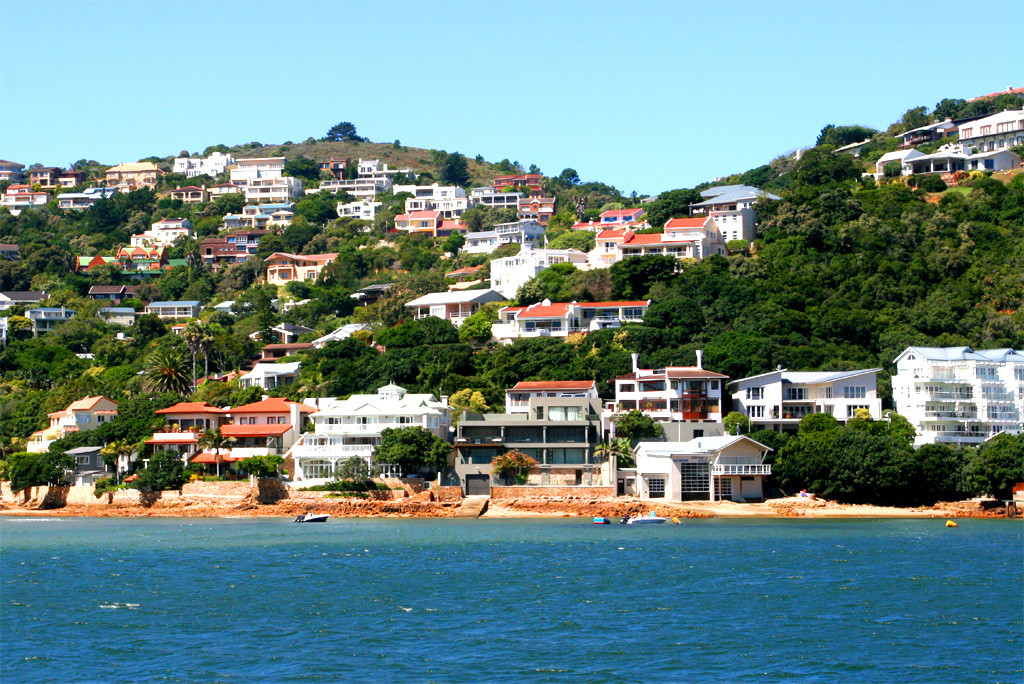
| with many vacation homes
|
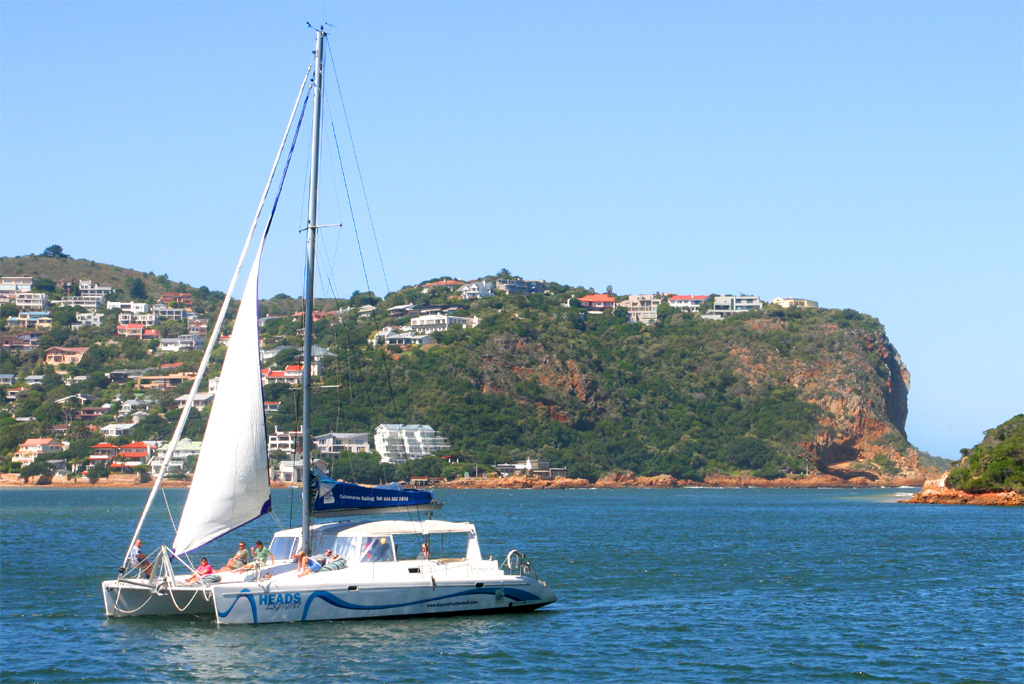
| Living up there and sailing down below would be nice
|
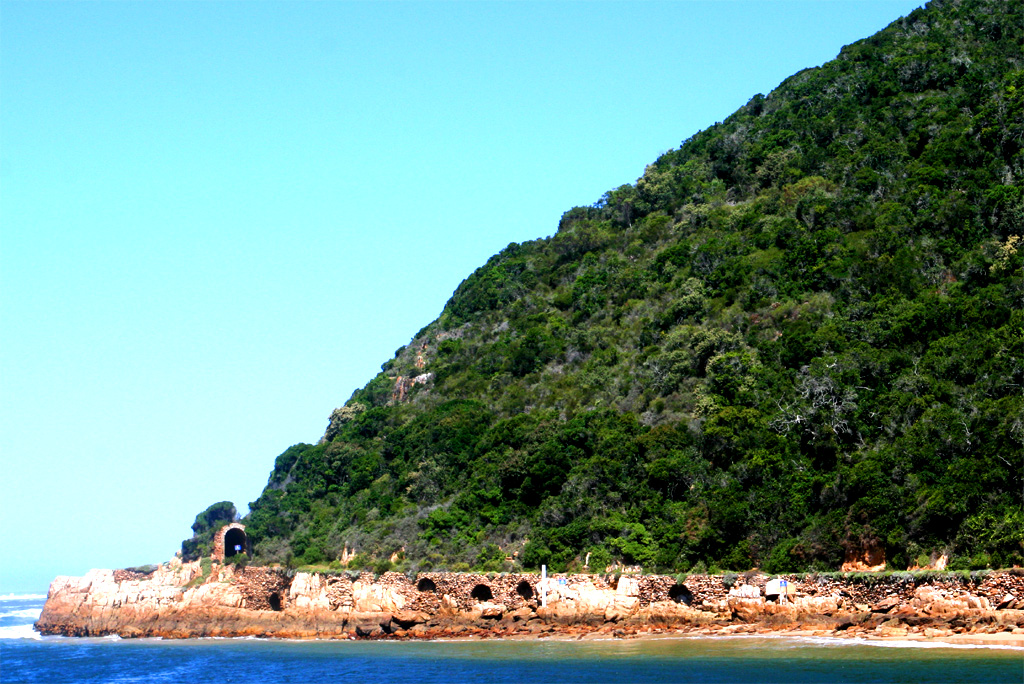
| Or trekking in the Featherbed Nature Reserve for exercise
|
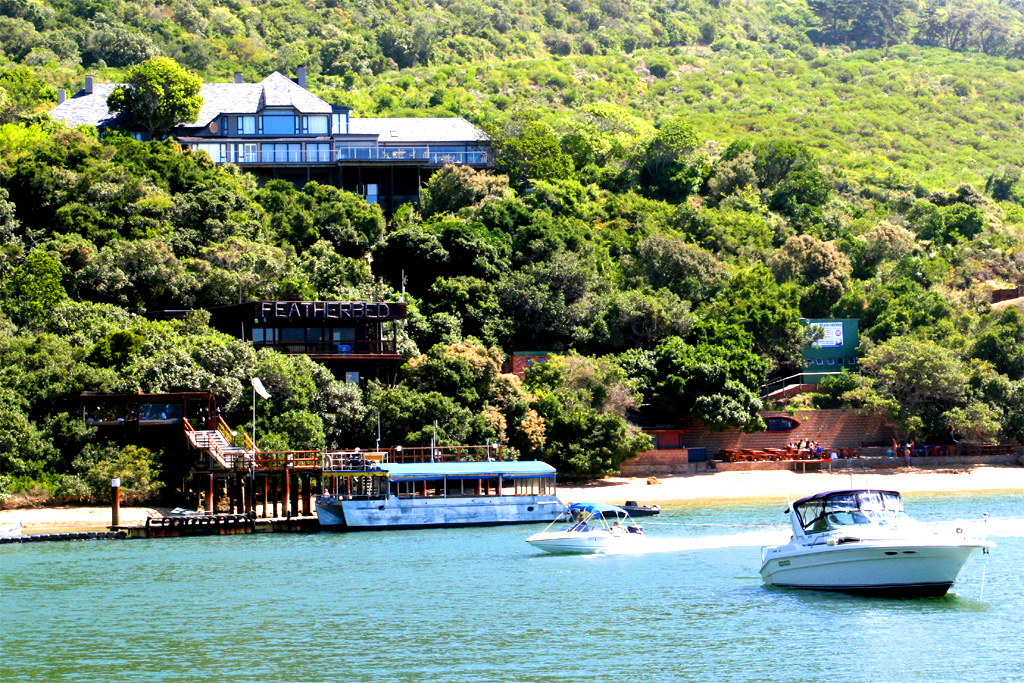
| Nice place for excursions, too
|
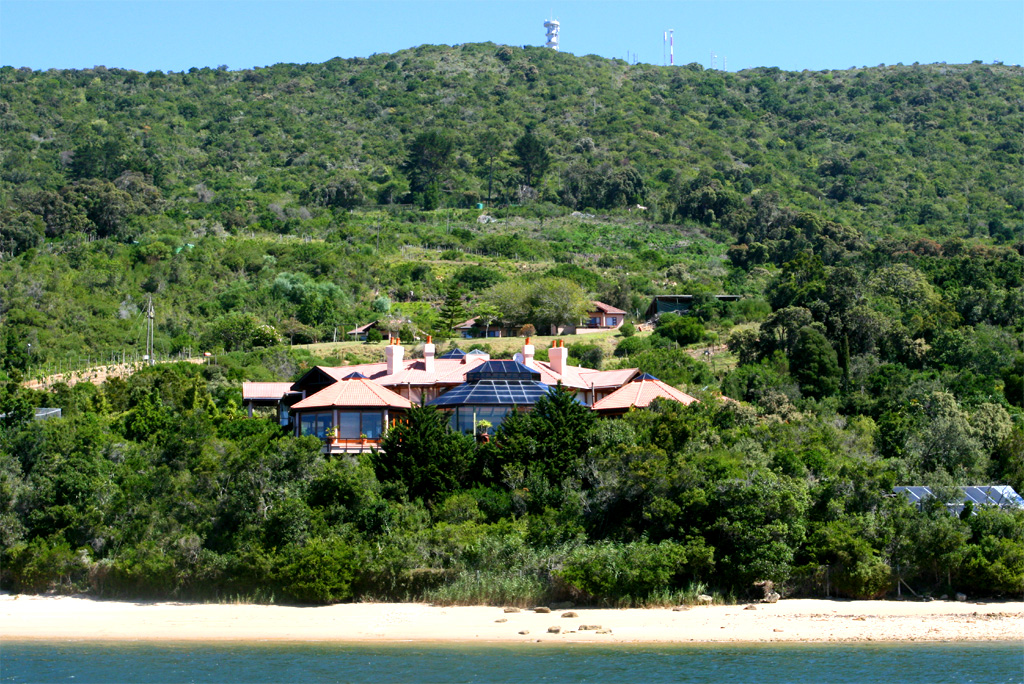
| Nice place to live in the middle of nature
|
Yes, I had to eat some oysters, even if they are not my favorite sea food. It was more or less a must because Knysna is very famous for their oysters. There is even an oyster festival in July. So I had to try and they tasted really delicious with a lot of lemon juice and hot pepper sauce. One oyster did cost 1.00 Euro and I had only 6 as you can see. Together with a glass of wine and a big ice cream the bill of the Pescador Restaurant came up to 9.50 Euro. In the evening, but before dark, I walked back to Main Street to my favorite Italian restaurant, where I had various dishes and drinks for 4.50 Euro.
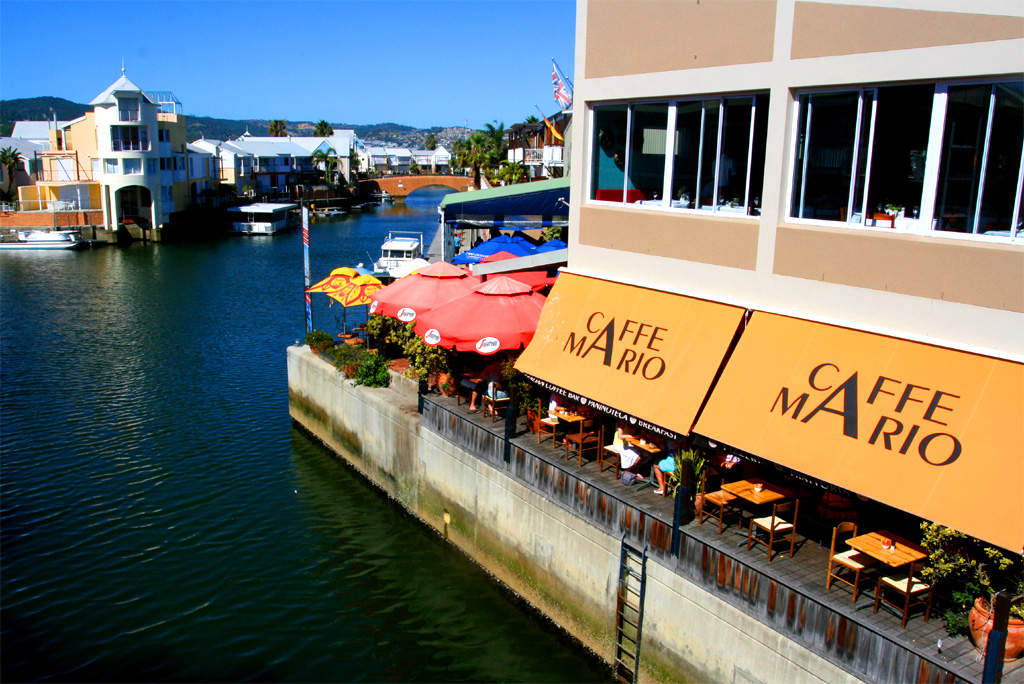
| Back at the Waterfront center
|
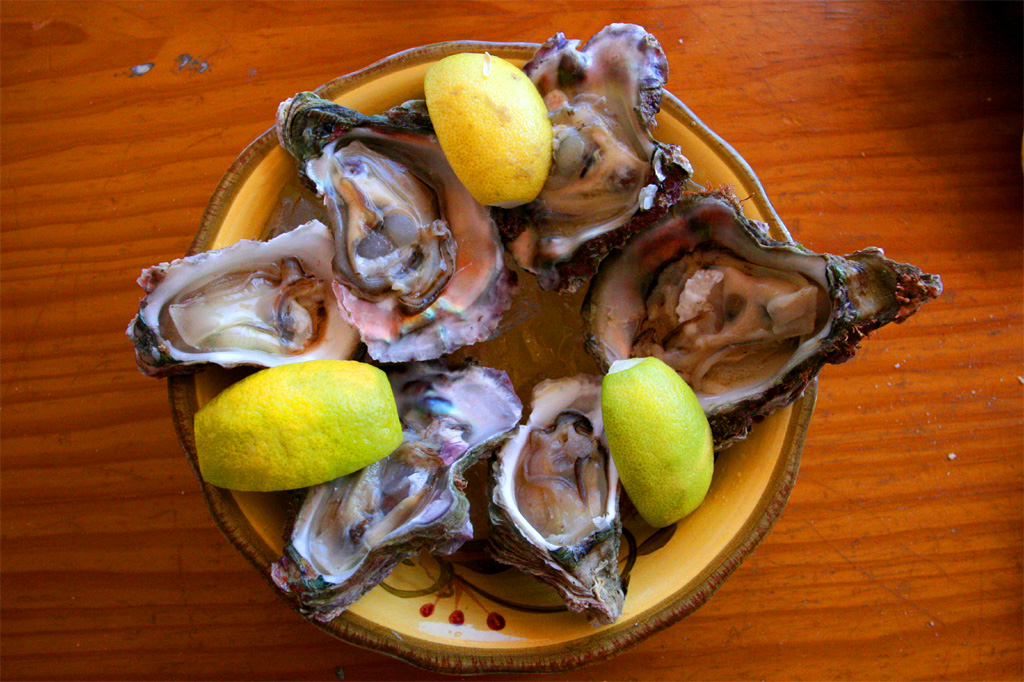
| Having some oysters in a restaurant
|
Next morning I went to the Knysna Mall on Main Street where I ate breakfast at the M&B (Mug and Bean) restaurant. The breakfast was called "The Famous One" and it probably was called that way because it was so good and big I hardly could finish it. It did cost 4.60 Euro including a big pot of English tea. Yes, I always have to mention the prices just to remind you of how good and cheap the food is in South Africa.
After that I just walked around and met three girls just singing. They told me that they were rehearsing for a play. Then I was browsing through the shops and landed at a book store where I checked the literature about South Africa. One book was especially interesting to me: "The Fall of the ANC". As mentioned before I will tell more about politics at the end of my report.
I experienced a leisurely afternoon while reading and then walking in the streets and visiting another backpackers hostel, the "Island Vibe". Contrary to the description in the Lonely Planet I didn't like it, because it was messy and cramped and thus I cannot recommend it.
At around 5 p.m. I left Knysna by BazBus again and arrived in Plettenberg Bay at around 6 p.m.
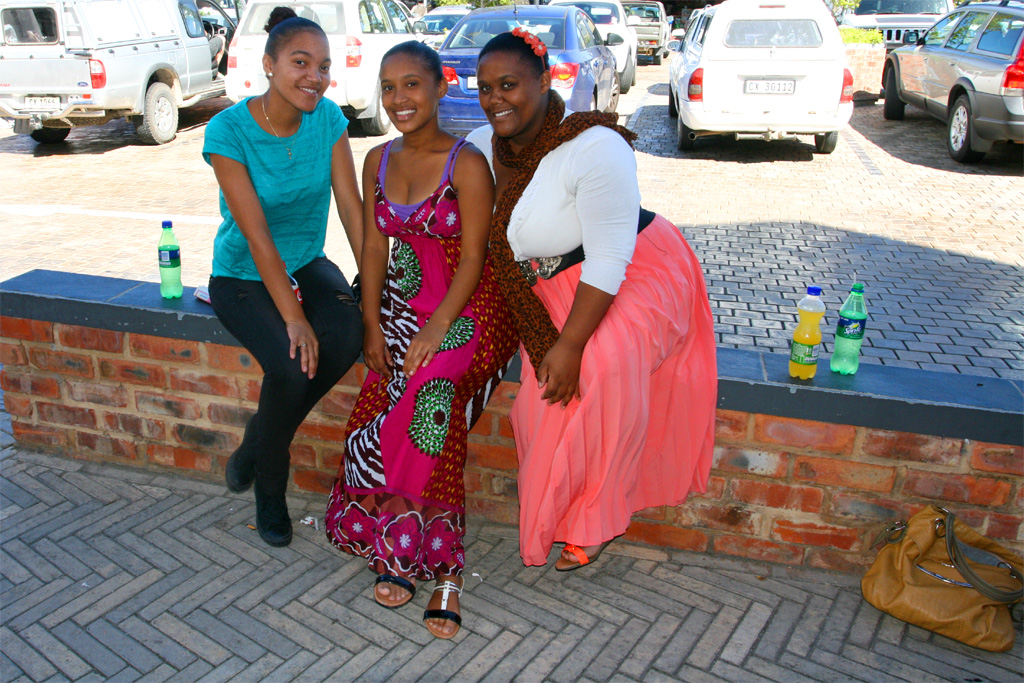
| Rehearsing singer in the Knysna Mall
|
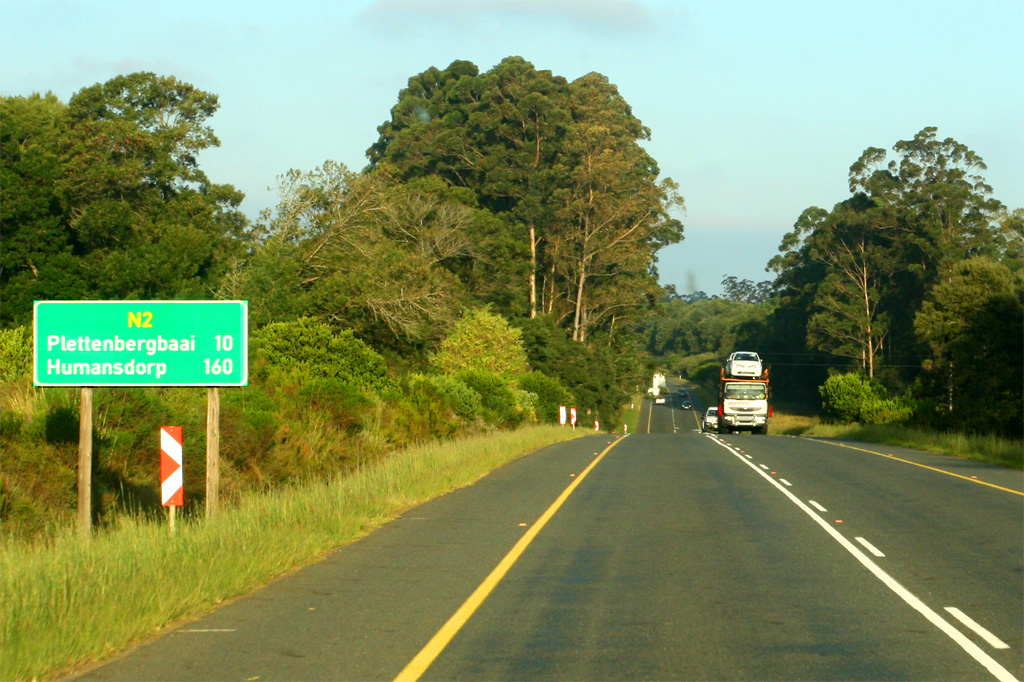
| On the way to Plettenberg Bay
|
Plettenberg Bay
I have chosen to stay in Plettenberg Bay three nights because of the monkeys, birds and wild cats, like jaguars and cheetas. I made reservation one day before my arrival at the
Albergo for Backpackers
8 Church Street
Plettenberg Bay
Tel.:+27 44 5334434
www.albergo.co.za
|
and paid 26.00 Euro per night for a double room ensuite on my arrival. It was a nice place and the owner couple was very nice too. It also was a nice location, just 100 meters to the Main Street with many restaurants. But I still felt uneasy when I walked along Main Street in the dark in the evening of my arrival, because of the blacks hanging around and one even was insulting guests sitting on the terrace of a restaurant. Hardly any whites in the street but the restaurant were full of them. One of the restaurants was the "Mozambican". I ordered a squids dish but it was terrible and overpriced with 9.00 Euro (including a glass wine, though) compared to the prices I have paid before. Maybe I should have tried a dozen of the famous "Laurenco Marques" prawns for 21.00 Euro.
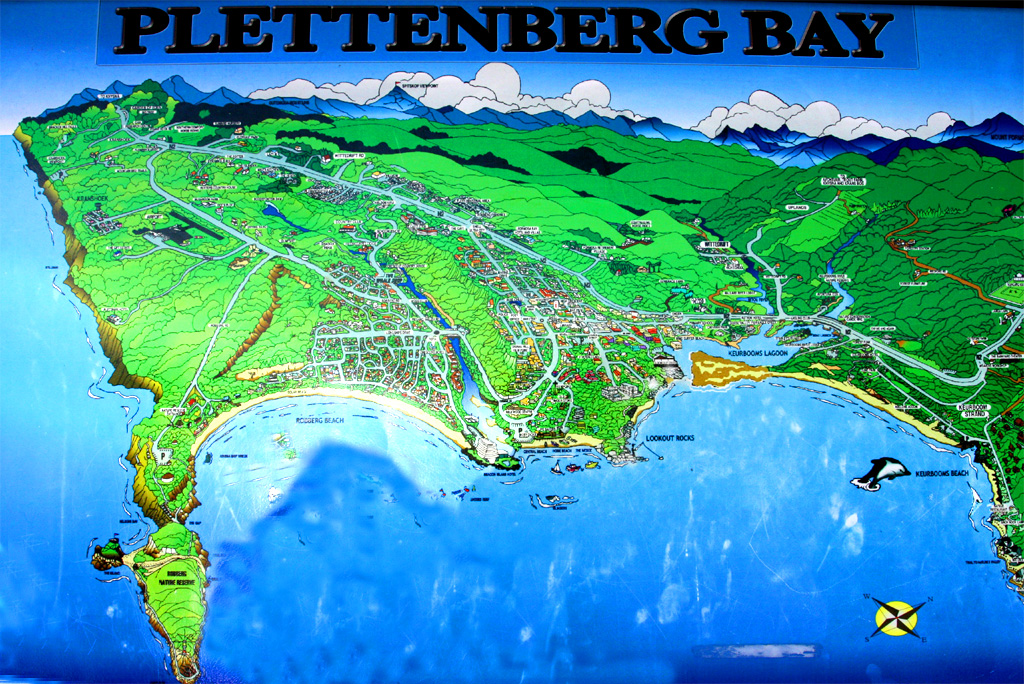
| Map of Plettenberg Bay
|
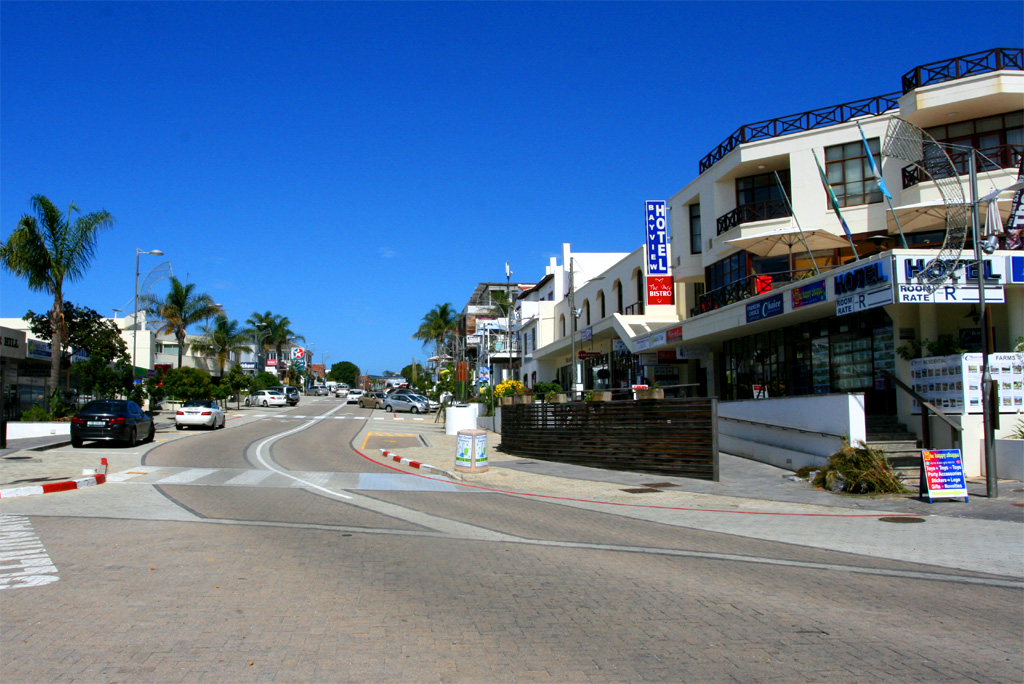
| Main Street in Plettenberg Bay
|
Next morning I walked down to the Lookout Restaurant just right at the beach where I had breakfast. And what a breakfast. Take a look at what I did get for 3.70 Euro. Also here the restaurant was full of white guests. Many guests, because it was a big place. After breakfast I inspected the beach and the area around. I felt like in England but in the sunshine.
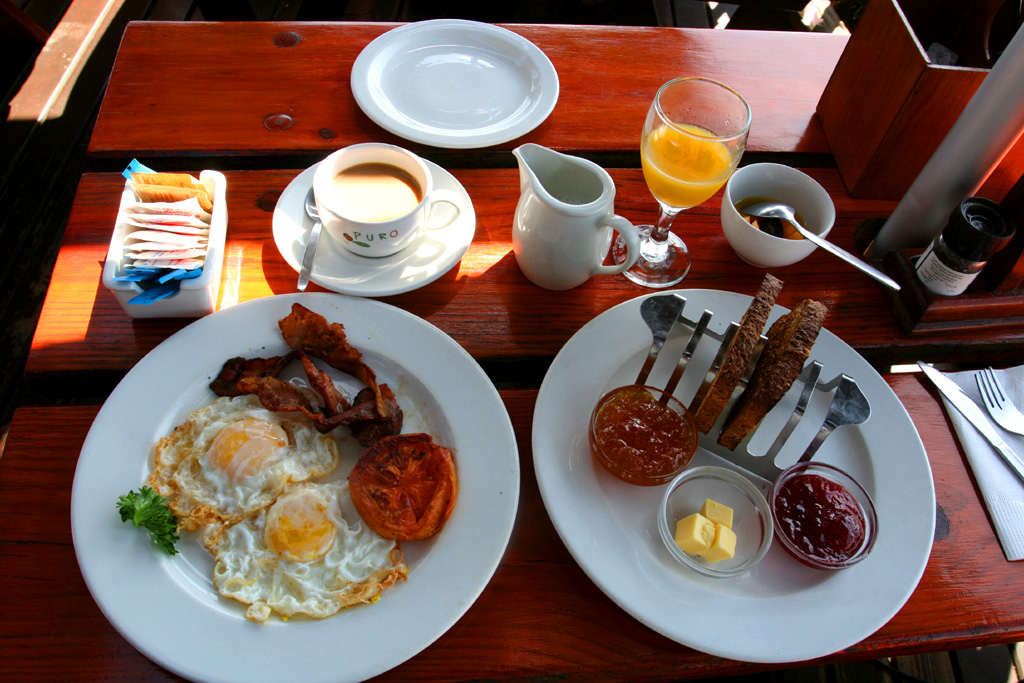
| Having breakfast at the Lookout Restaurant
|
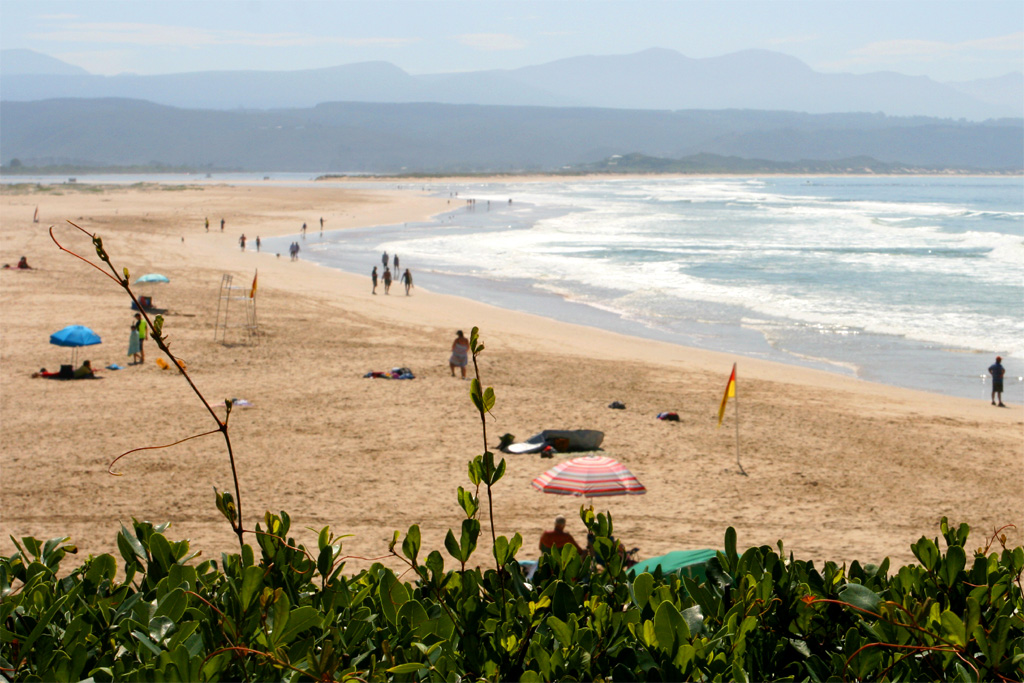
| with a beautiful view to the beach
|
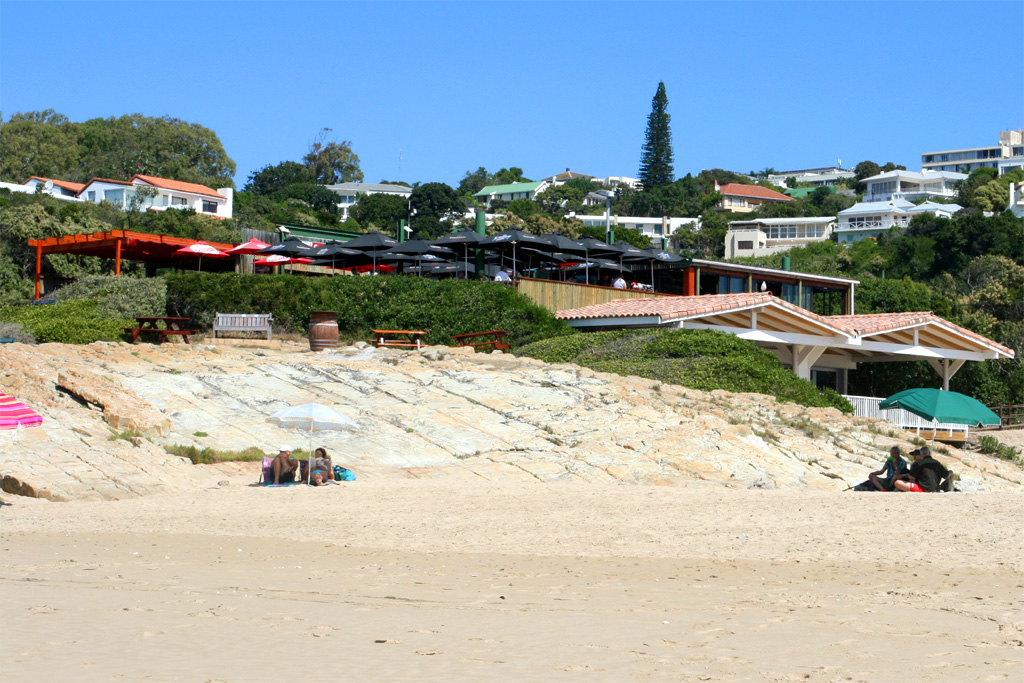
| Looking up to the Lookout Restaurant
|
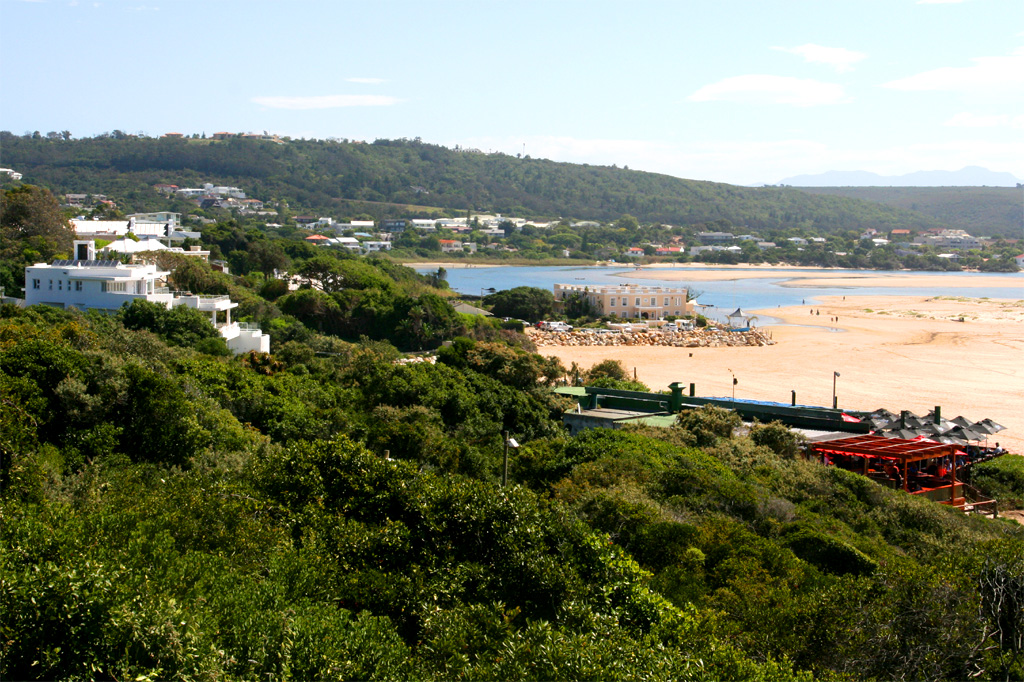
| Looking down from the Lookout Restaurant
|
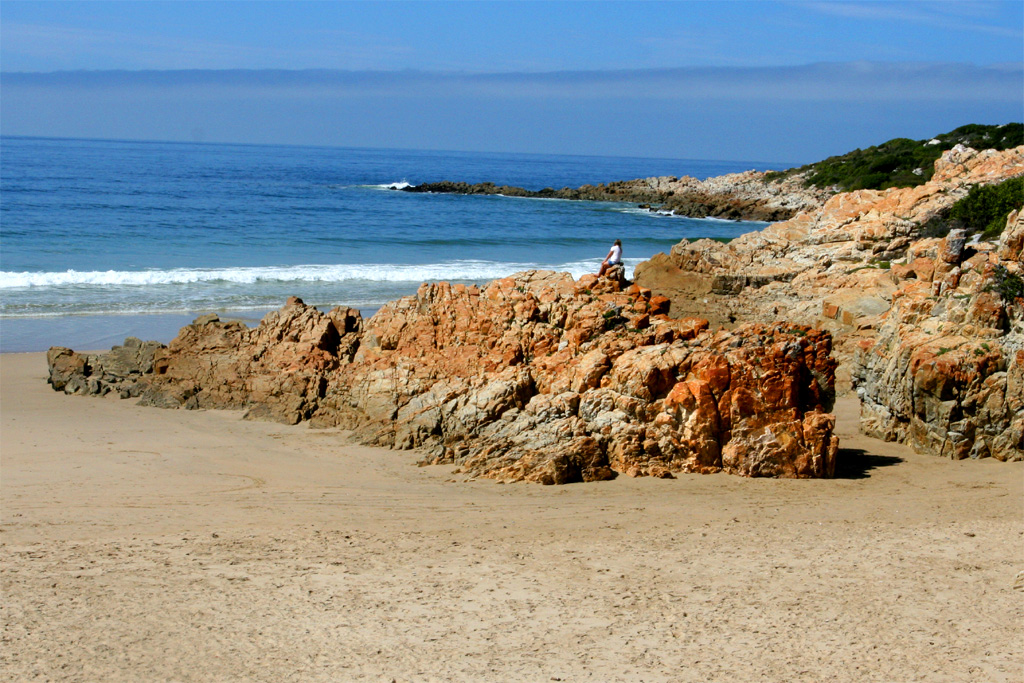
| Rocks on the beach
|
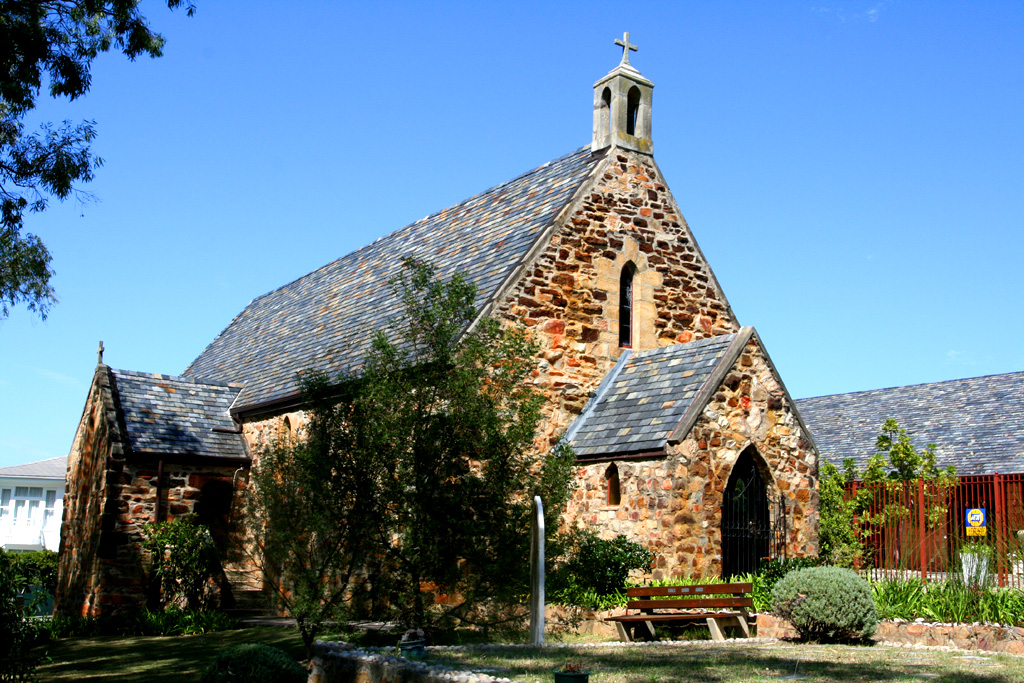
| An old church made of rocks
|
Plettenberg Bay has a lot to offer. Many come here for vacation or holiday. A five star resort is the Beacon Island Resort
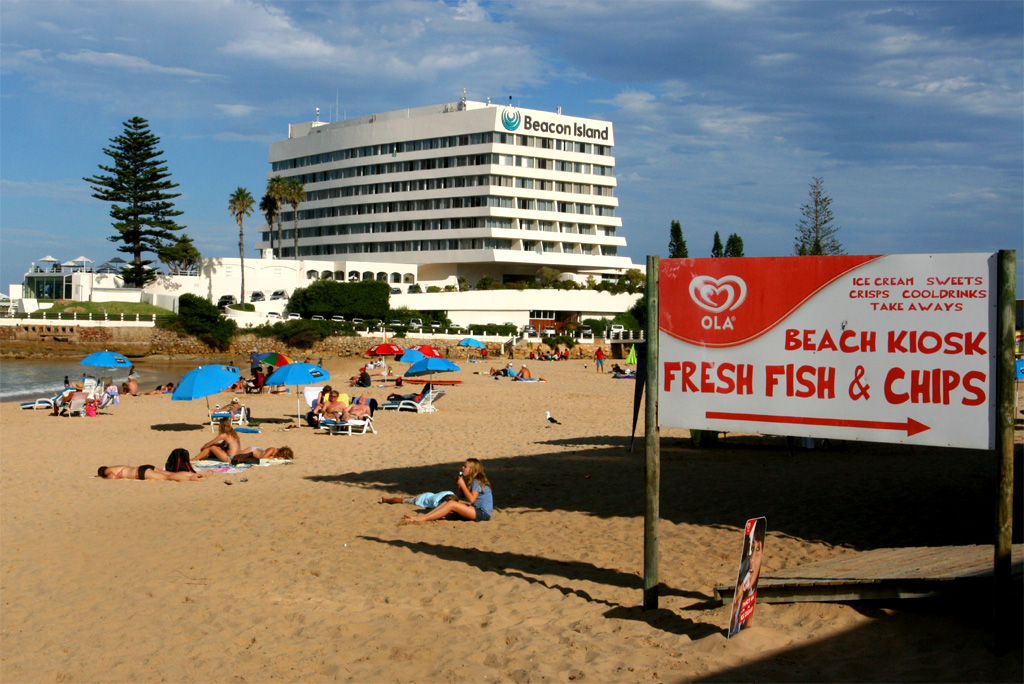
| Beacon Island Resort
|
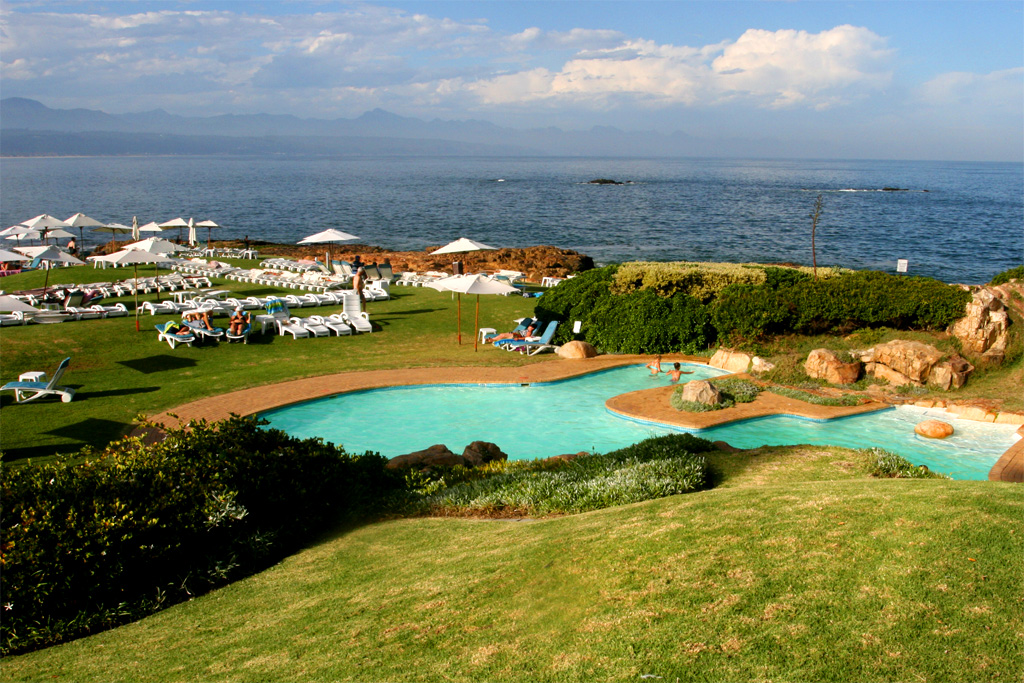
| with a nice landscape
|
I have chosen the "Albergo", because it offers all the tours around Plettenberg Bay, even with a 10% discount for some animal parks. There are many parks to choose from, but there was no other tourist to join me. Most young backpackers wanted adventure and an adrenalin boost. Two young German ladies booked the bungy jump from 216 meters high, the highest in the world, I was told. But at least we booked the same van to bring us to our destinations. My share was 14.00 Euro for the transport back and forth. My destinations were the "Monkeyland" and the "Birds of Eden" (entrance fee combined was 16.00 Euro) and the "Tenikwa Wildlife Awareness Center" (entrance fee was 12.00 Euro).
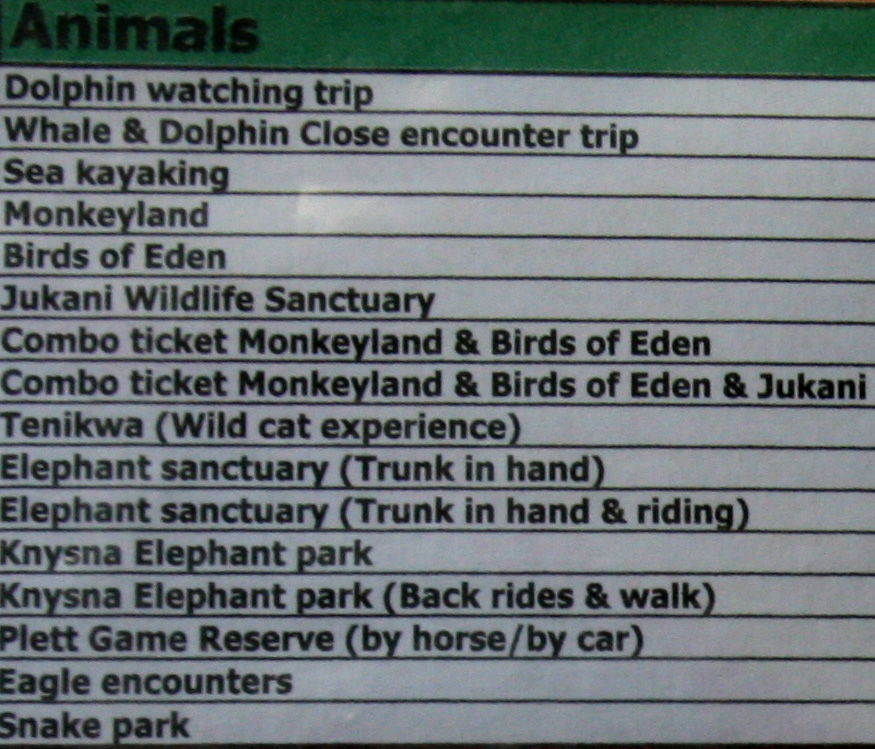
| What animal tour to join
|
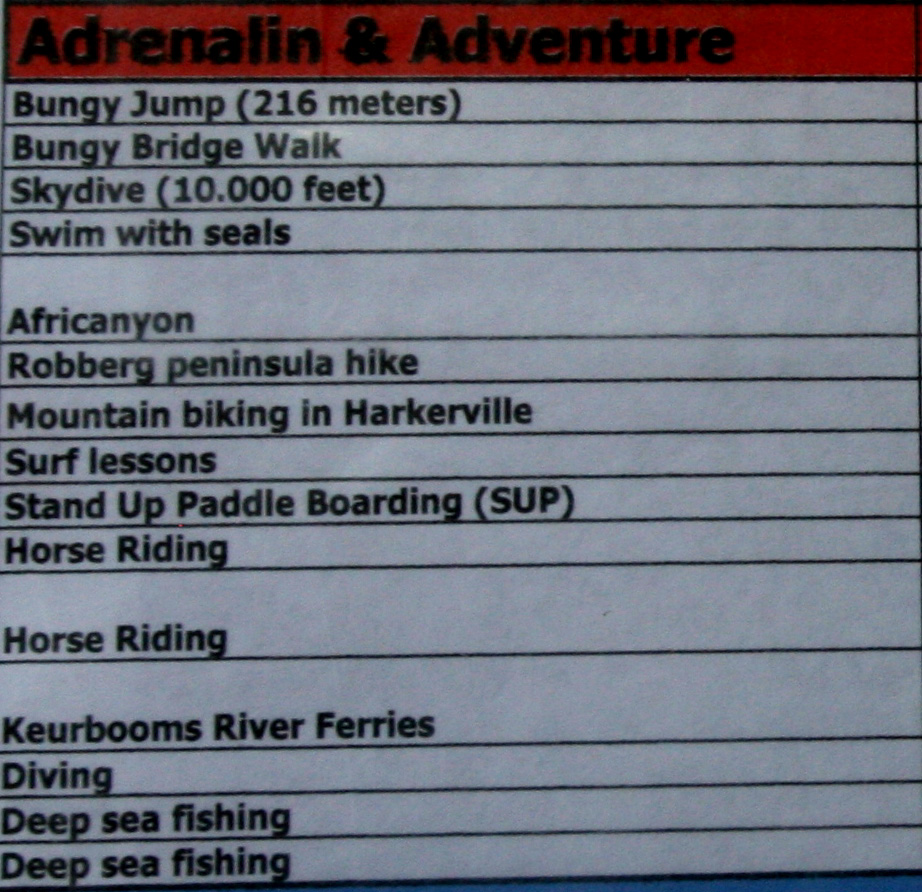
| or something with an adrenalin boost
|
You cannot walk on your own in the "Monkeyland Primates Resort". You have to join a "safari" led by a game ranger who explains what this sanctuary is all about. You can look up its internet site
www.monkeyland.co.za. If you want to see more photos then click
animals.
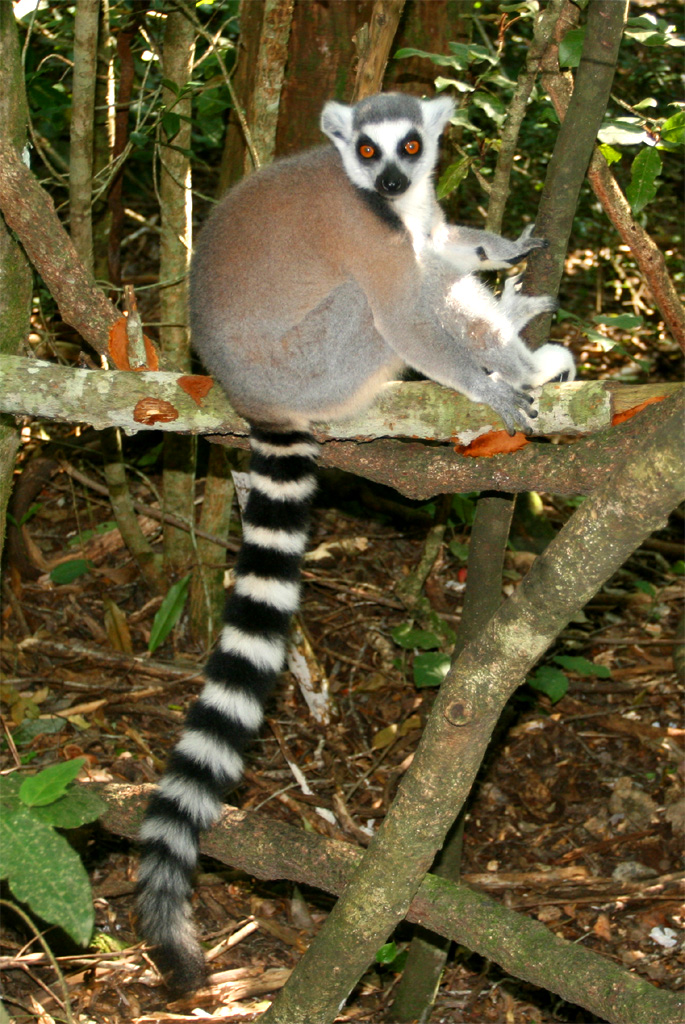
| Monkey with stripe tail
|
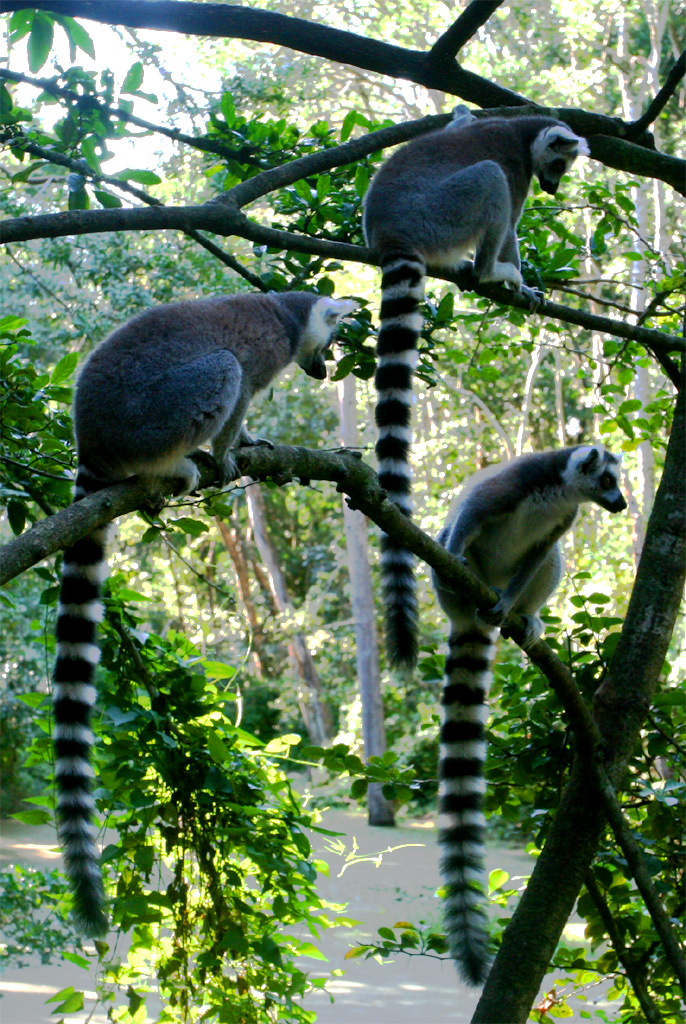
| Three stripe tail monkeys
|
After "Monkeyland" I walked to the adjacent "Birds of Eden". Here you can walk freely around in the park without a guide. It's really huge and covered by a net, so the birds cannot get out. You can also look up its internet site
www.birdsofeden.co.za. If you want to see more photos then click
animals, if you haven't already done so.
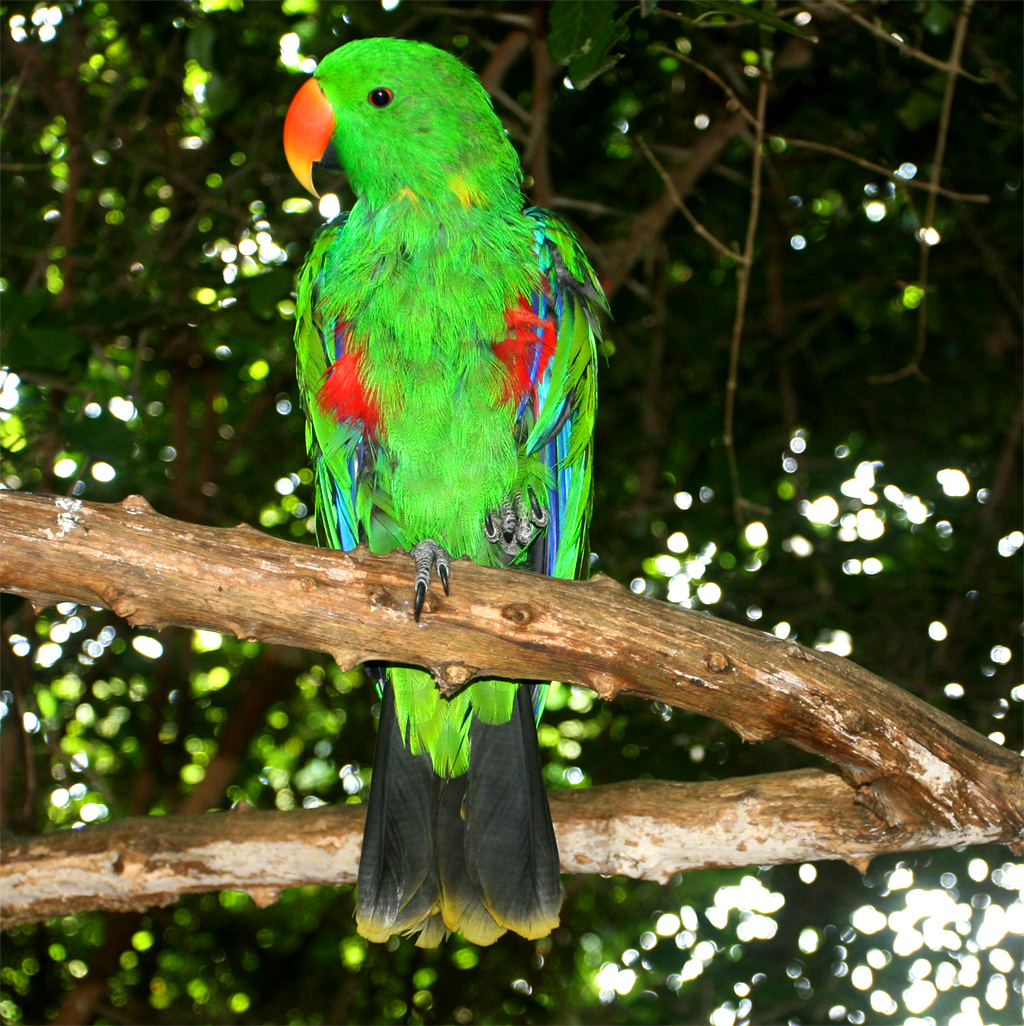
| Colorful bird
|
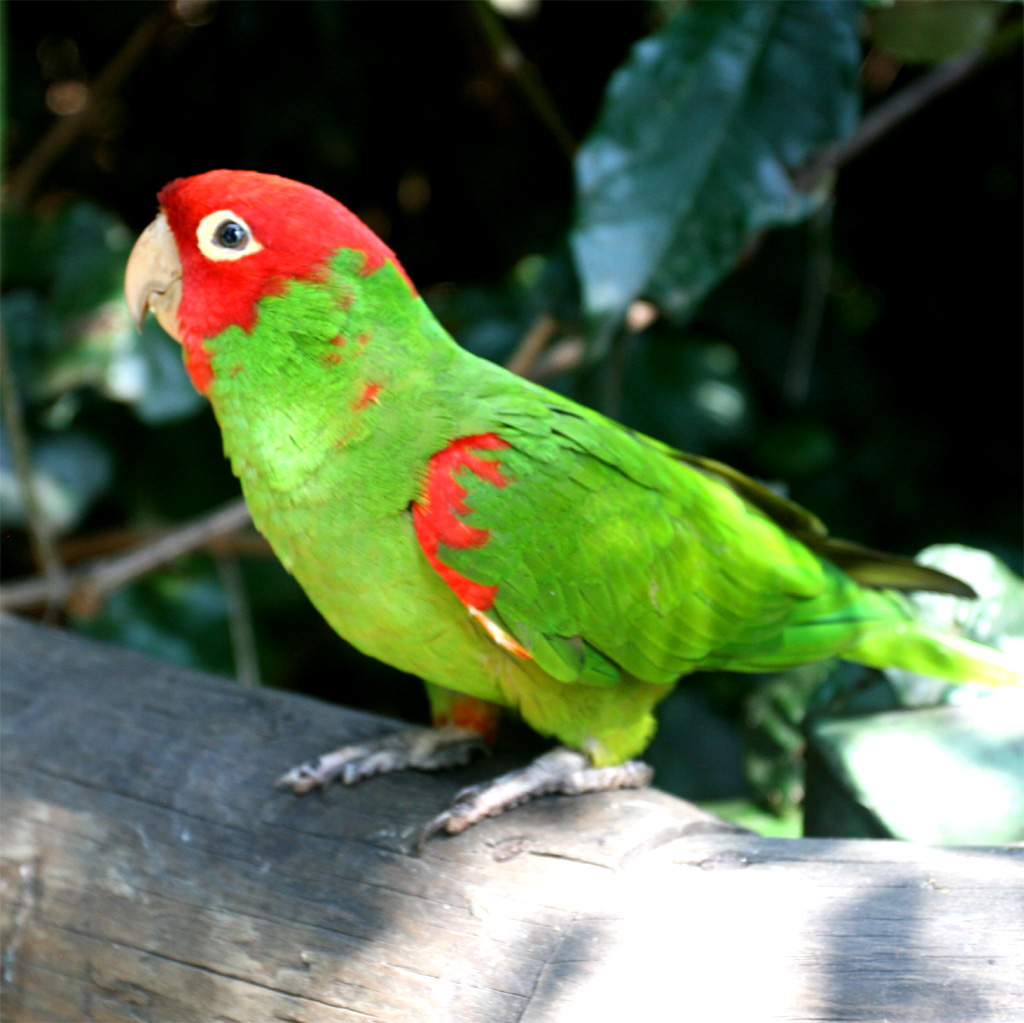
| Cute little bird
|
After "Birds of Eden" I was picked up by my driver to bring me to the "Tenikwa Wildlife Awareness Center". Here you cannot walk on your own but you have to join a ranger to show you around. He will also tell you what this sanctuary is all about. You can also look up its internet site
www.tenikwa.com. If you want to see more photos then click
animals, if you haven't already done so.
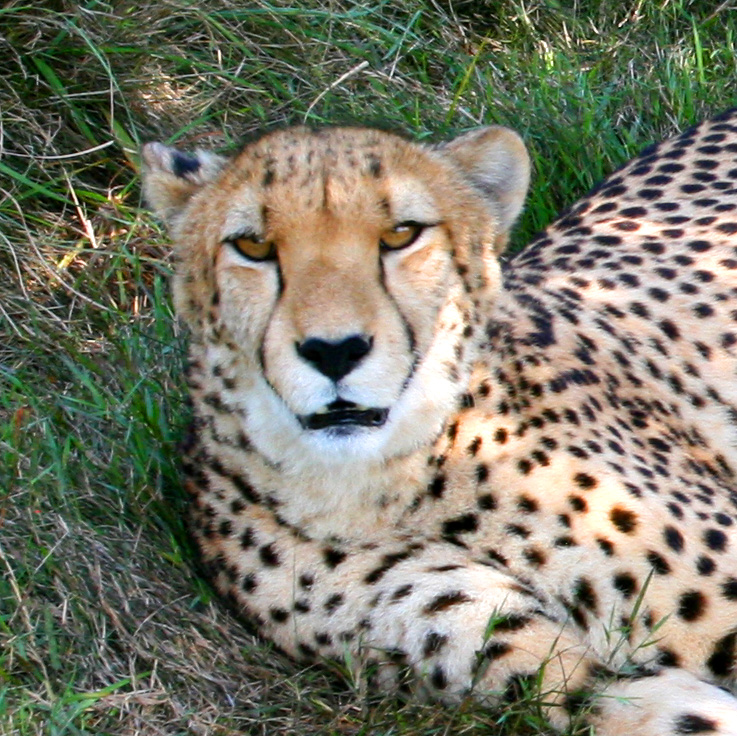
| Cheetah
|
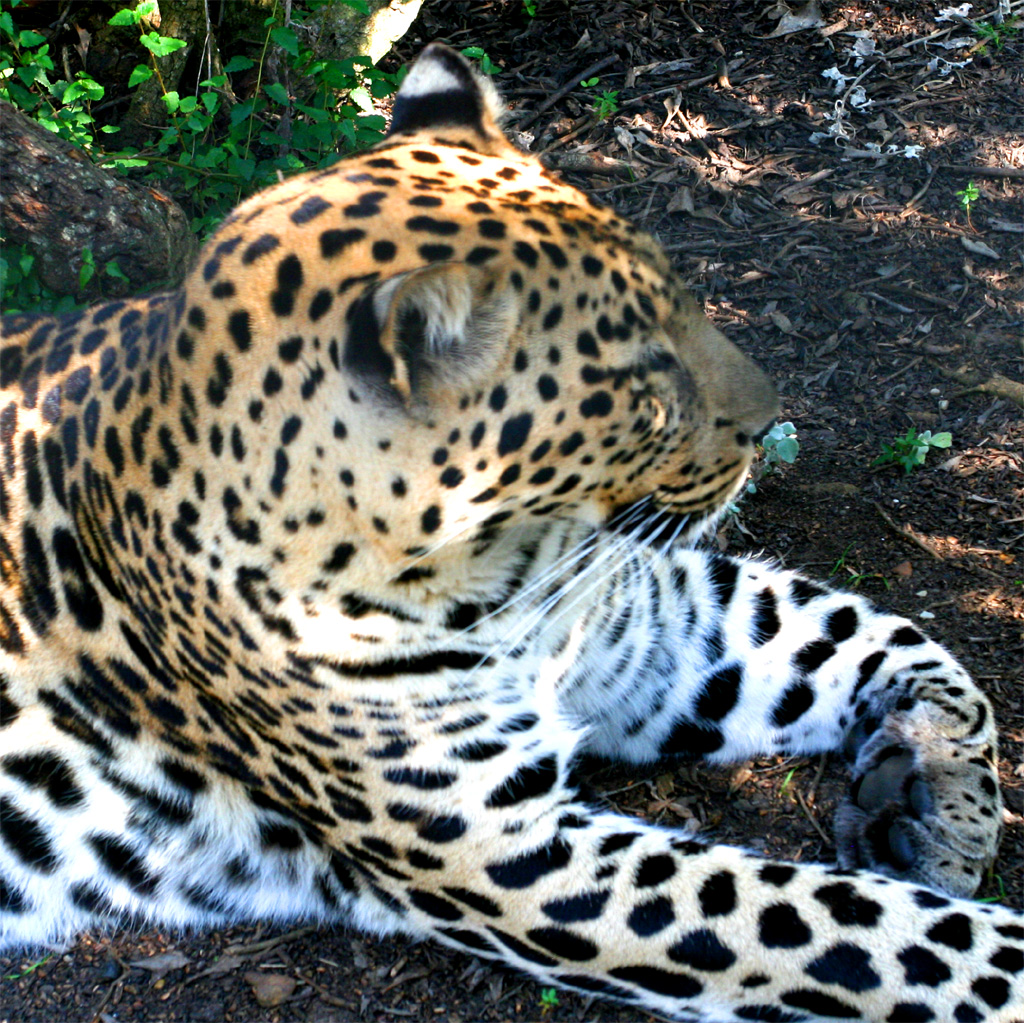
| Leopard
|
In the evening I had dinner at the "Lo Spuntino" restaurant on Main Street. I paid 9.00 Euro for the salmon dish, a Castle beer and a piece of cake as a dessert. All in all much better than the food of the "Mozambican" restaurant.
Next day was my first rainy day in South Africa.
My BazBus was scheduled for 6 p.m. So I had plenty of time for sitting at the computer (for free) in the "Albergo", drinking coffee (for free), reading books (for free), and talking to the owner and other backpackers.
In between at lunch time I had a pizza at the Italian restaurant "Europa" just at the corner of Main Street. In the afternoon I ate a big almond croissant (couldn't finish it) with a café au lait (3.10 Euro) at the "Fournil de Plett" bakery also just around the corner of Main Street.
Port Elisabeth
So I was fully stuffed for my trip to Port Elisabeth or better first to the hostel closest to the Addo Elephant National Park, which was the
Two days before I made reservation for two nights for a double room ensuite for 24.00 Euro per night. I would have to pay another 20 Euro for the pick-up from the BazBus stop-over at a gas station just before Port Elisabeth.
Unfortunately, the BazBus was delayed on that rainy day by 90 minutes.
When we arrived at the pick-up gas station at 11:30 p.m., the owner, John, was already waiting for a lady, Marie, and me. After another hour we arrived at the hostel. Before going to bed I booked for the next day the full day safari including lunch for 67.00 Euro. At 9 a.m. next morning we left the hostel and arrived at the gate at around 10:00 a.m.
The following two photos are just a few of many. I you want to see them all then just hit
Addo Elephant National Park.
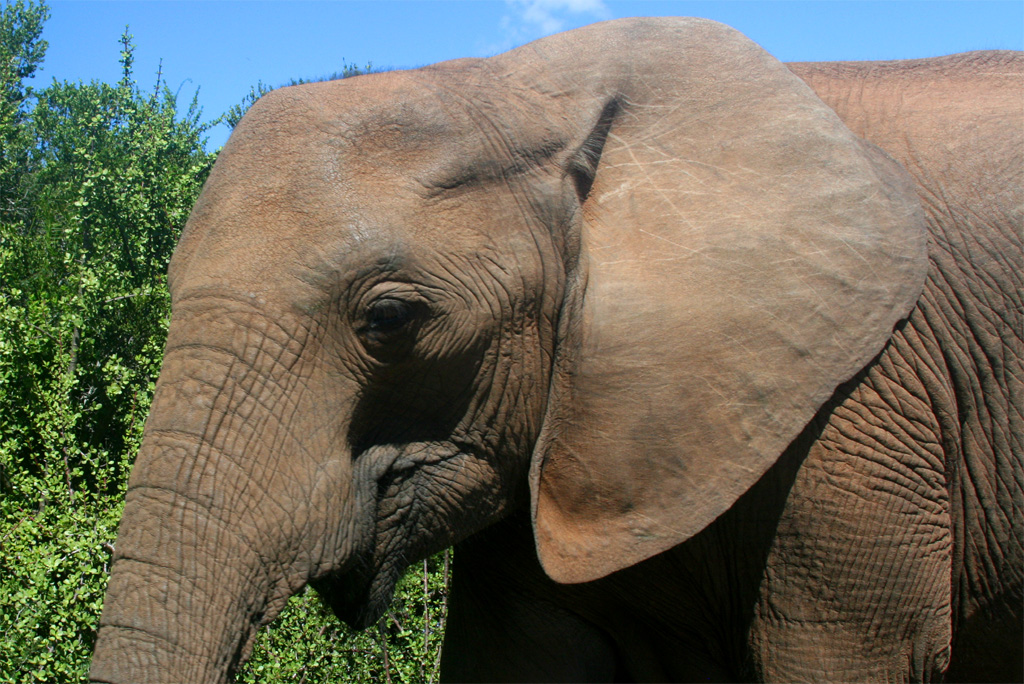
| Close encounter not only with the elephants
|
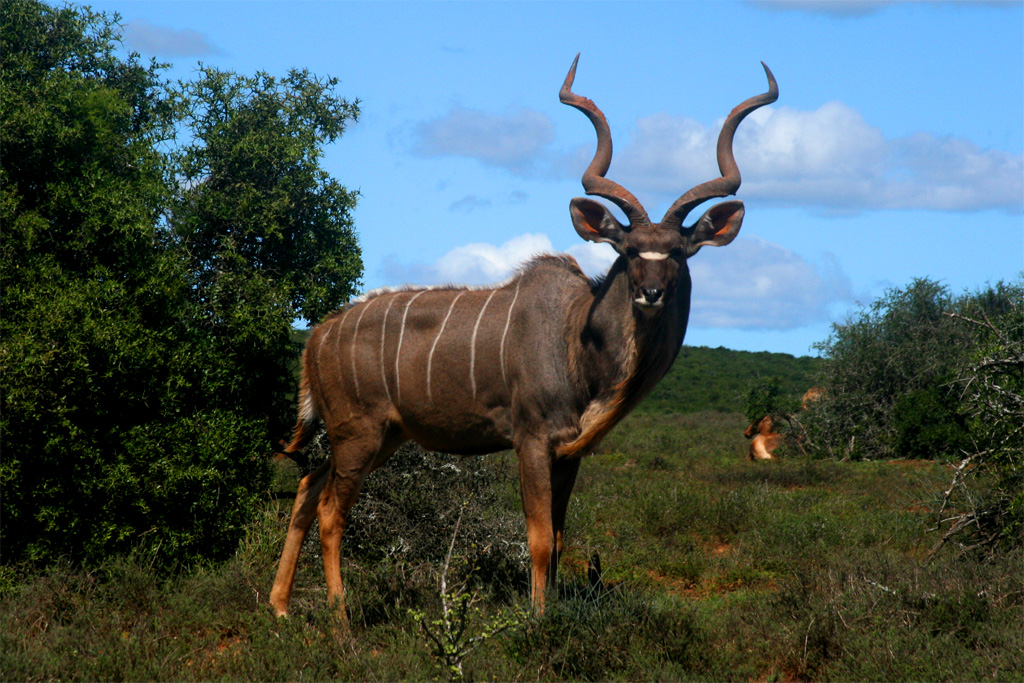
| but also with other animals like a kudu in the Addo
|
We came back from the safari at around 6 p.m. There was no restaurant right in the hostel but a bar around 100 meters from it, managed by John's son. The only available food was a pizza for 2 Euro. Then I had a couple of beers at the campfire.
And there were a lot of people, mostly local young men, who are seemingly gathering here every evening, talking, drinking and having fun. One of the games was the beer glass table tennis, i.e. trying to hit the ball into a beer glass on the other side of the table. So not much else to do around here in the middle of the wilderness.
Next morning John drove us to Port Elisabeth. He charged each of us, Marie and me, 14.00 Euro for the 70 kilometers or so. John did already make reservation for us at the
where I stayed two nights and paid 22.00 Euro per night for the double room ensuite (with bathroom). Actually, that room had four beds and can be also used as a small dormitory. Sometimes, if you book just a dormitory bed, which is much cheaper, then it can happen that you sleep alone, if there are no other backpackers.
This hostel was very conveniently located: Not far from the boardwalk and the beach. The city center, however, was a little farther away. I read that downtown was interesting but a little bit run down. So I didn't go there, also because of my limited time.
And now take a look at "my" surrounding.
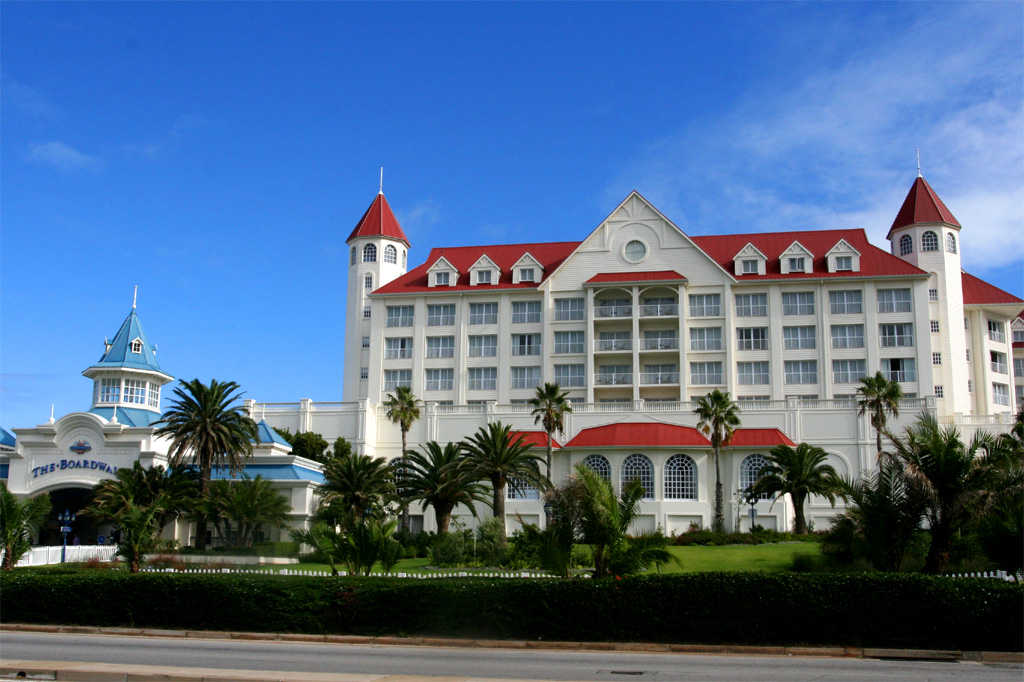
| Not my Lungile Backpackers but the Boardwalk Hotel
|
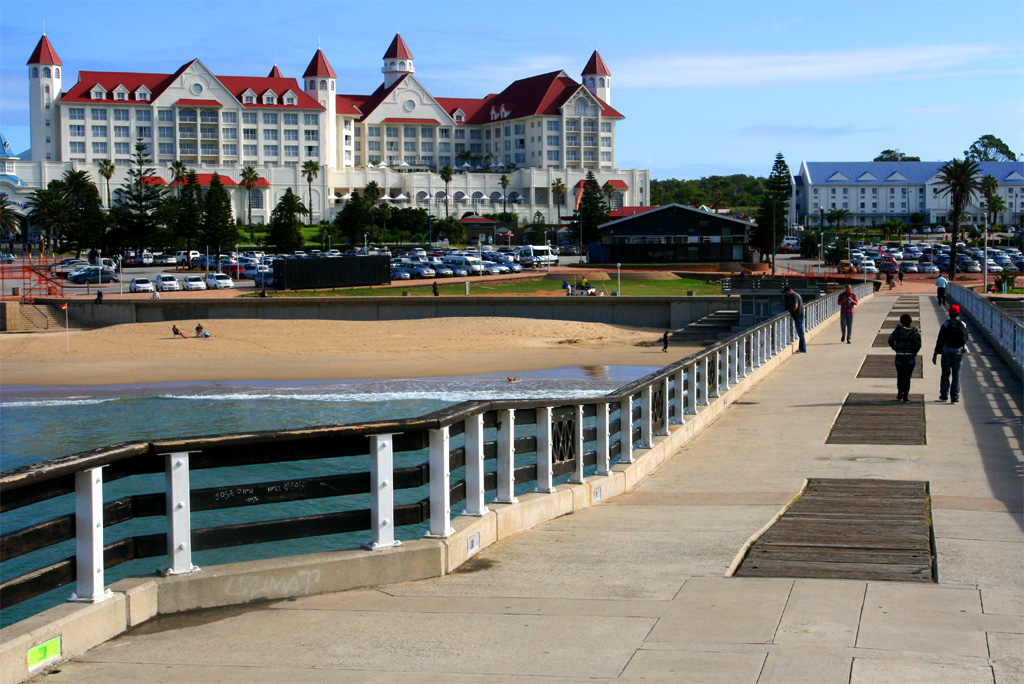
| with the beach and pier and boardwalk in front
|
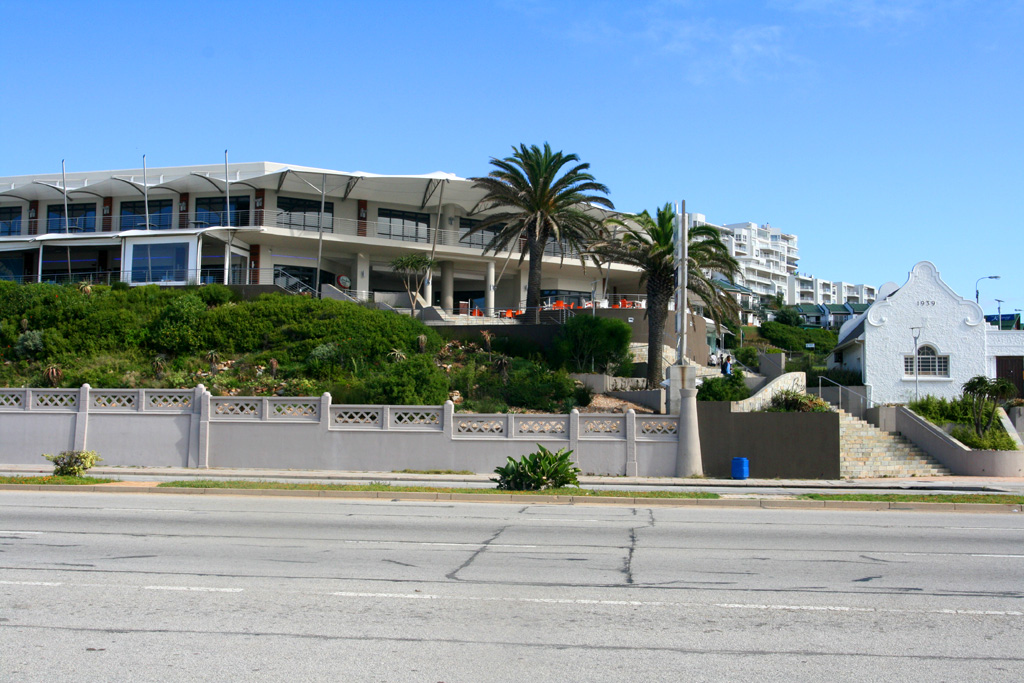
| My breakfast restaurant around the corner from the Lungile
|
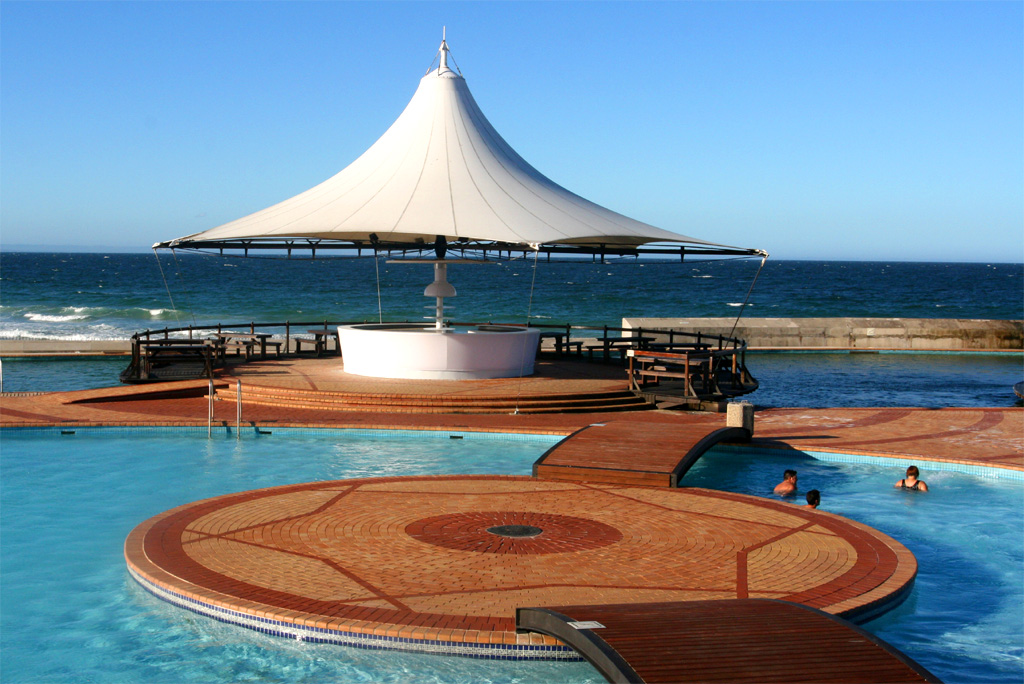
| And my swimming pool down the street from my Lungile
|
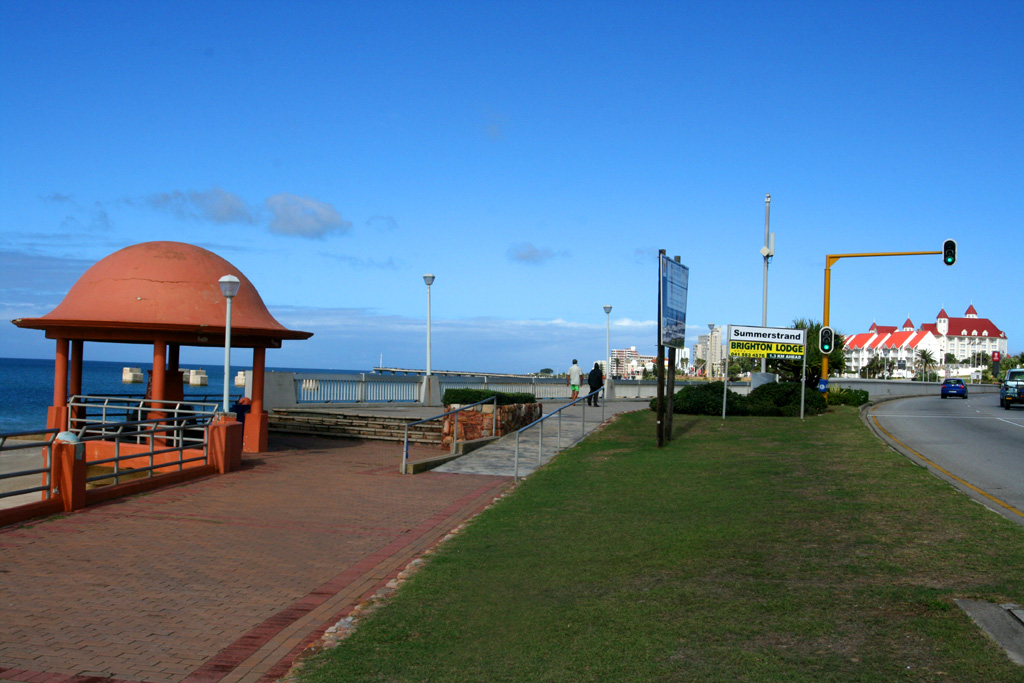
| The boardwalk along the Summerstrand to the east
|
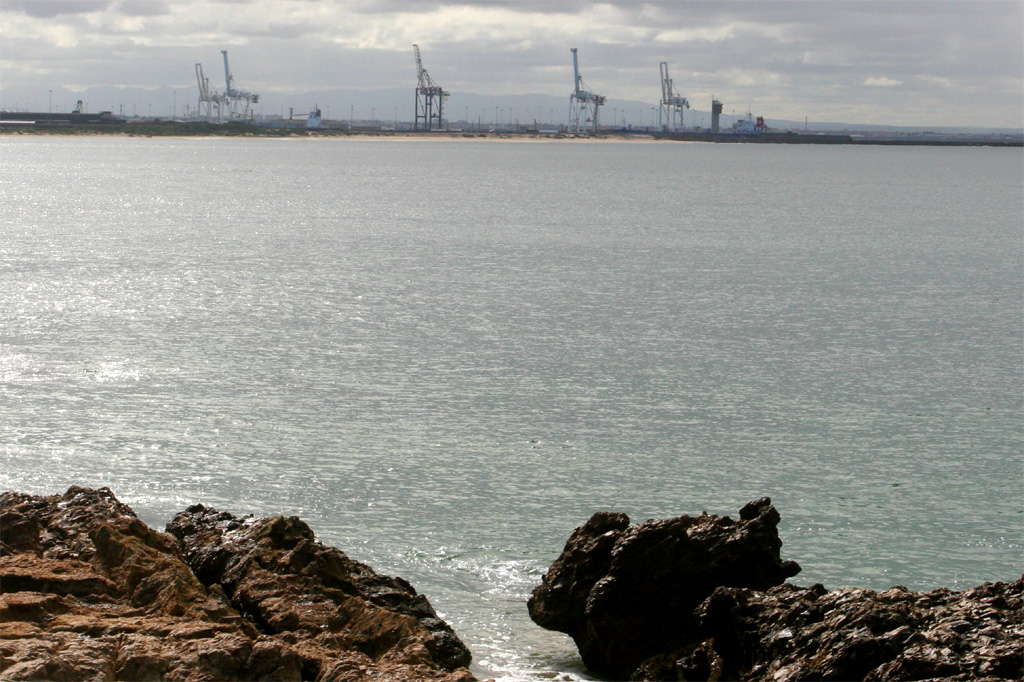
| And this was the view to the harbor in the west
|
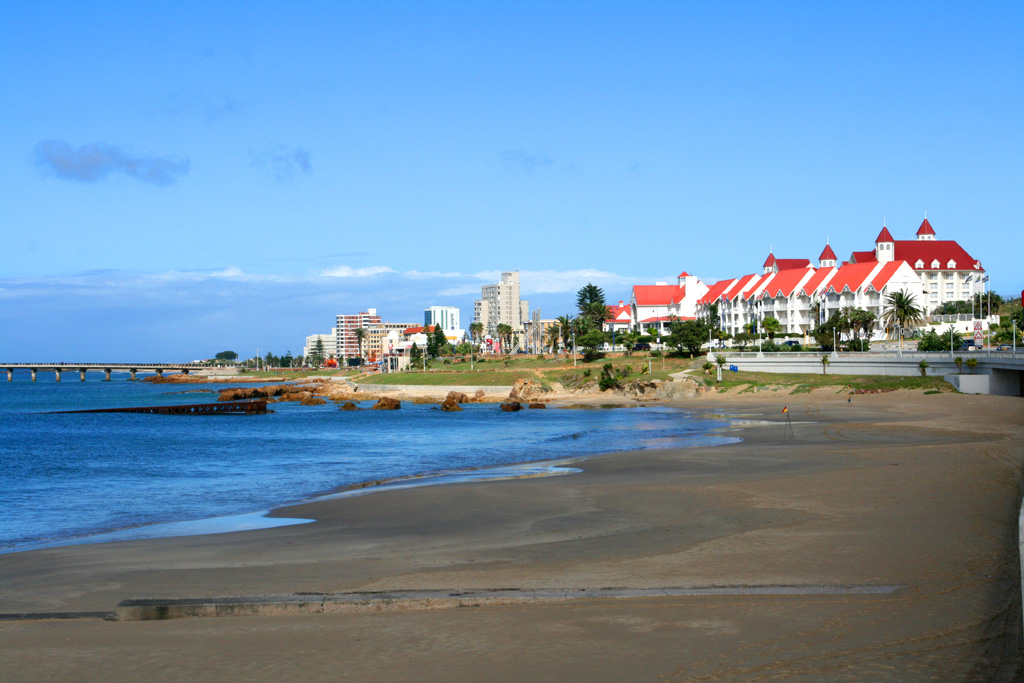
| Walking further along the Summerstrand to the east
|
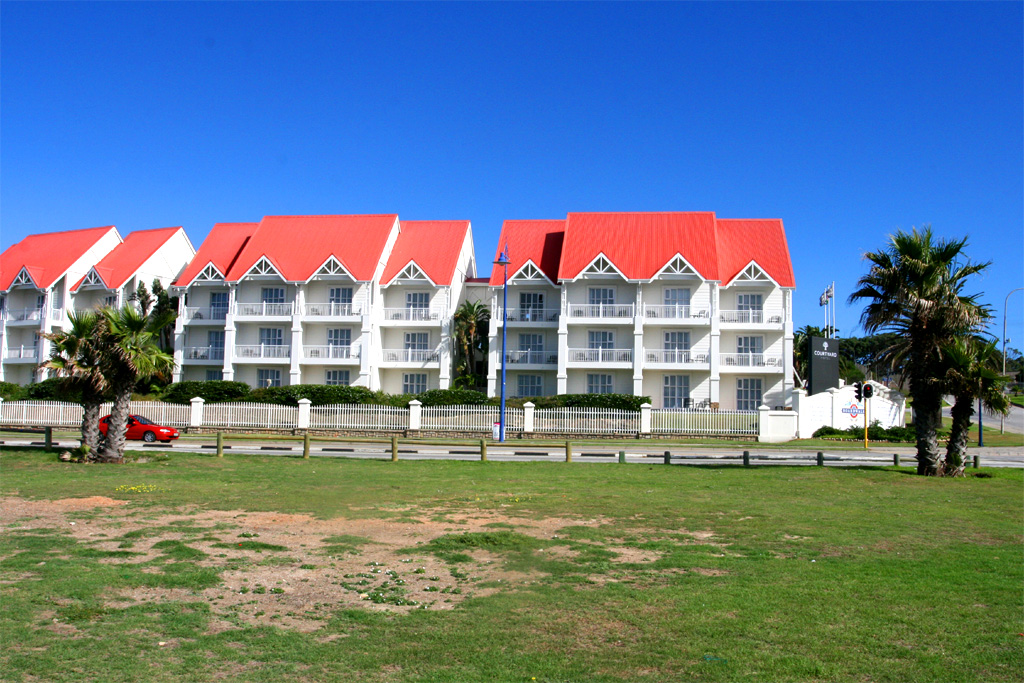
| while passing new apartment buildings on the right
|
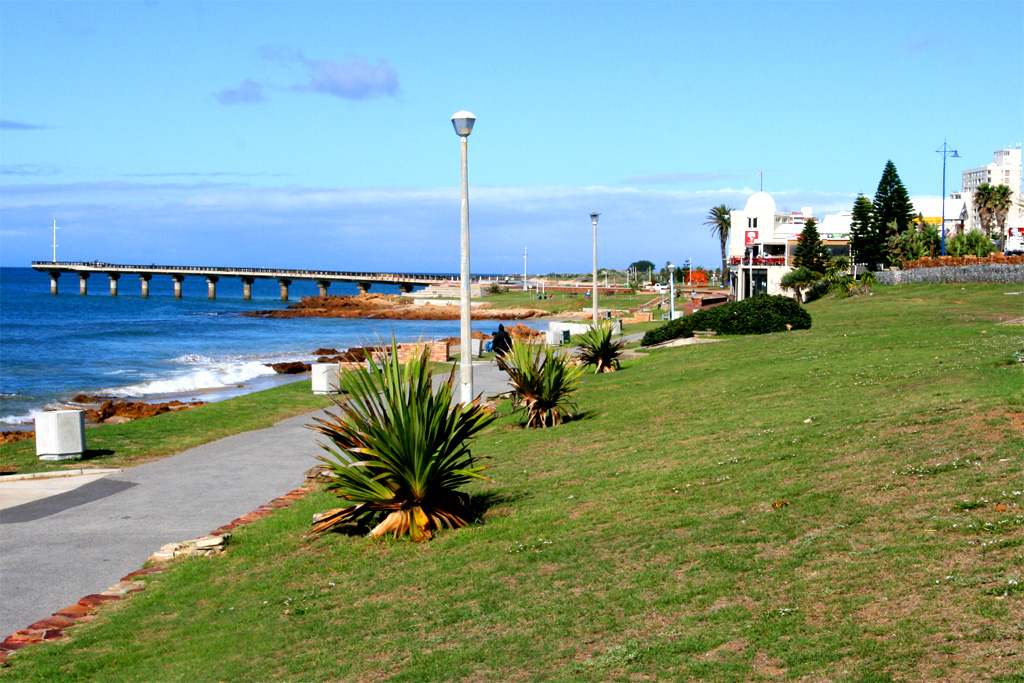
| Looking from here along the boardwalk to the pier
|
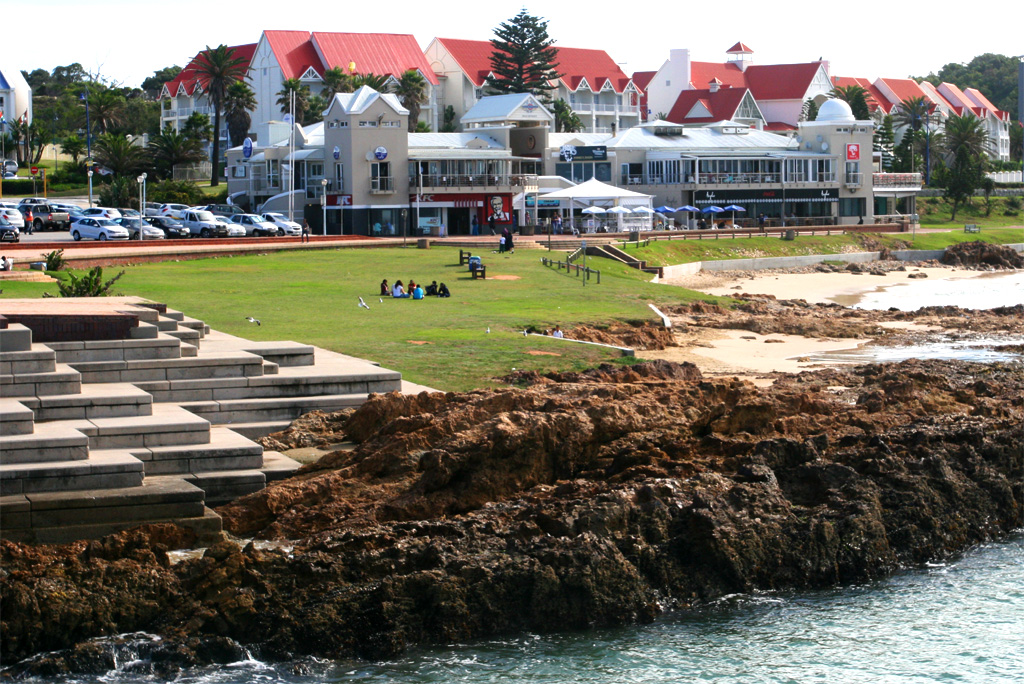
| Looking from the pier down to my favorite restaurant
|
My favorite restaurant was the Blue Wave. Sitting on the terrace, eating a "Fish Board" (4.00 Euro), while watching the ships in the sea and the people jogging along the boardwalk in the evening sun. What a wonderful time. After that I strolled not along but through the Boardwalk, which is an open mall beside the Baywalk Hotel.
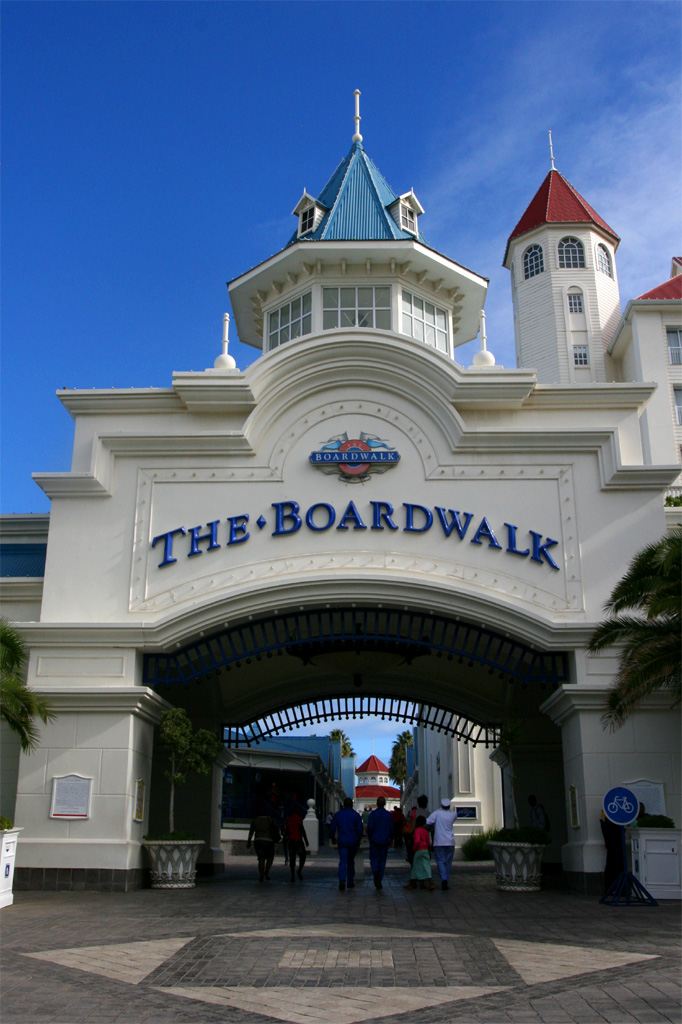
| Entrance of the Boardwalk Mall
|
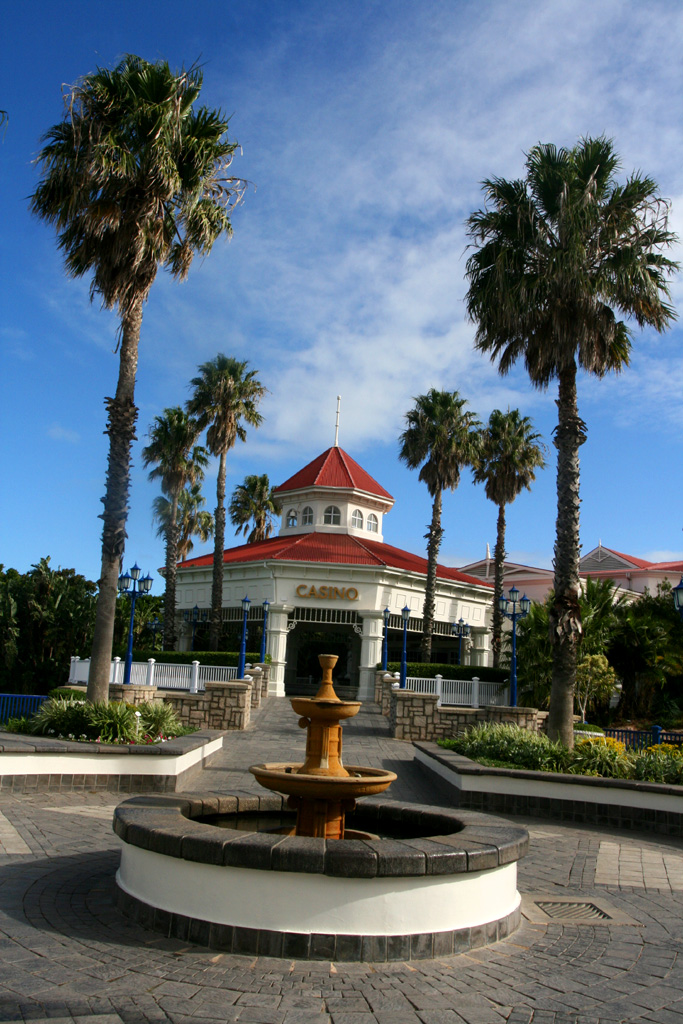
| Entrance of the Casino
|
Just around the corner of the Longile was the Bayworld, which contains a very interesting museum with many stuffed marine creatures and replicas of dinosaurs beside a snake park and and last not least a small oceanarium, where just a trained seal and penguin show took place. That was probably the most interesting part for the little kids.
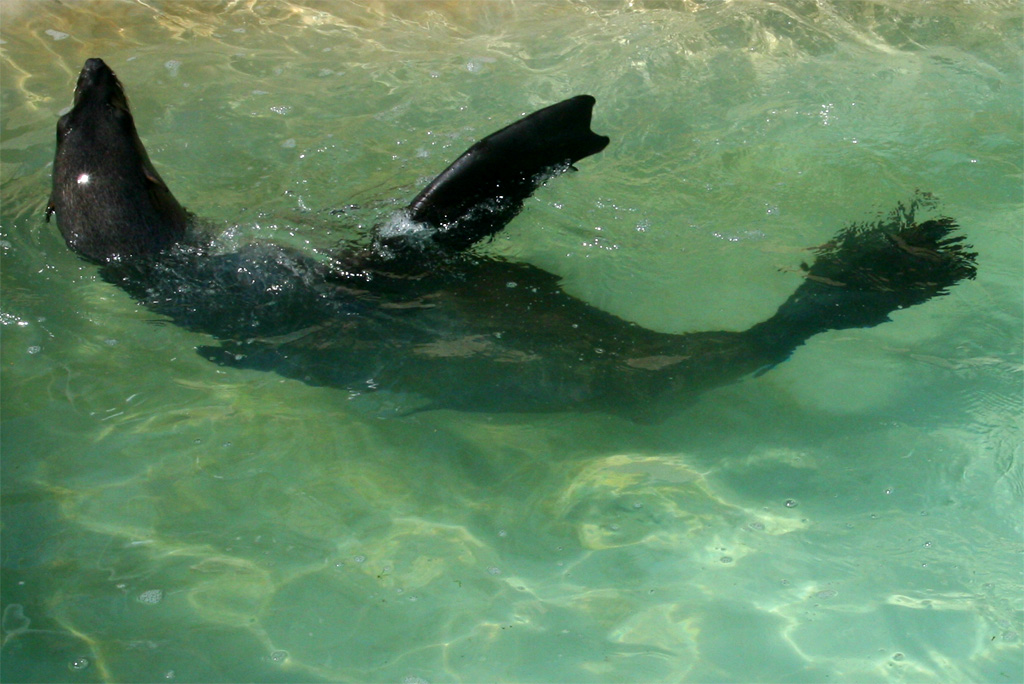
| A seal in Bayworld
|
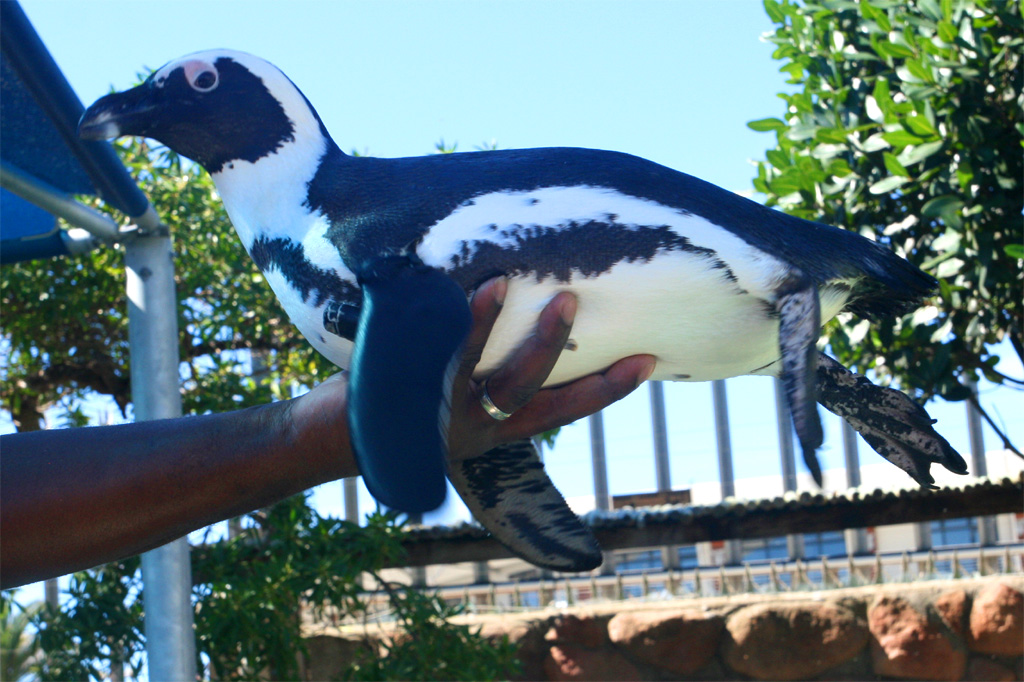
| A penguin in Bayworld
|
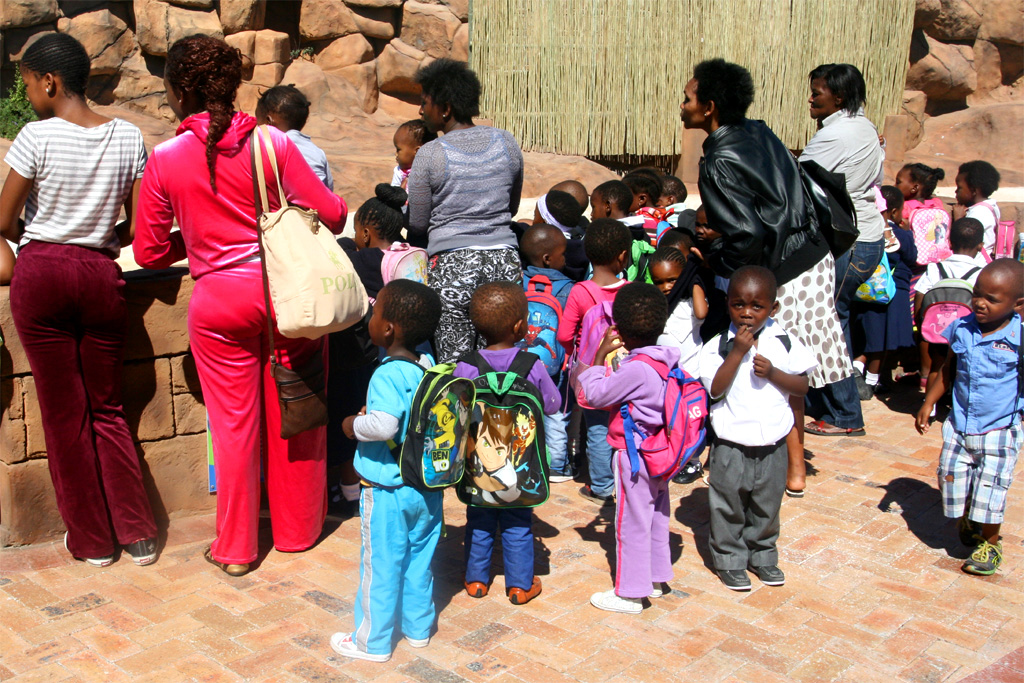
| Being watched by kindergarden kids
|
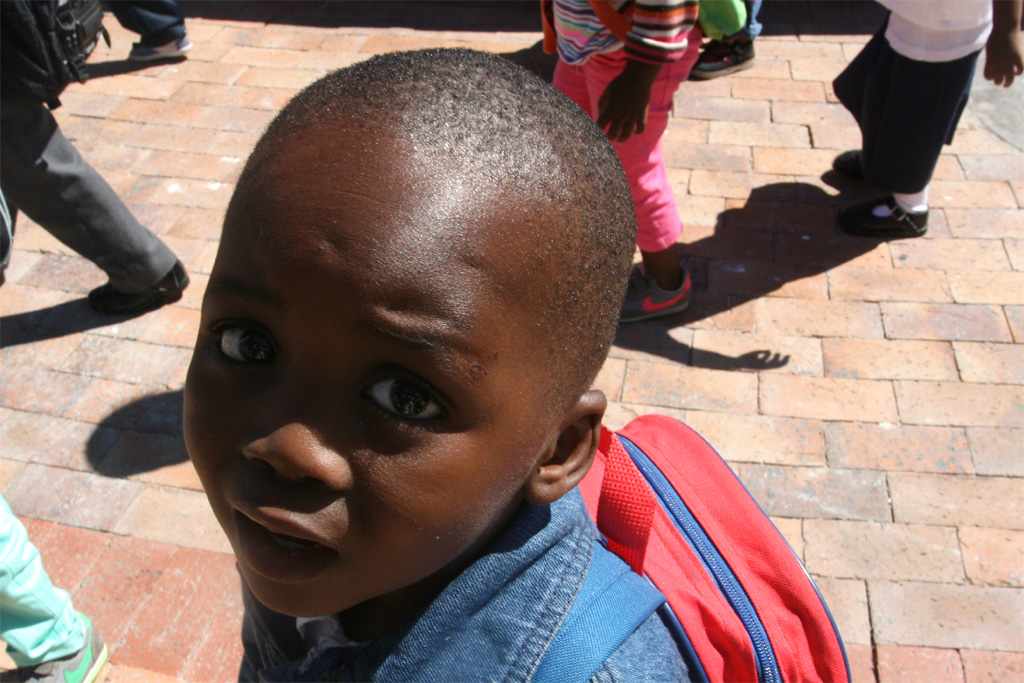
| I am being watched, too
|
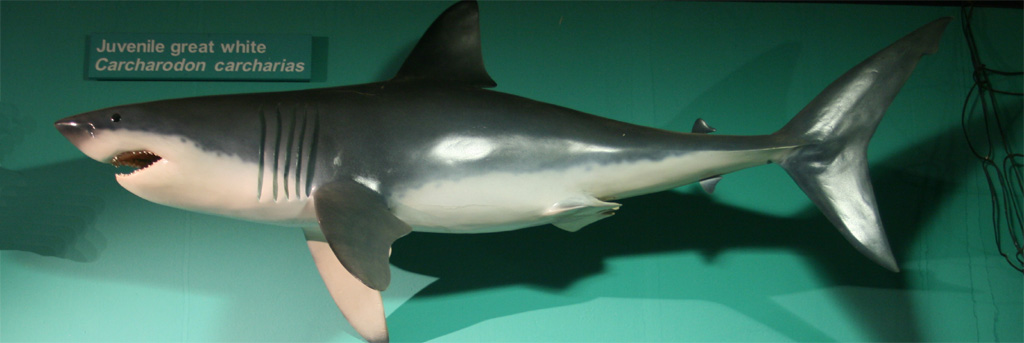
| A white shark. I do not eat him but he eats maybe me
|
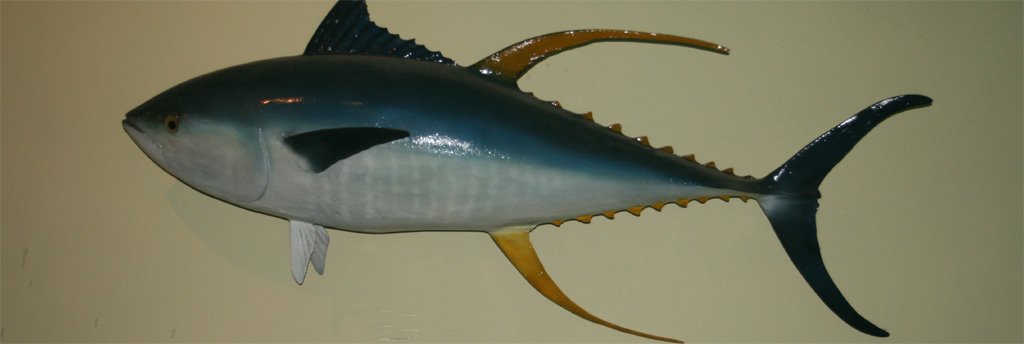
| A yellow fin tuna I like to eat but more the red one which is not cheap
|

| A black marlin is my favorite fish to eat
|
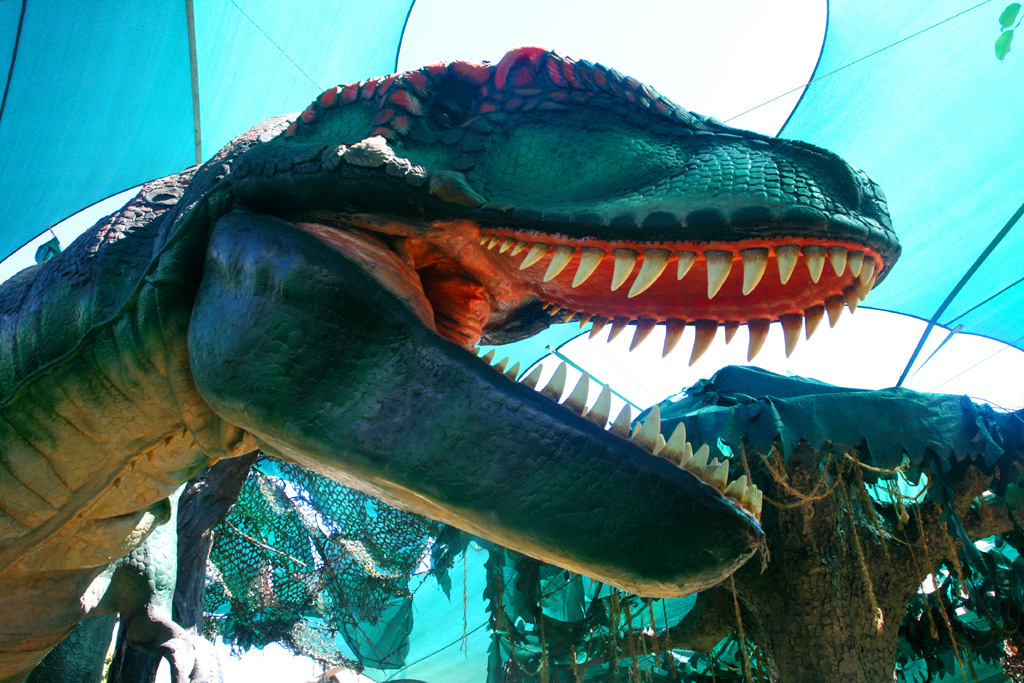
| A dinosaur design
|
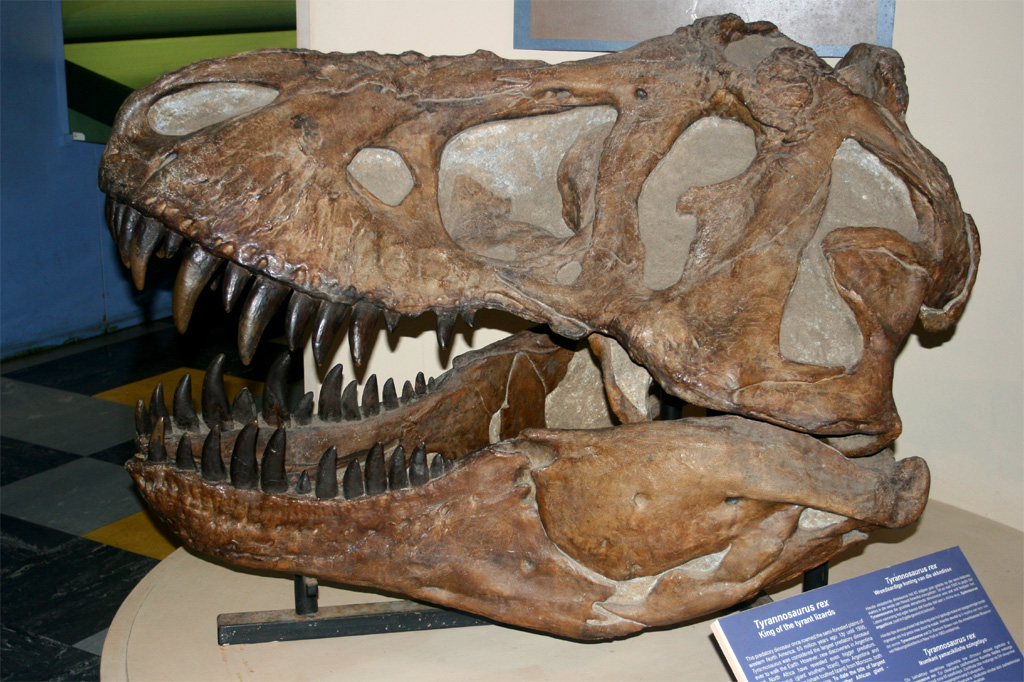
| A dinosaur head replica
|
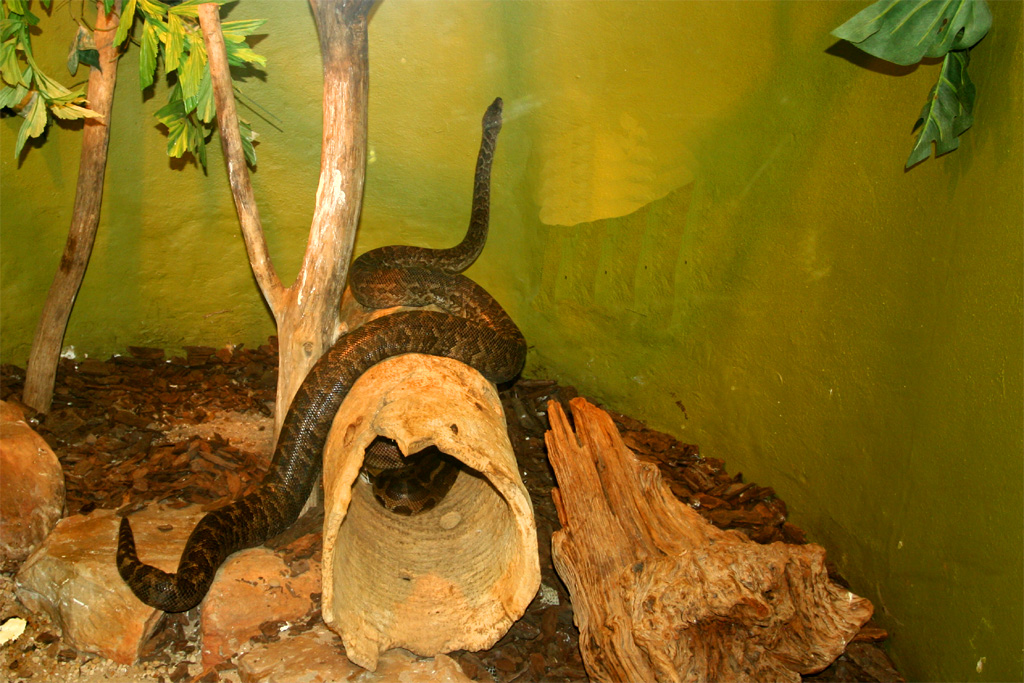
| Is this a brown or black mamba?
|
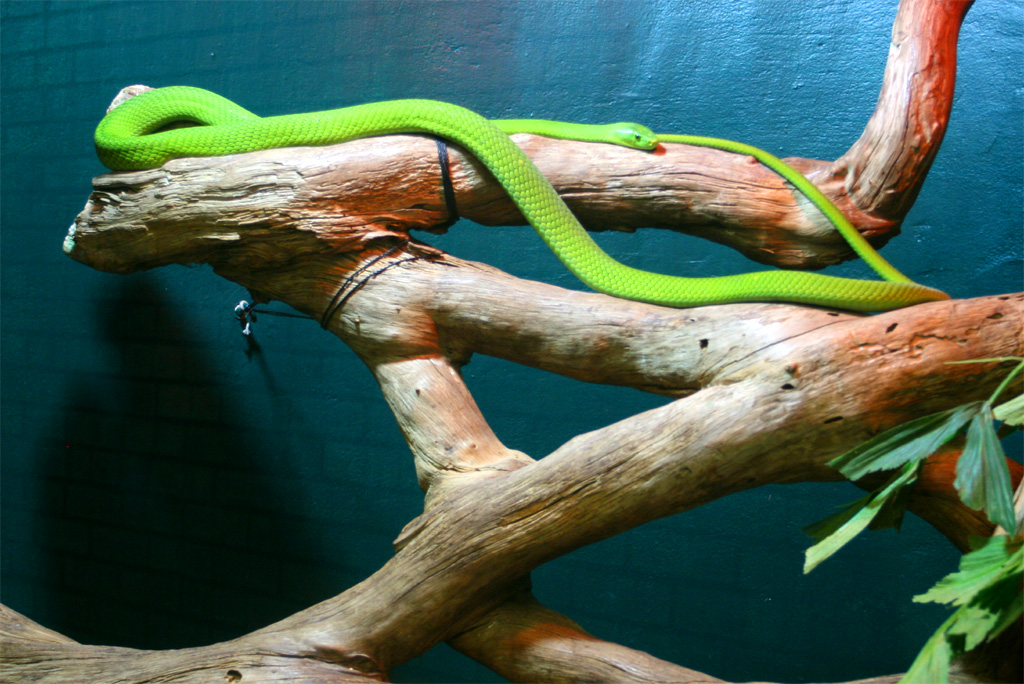
| This is definitely a green mamba
|
This was the end of the Garden Route. I could have continued along the coast until Durban (even long way after) but my time was limited, so I had already decided before my trip to South Africa that I will fly back to Johannesburg from Port Elisabeth. I booked the flight online with South African Airways six weeks before for 93.00 Euro.
The departure time was 12:55. The lady from the Longile called a taxi for me and advised that I should only pay 3.40 Euro, because that was the price negotiated between the taxi company and the hostel. The taxi driver didn't try to demand more than that after we arrived at the airport. And we arrived very early, so I had plenty of time to eat an "Urban Energy" breakfast with a Cappuccino at the Primi-Piatti Caffe for 5.10 Euro.
Then I strolled around the airport to look for a secluded ATM to withdraw enough money to pay in cash at my next accommodation, but not for my accommodation (that was for free), but for the safari trip to the Kruger National Park. You may continue now by hitting
Johannesburg. But before you do that, please take a look at Port Elisabeth from above.
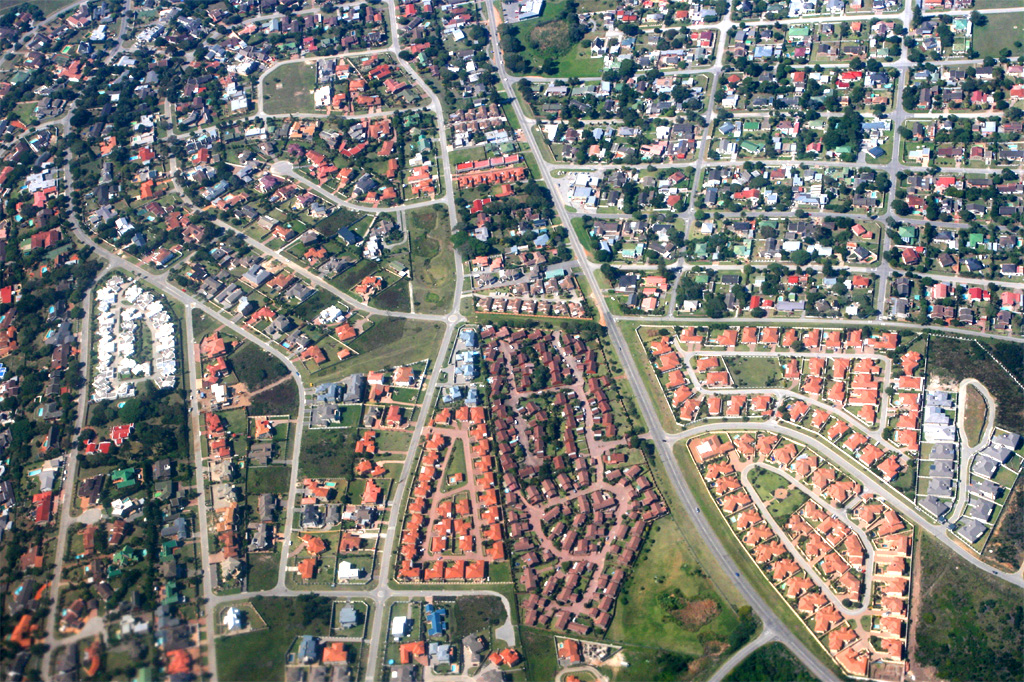
| Flying over Port Elisabeth
|
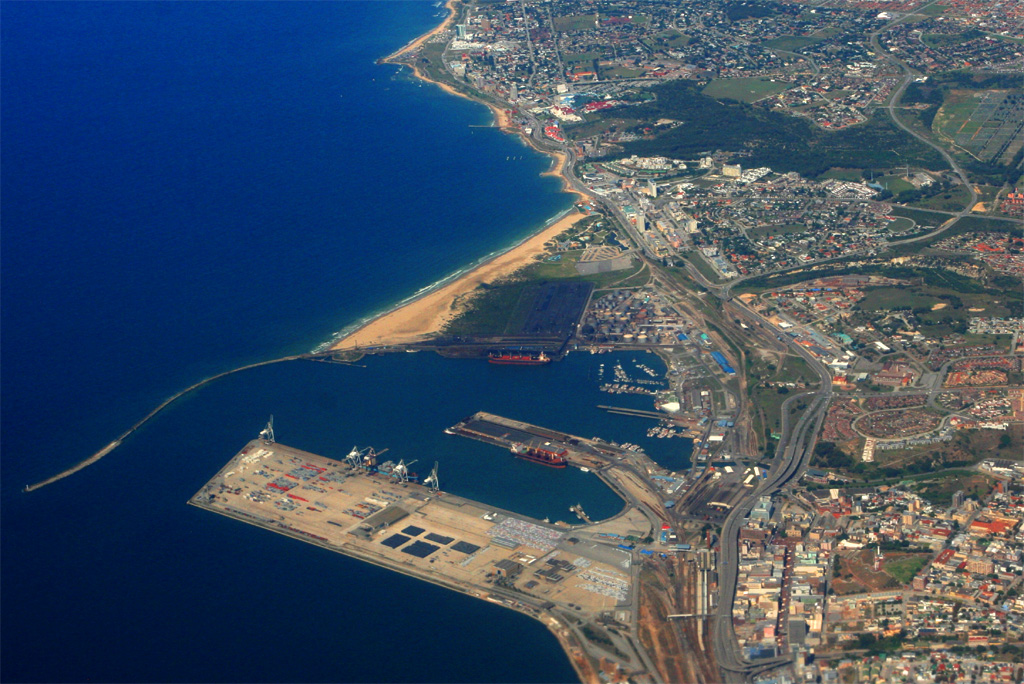
| with the harbor and the baywalk (up north) down below
|
Ok, that was the Garden Route.
As it was said before and will be said again: There could have been seen and done a lot more. Also I could have written more. If you want to know more all about the places I have visited, then just look up any of the many guidebooks or in the internet.
If you want to link to the other parts from here then just click on
Part I - Cape Town or
Part III - Johannesburg or
Part IV - Kruger National Park .
| 















































































































































